Paul van Yperen's Blog, page 95
February 25, 2023
Photo by Riccardo Bettini - bis
Twice before, EFSP did a post about the wonderful, sepia postcards by Roman publisher Edizione Sociéta Anonima Italiana Bettini. Cavaliere Dottore Riccardo Bettini was the photographer for all postcards. In Italy, Museo di Roma has a large collection of his original negatives. Many pictures of changing Rome in the first decades of the 20th Century when old buildings were replaced by new ones. Bettini also made portraits of the Italian royal family, the House of Savoy, but not so many of the film actors which were used for the postcards. Ivo Blom figured when the postcard series must be made. Among the stars were one-day wonders too, like Jolanda Joldi. She made only three films and two in 1916 and one in 1917, so the cards probably date from 1916. Ivo selected for this post 19 Bettini postcards you did not see here before.
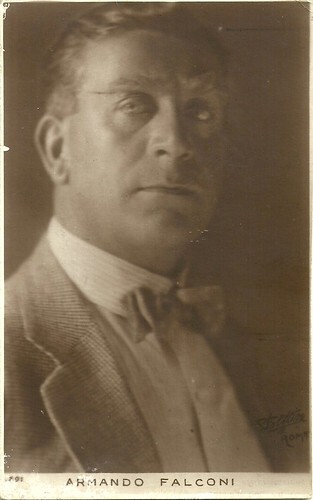
Italian postcard by Ed. Soc. Anon. Bettini, Roma, no. 91. Photo: Riccardo Bettini, Roma.
Armando Falconi (1871-1954) was an Italian stage and screen actor. Though he was foremost a theatre actor and comedian, he had a prolific career as comedian in Italian cinema of the 1930s and early 1940s.
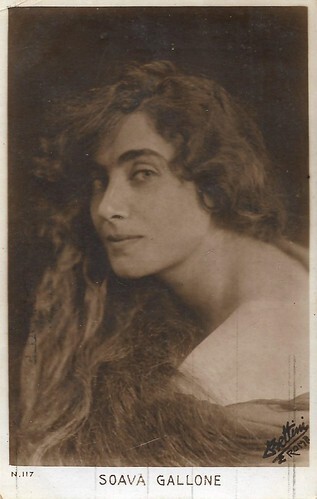
Italian postcard by Ed. Soc. Anon. Bettini, Roma, no. 117. Photo: Riccardo Bettini, Roma.
Polish actress Soava Gallone (1880-1957) was one of the divas of the Italian silent cinema.
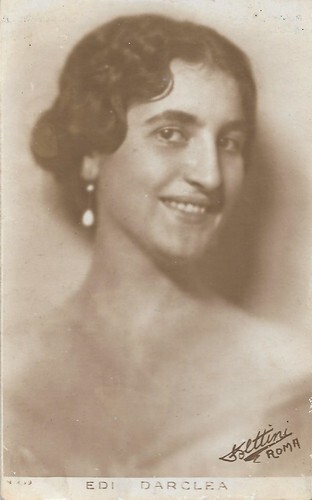
Italian postcard by Ed. Soc. Anon. Bettini, Roma, no. 119. Photo: Riccardo Bettini, Roma.
Edy Darclea (1895-?) was an Italian actress who was active in Italian and foreign silent cinema in the late 1910s and early 1920s.
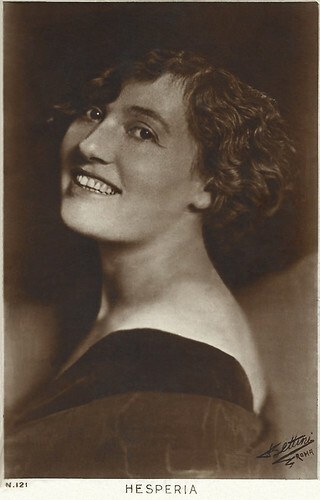
Italian postcard by Ed. Soc. Anon. Bettini, Roma, no. 121. Photo: Riccardo Bettini, Roma.
Hesperia (1885-1959), was one of the Italian divas of the silent screen. She often worked with director Baldassarre Negroni, who later became her husband.
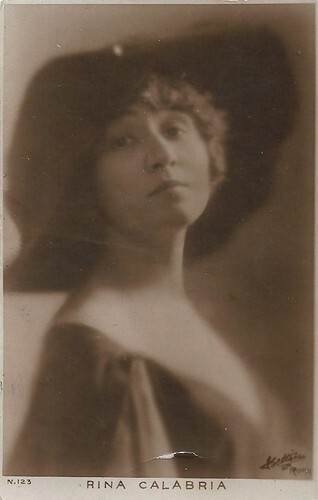
Italian postcard by Ed. Soc. Anon. Bettini, Roma, no. 123. Photo: Riccardo Bettini, Roma.
Rina Calabria (?-?) was an Italian silent film actress, who mostly had supporting parts, first at Cines (1915), and afterward, more frequently, at Tespi-Film and Bernini-Film (1917-1921).
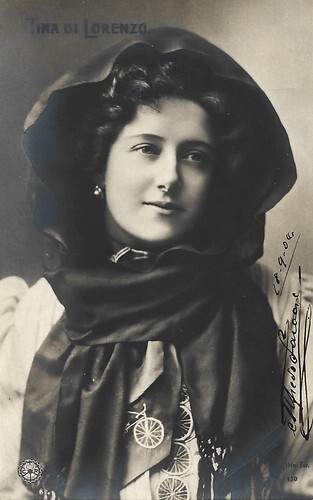
Italian postcard by TCR, no. 130. Photo: Riccardo Bettini.
Tina Di Lorenzo (1872-1930) was one of the 'grandes dames' of the Italian stage during the early twentieth century, nicknamed "Angelicata" and "La encantadora". In 1915 she also acted in two or three films. In 1901 she married reputed stage actor Armando Falconi, who would have a second career in Italian sound cinema.
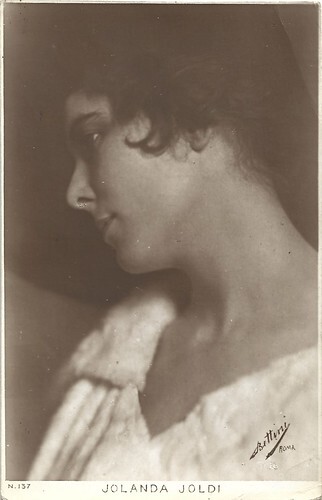
Italian postcard by Ed. Soc. Anon. Bettini, Roma, no. 137. Photo: Riccardo Bettini.
Jolanda Yoldy, aka Jolanda Joldi (?-?), was an Italian silent film actress, who acted in only three films. She debuted in early 1916 in a supporting part in the film Pierrette ne fa una delle sue (Felice Metellio, 1916). As the two leading actresses came from Vaudeville, this may have been the background of Yoldy too. She then had the lead as an innocent young girl opposite Ugo Gracci as a ruthless womanizer in Il sogno di un giorno (1916) by Augusto Genina. After losing her beloved, a mechanic, she falls into the clutches of a rich spender who abuses her. The film, even if of medium length only, looked promising, the Spanish press wrote in 1916. Yet, Yoldy had her last role the following year, a supporting part in the Suzanne Armelle vehicle Il fango (Adelardo Fernández Arias, 1917).
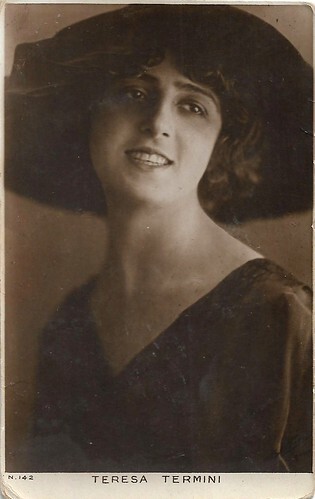
Italian postcard by Ed. Soc. Anon. Bettini, Roma, no. 142. Photo: Riccardo Bettini.
Thea or Théa, originally Teresa Termini (1898-?), debuted in Italian silent film with the film I Martiri di Belfiore (Alberto Carlo Lolli, 1915), a patriottic and anti-Austrian period piece, set in Mantova 1851. The leads were played by Enna Saredo and Achille Vitti, Teresa had only a minor part. In 1916 Thea had only one role in L'albergo nero (1920). So after I Martiri di Belfiore it took two years before she was again visible on the screen in Il segreto di Jack (Henrique Santos, 1917), in which Termini used her nom de plume Thea for the first time and in which she had the lead opposite a monkey called Jack.
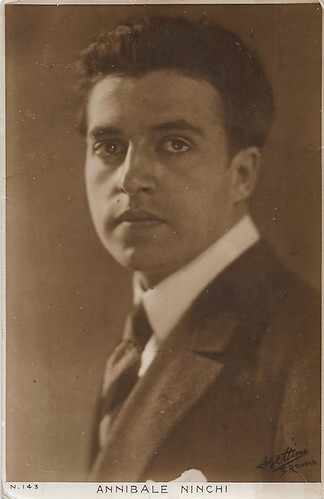
Italian postcard by Ed. Soc. Anon. Bettini, Roma, no. 143. Photo: Riccardo Bettini.
Annibale Ninchi (1889-1967) was an Italian stage and screen actor and playwright, who became famous as the title character in Scipione l’Africano (1937) but also as the father in Fellini’s La dolce vita (1960) and 8½ (1963).
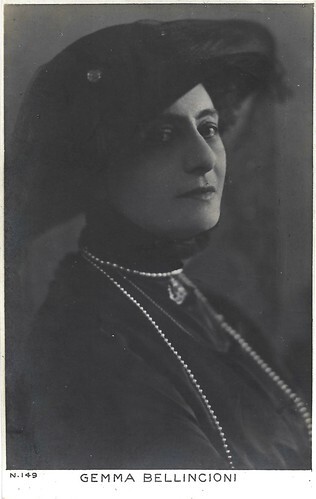
Italian postcard by Ed. Soc. Anon. Bettini, Roma, no. 149. Photo: Riccardo Bettini.
Gemma Bellincioni (1864-1950) was one of the best-known sopranos of the late 19th century. She emerged for her interpretations of the Italian veristic repertoire and was particularly known more for her acting skills than for the quality of her voice.
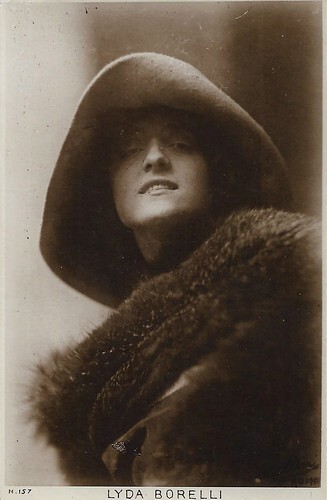
Italian postcard by Ed. Soc. Anon. Bettini, Roma, no. 157. Photo: Riccardo Bettini.
Lyda Borelli (1887-1959) was already an acclaimed stage actress before she became the first diva of the Italian silent cinema. The fascinating film star caused a craze among female fans called 'Borellismo'.
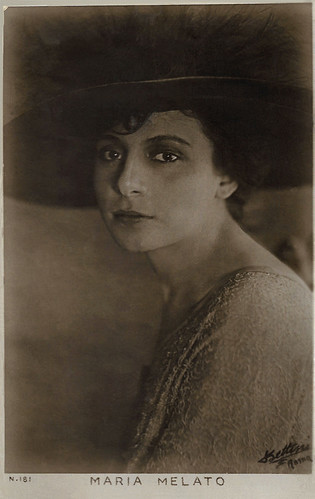
Italian postcard by Ed. Soc. Anon. It. Bettini, Roma, no. 181. Photo: Riccardo Bettini.
Italian actress Maria Melato (1885-1950) appeared in the theatre, on the radio, and in the cinema. Her films included Ritorno/Return (1914), Anna Karenina (1917), and Il volo degli aironi/The flight of the herons (1920). Unfortunately, all her films are considered lost.
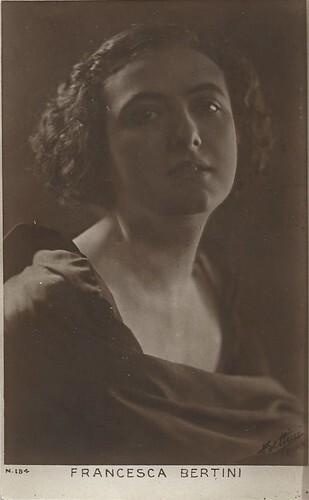
Italian postcard by Ed. Soc. Anon. Bettini, Roma, no. 184. Photo: Riccardo Bettini.
During the first quarter of the twentieth century, Francesca Bertini (1892-1985) was a majestic diva of the Italian silent cinema. She often played the 'femme fatale', with men devouring eyes, glamorous attire, clenched fists, and in opulent settings...
<
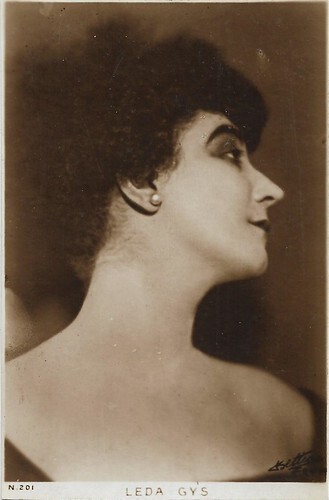
Italian postcard by Ed. Società Anonima Bettini, Roma, no. 201. Photo: Riccardo Bettini.
Italian film diva Leda Gys (1892-1957) starred in ca. 60 dramas, comedies, action thrillers and even westerns of the Italian and Spanish silent cinema. Her claim to fame came with the film Christus (1916), shot in Egypt and Palestine, where Gys performed the Madonna.
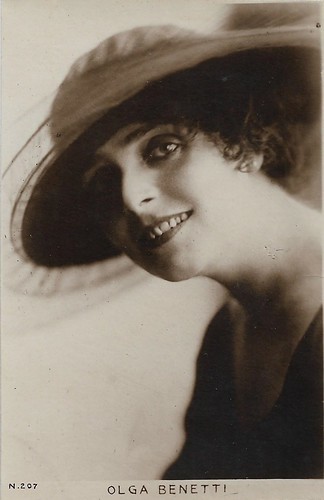
Italian postcard by Ed. Società Anonima Bettini, Roma, no. 207. Photo: Riccardo Bettini.
Olga Benetti (?-1958) was an Italian actress who acted in many films of the Roman film companies Cines, Celio and Caesar in the 1910s and early 1920s. She often performed opposite Francesca Bertini, Gustavo Serena and her husband Carlo Benetti (1885-1949).
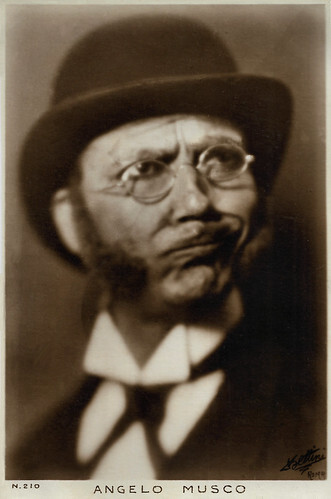
Italian postcard by Ed. Società Anonima Bettini, no. 210. Photo: Bettini, Roma.
Angelo Musco (1872–1937) was an Italian stage and screen actor. He was known for his comic abilities as well as for his carefully drawn psychological portraits. His film San Giovanni Decollato (Telemaco Ruggeri, 1917) was based on a play by Nino Martoglio which Martoglio had specially written for Musco. All the actors in the play repeated their roles in Ruggeri's film. Martoglio scripted the film too.
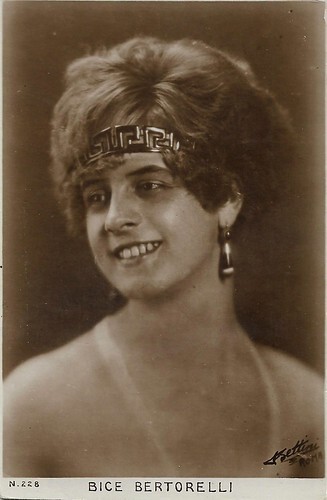
Italian postcard by Ed. Società Anonima Bettini, no. 228. Photo: Bettini, Roma.
According to IMDb and the reference books by Vittorio Martinelli, 'Il cinema muto italiano', Bice Bertorelli may not have been a film actress. Yet, the postcard series in which she appears is one of Italian film stars of the 1910s and 1920s. There is even doubt whether she has been a stage actress. Was she perhaps only a young Roman woman who just wanted to be portrayed like a star? Who knows more?
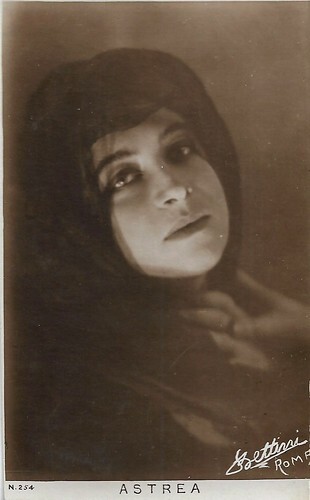
Italian postcard by Ed. Società Anonima Bettini, no. 254. Photo: Bettini, Roma.
Astrea (?-?) was the enigmatic female ‘forzuto’ of Italian silent cinema.
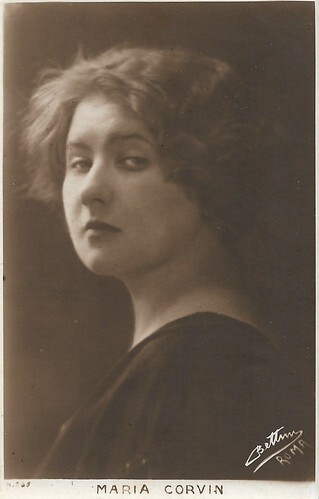
Italian postcard by Ed. Società Anonima Bettini, Roma, no. 265. Photo: Riccardo Bettini.
Mary Corwyn aka Mary Corwin and Maria Corvin (1895-?) was a Polish actress, active in Italian silent film. In 1916 she was hired by the Neapolitan film company Polifilms, where she acted in 7 films directed by Giulio Antamoro, and distributed by Lombardo Film. She became 'first actress' at Polifilm, thanks to her blue eyes and photogenic qualities. In 1918 journalist Edoardo Scarfoglio brought her to writer-producer-actor Lucio d'Ambra, who hired for his Roman film company Do-Re-Mi. She debuted there in Napoleoncina/L'épopée de Napoléonnette (D'Ambra, 1918), on a young girl smitten with Napoleon and his modern lookalike Dr. Toccasana. After four more films with D'Ambra, Corwyn returned to Naples for one more film, the Balzac adaptation Vautrin (1919). She then returned to act in Il girotondo degli undici lancieri (D'Ambra, 1919), produced by the new company D'Ambra Films. After two more films at Cines and Rosa Films, Corwyn left Italy in 1920, and nothing more is known of her.

Italian postcard by Ed. Soc. Anon. Bettini, Roma, no. 91. Photo: Riccardo Bettini, Roma.
Armando Falconi (1871-1954) was an Italian stage and screen actor. Though he was foremost a theatre actor and comedian, he had a prolific career as comedian in Italian cinema of the 1930s and early 1940s.

Italian postcard by Ed. Soc. Anon. Bettini, Roma, no. 117. Photo: Riccardo Bettini, Roma.
Polish actress Soava Gallone (1880-1957) was one of the divas of the Italian silent cinema.

Italian postcard by Ed. Soc. Anon. Bettini, Roma, no. 119. Photo: Riccardo Bettini, Roma.
Edy Darclea (1895-?) was an Italian actress who was active in Italian and foreign silent cinema in the late 1910s and early 1920s.

Italian postcard by Ed. Soc. Anon. Bettini, Roma, no. 121. Photo: Riccardo Bettini, Roma.
Hesperia (1885-1959), was one of the Italian divas of the silent screen. She often worked with director Baldassarre Negroni, who later became her husband.

Italian postcard by Ed. Soc. Anon. Bettini, Roma, no. 123. Photo: Riccardo Bettini, Roma.
Rina Calabria (?-?) was an Italian silent film actress, who mostly had supporting parts, first at Cines (1915), and afterward, more frequently, at Tespi-Film and Bernini-Film (1917-1921).

Italian postcard by TCR, no. 130. Photo: Riccardo Bettini.
Tina Di Lorenzo (1872-1930) was one of the 'grandes dames' of the Italian stage during the early twentieth century, nicknamed "Angelicata" and "La encantadora". In 1915 she also acted in two or three films. In 1901 she married reputed stage actor Armando Falconi, who would have a second career in Italian sound cinema.

Italian postcard by Ed. Soc. Anon. Bettini, Roma, no. 137. Photo: Riccardo Bettini.
Jolanda Yoldy, aka Jolanda Joldi (?-?), was an Italian silent film actress, who acted in only three films. She debuted in early 1916 in a supporting part in the film Pierrette ne fa una delle sue (Felice Metellio, 1916). As the two leading actresses came from Vaudeville, this may have been the background of Yoldy too. She then had the lead as an innocent young girl opposite Ugo Gracci as a ruthless womanizer in Il sogno di un giorno (1916) by Augusto Genina. After losing her beloved, a mechanic, she falls into the clutches of a rich spender who abuses her. The film, even if of medium length only, looked promising, the Spanish press wrote in 1916. Yet, Yoldy had her last role the following year, a supporting part in the Suzanne Armelle vehicle Il fango (Adelardo Fernández Arias, 1917).

Italian postcard by Ed. Soc. Anon. Bettini, Roma, no. 142. Photo: Riccardo Bettini.
Thea or Théa, originally Teresa Termini (1898-?), debuted in Italian silent film with the film I Martiri di Belfiore (Alberto Carlo Lolli, 1915), a patriottic and anti-Austrian period piece, set in Mantova 1851. The leads were played by Enna Saredo and Achille Vitti, Teresa had only a minor part. In 1916 Thea had only one role in L'albergo nero (1920). So after I Martiri di Belfiore it took two years before she was again visible on the screen in Il segreto di Jack (Henrique Santos, 1917), in which Termini used her nom de plume Thea for the first time and in which she had the lead opposite a monkey called Jack.

Italian postcard by Ed. Soc. Anon. Bettini, Roma, no. 143. Photo: Riccardo Bettini.
Annibale Ninchi (1889-1967) was an Italian stage and screen actor and playwright, who became famous as the title character in Scipione l’Africano (1937) but also as the father in Fellini’s La dolce vita (1960) and 8½ (1963).

Italian postcard by Ed. Soc. Anon. Bettini, Roma, no. 149. Photo: Riccardo Bettini.
Gemma Bellincioni (1864-1950) was one of the best-known sopranos of the late 19th century. She emerged for her interpretations of the Italian veristic repertoire and was particularly known more for her acting skills than for the quality of her voice.

Italian postcard by Ed. Soc. Anon. Bettini, Roma, no. 157. Photo: Riccardo Bettini.
Lyda Borelli (1887-1959) was already an acclaimed stage actress before she became the first diva of the Italian silent cinema. The fascinating film star caused a craze among female fans called 'Borellismo'.

Italian postcard by Ed. Soc. Anon. It. Bettini, Roma, no. 181. Photo: Riccardo Bettini.
Italian actress Maria Melato (1885-1950) appeared in the theatre, on the radio, and in the cinema. Her films included Ritorno/Return (1914), Anna Karenina (1917), and Il volo degli aironi/The flight of the herons (1920). Unfortunately, all her films are considered lost.

Italian postcard by Ed. Soc. Anon. Bettini, Roma, no. 184. Photo: Riccardo Bettini.
During the first quarter of the twentieth century, Francesca Bertini (1892-1985) was a majestic diva of the Italian silent cinema. She often played the 'femme fatale', with men devouring eyes, glamorous attire, clenched fists, and in opulent settings...
<

Italian postcard by Ed. Società Anonima Bettini, Roma, no. 201. Photo: Riccardo Bettini.
Italian film diva Leda Gys (1892-1957) starred in ca. 60 dramas, comedies, action thrillers and even westerns of the Italian and Spanish silent cinema. Her claim to fame came with the film Christus (1916), shot in Egypt and Palestine, where Gys performed the Madonna.

Italian postcard by Ed. Società Anonima Bettini, Roma, no. 207. Photo: Riccardo Bettini.
Olga Benetti (?-1958) was an Italian actress who acted in many films of the Roman film companies Cines, Celio and Caesar in the 1910s and early 1920s. She often performed opposite Francesca Bertini, Gustavo Serena and her husband Carlo Benetti (1885-1949).

Italian postcard by Ed. Società Anonima Bettini, no. 210. Photo: Bettini, Roma.
Angelo Musco (1872–1937) was an Italian stage and screen actor. He was known for his comic abilities as well as for his carefully drawn psychological portraits. His film San Giovanni Decollato (Telemaco Ruggeri, 1917) was based on a play by Nino Martoglio which Martoglio had specially written for Musco. All the actors in the play repeated their roles in Ruggeri's film. Martoglio scripted the film too.

Italian postcard by Ed. Società Anonima Bettini, no. 228. Photo: Bettini, Roma.
According to IMDb and the reference books by Vittorio Martinelli, 'Il cinema muto italiano', Bice Bertorelli may not have been a film actress. Yet, the postcard series in which she appears is one of Italian film stars of the 1910s and 1920s. There is even doubt whether she has been a stage actress. Was she perhaps only a young Roman woman who just wanted to be portrayed like a star? Who knows more?

Italian postcard by Ed. Società Anonima Bettini, no. 254. Photo: Bettini, Roma.
Astrea (?-?) was the enigmatic female ‘forzuto’ of Italian silent cinema.

Italian postcard by Ed. Società Anonima Bettini, Roma, no. 265. Photo: Riccardo Bettini.
Mary Corwyn aka Mary Corwin and Maria Corvin (1895-?) was a Polish actress, active in Italian silent film. In 1916 she was hired by the Neapolitan film company Polifilms, where she acted in 7 films directed by Giulio Antamoro, and distributed by Lombardo Film. She became 'first actress' at Polifilm, thanks to her blue eyes and photogenic qualities. In 1918 journalist Edoardo Scarfoglio brought her to writer-producer-actor Lucio d'Ambra, who hired for his Roman film company Do-Re-Mi. She debuted there in Napoleoncina/L'épopée de Napoléonnette (D'Ambra, 1918), on a young girl smitten with Napoleon and his modern lookalike Dr. Toccasana. After four more films with D'Ambra, Corwyn returned to Naples for one more film, the Balzac adaptation Vautrin (1919). She then returned to act in Il girotondo degli undici lancieri (D'Ambra, 1919), produced by the new company D'Ambra Films. After two more films at Cines and Rosa Films, Corwyn left Italy in 1920, and nothing more is known of her.
Published on February 25, 2023 22:00
February 24, 2023
Mel Gibson
American-Australian actor Mel Gibson (1956) became known worldwide thanks to the small-budgeted action film Mad Max (1979). He went on to star in such acclaimed films as Gallipoli (1981) and The Bounty (1984). In 1987, he became a superstar with the buddy cop action-comedy film series Lethal Weapon (1987-1998). As director of Braveheart (1995), he won both the Academy Award for best director and best film. Gibson also produced and directed The Passion of the Christ (2004) about the last phase of Jesus Christ's life on earth.
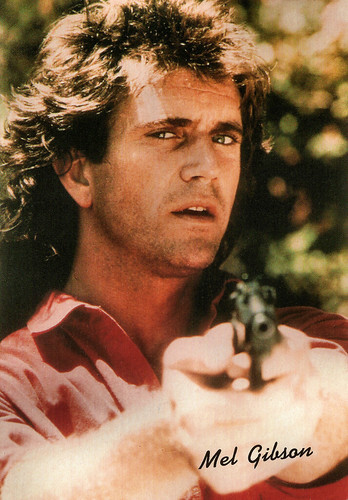
British postcard by Box Office, no. BO 1112. Mel Gibson in Lethal Weapon (Richard Donner, 1987).
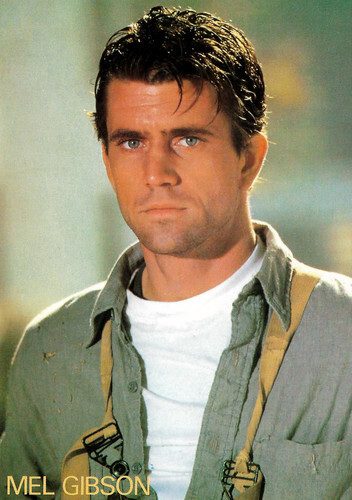
French postcard by Editions Spiral Rock, no. Réf. SP 36. Mel Gibson in The River (Mark Rydell, 1984).
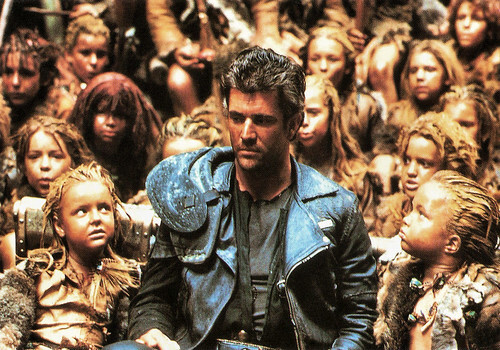
French postcard by Editions F. Nugeron, no. 4. Photo: Collection de l'Ecole de Cinéma Camiris. Mel Gibson in Mad Max Beyond Thunderdome (George Miller, George Ogilvie, 1985).
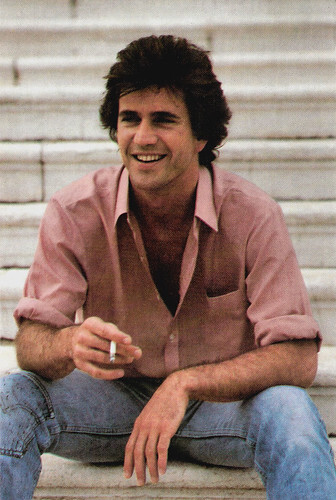
British postcard by Heroes, London, no. PC504.

Vintage postcard Photo: Twentieth Century Fox Film Corporation, 1995. Mel Gibson in Braveheart (Mel Gibson, 1995).
The Australian New Wave
Mel Columcille Gerard Gibson was born in 1956 in Peekskill, New York, USA. He was the sixth of eleven children of Hutton Gibson, a railroad brakeman, and Anne Patricia (Reilly) Gibson. His mother was Irish, from County Longford, while his American-born father is of mostly Irish descent.
His father moved the family from upstate New York to Sydney, New South Wales, Australia, in 1968 after winning as a contestant on the game show Jeopardy! The family settled in New South Wales, where Mel's paternal grandmother, contralto opera singer Eva Mylott, was born. Mel only developed an Aussie accent after his classmates teased him for his American tongue.
Though he had, at one point, set his sights on journalism, Gibson caught the acting bug by the time he had reached college age and studied at the National Institute of Dramatic Art in Sydney, Australia. There he performed with future film thespians Judy Davis and Geoffrey Rush and starred opposite Judy Davis in a production of 'Romeo and Juliet'. Gibson was still a student when he made his film debut in the low-budget Australian teen drama Summer City (Christopher Fraser, 1976) and it didn't take long before he found work playing supporting roles for the South Australia Theatre Company after his graduation. Mel also starred in TV shows.
Eventually, he was chosen to star as a leather-clad post-apocalyptic cop in Mad Max (George Miller, 1979) and as a mildly retarded handyman in Tim (Michael Pate, 1979), co-starring Piper Laurie . The small-budgeted Mad Max made him known worldwide, while Tim garnered the then 22-year-old Gibson a Sammy award for Best Actor from the Australian Film Institute, the Australian equivalent to the Oscar. Gibson wouldn't become internationally famous, however, until after his performance in Mad Max 2 (George Miller, 1981), one of the few sequels to have proved superior to its predecessor.
Gibson got a reputation as a serious, versatile actor. He was a part of the movement dubbed the 'Australian New Wave' by the press. They were a group of filmmakers and performers who emerged from Down Under at about the same time and found work in other parts of the world. Other members included actress Judy Davis and directors George Miller, Gillian Armstrong and Peter Weir. In 1980, he married Robyn Moore and they had seven children.
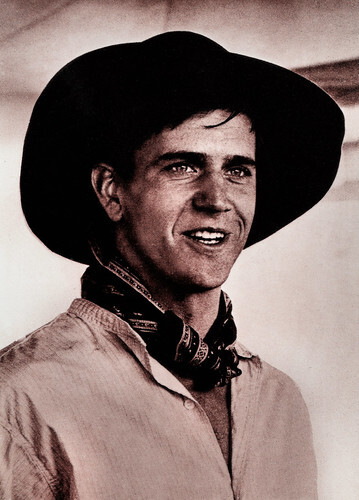
Spanish postcard by Foto Parjetas, Madrid, no. PC 169-50. Mel Gibson in Gallipoli (Peter Weir, 1981).
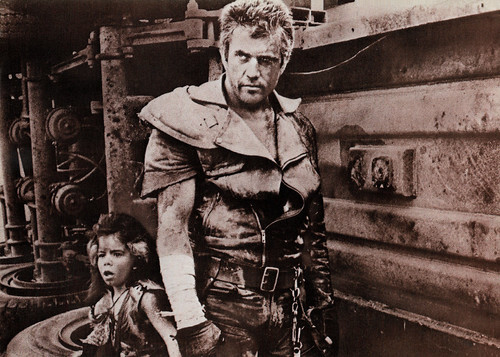
Spanish postcard by Foto Parjetas, Madrid, no. FC 154-50. Mel Gibson and Emil Minty in Mad Max 2 (George Miller, 1981).
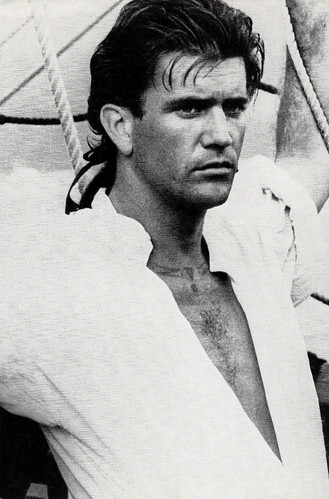
French postcard by Ebullitions, no. 82. Mel Gibson in The Bounty (Roger Donaldson, 1984).
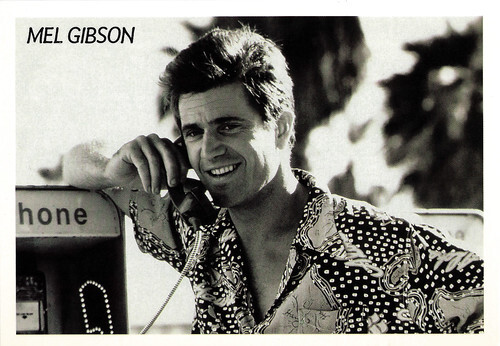
French postcard by Edition RF, Réf. 206. Mel Gibson in Tequila Sunrise (Robert Towne, 1988).
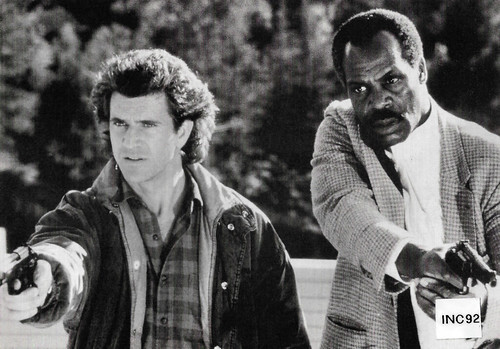
French postcard, no. INC 92. Mel Gibson and Danny Glover in Lethal Weapon (Richard Donner, 1989).
The highest-paid celebrity
Mel Gibson went on to star in the powerful WWI World War I drama Gallipoli (Peter Weir, 1981), which earned him a second award for Best Actor from the AFI. He reunited with Weir for The Year of Living Dangerously (Peter Weir, 1983), in which he played a callous reporter responsible for covering a bloody Indonesian coup opposite Sigourney Weaver. In 1984, Mel made his American debut in The Bounty (Roger Donaldson, 1984), which co-starred Anthony Hopkins. That same year, he starred opposite Sissy Spacek in The River (Mark Rydell, 1984). He would also star in Mad Max Beyond Thunderdome (1985) alongside singer Tina Turner.
After the third instalment to the Mad Max franchise, Gibson took a two-year break. Then in 1987, Mel starred in what would become his signature series, Lethal Weapon (Richard Donner, 1987), opposite Danny Glover. The role featured Gibson as Martin Riggs, a volatile police officer reeling from the death of his wife, and cemented a spot as one of Hollywood's premier action stars. In 1990, he took on the starring role in Hamlet (Franco Zeffirelli, 1990) with Glenn Close, which garnered him some critical praise. He also made the more endearing Forever Young (Steve Miner. 1992) with Jamie Lee Curtis and the somewhat disturbing The Man Without a Face (Mel Gibson, 1993)in which he played a horrifically burned teacher harbouring a secret.
He played his most famous role as Sir William Wallace in Braveheart (Mel Gibson, 1995). Gibson swept the Oscars including those for Best Picture and Best Director with his epic account of 13th-century Scottish leader William Wallace's lifelong struggle to forge an independent nation. From there, he made such box office hits as Ransom (Ron Howard, 1996), Payback (Brian Helgeland, 1999) and The Patriot (Roland Emmerich, 2000). His later films include Signs (M. Night Shyamalan, 2002), and Edge of Darkness (Martin Campbell, 2010).
For The Passion of the Christ (2004), which he directed, wrote and produced, he spent 25 million dollars of his own money. Back in 1992, he started doing research for the film that was not released until 2004. That year, he was the highest-paid celebrity with a reported $210,000,000 salary from his The Passion of the Christ (2004) profits, plus a potential $150,000,000 that is yet to be accounted for. The way Gibson portrayed the suffering of Christ caused much controversy. He received further critical notice for his directorial work of the action-adventure film Apocalypto (Mel Gibson, 2006), which is set in Mesoamerica during the early 16th century. He separated from his wife Robyn in June 2006.
Sandra Brennan at AllMovie: "That summer, he was pulled over for drunk driving at which time he made extremely derogatory comments about Jewish people to the arresting officer. When word of Gibson's drunken, bigoted tirade made it to the press, the speculation of the actor's anti-Semitic leanings that had circulated because of the choices he'd made in his depiction of the crucifixion in Passion of the Christ seemed confirmed. Gibson's father being an admitted holocaust denier hadn't helped matters and now it seemed that no PR campaign could help. Gibson publicly apologized, expressed extreme regret for his comments, and checked himself into rehab."
Mel Gibson did three-year probation following the misdemeanour drunken driving arrest, but the filmmaker's reputation was irreparably tarnished. Robyn finally filed for divorce in April 2009 but it wasn't finalised until December 2011, reportedly because it took them all that time to divide Gibson's estimated assets of $850 million. It is considered the biggest divorce payout in Hollywood history. In 2009, he made a first public appearance together with his girlfriend, Oksana Grigorieva who was then three months pregnant with his daughter Lucia. The couple split in 2010. In 2014, he started a relationship with Rosalind Ross with whom he had his ninth child.
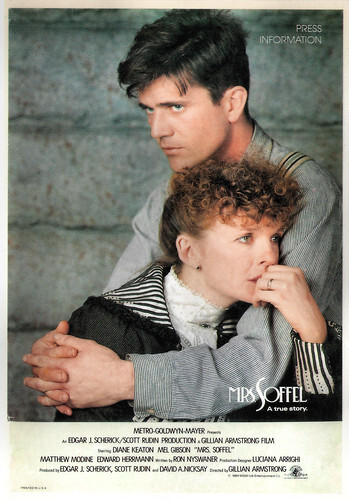
French postcard by Editions Mercuri, no. 341. Photo: Metro- Goldwyn Mayer. Diane Keaton and Mel Gibson in Mrs. Soffel (Gillian Armstrong, 1984).
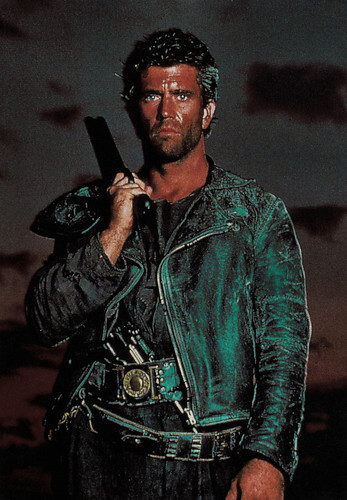
Vintage postcard, no. INC 038. Mel Gibson in Mad Max Beyond Thunderdome (George Miller, George Ogilvie, 1985).
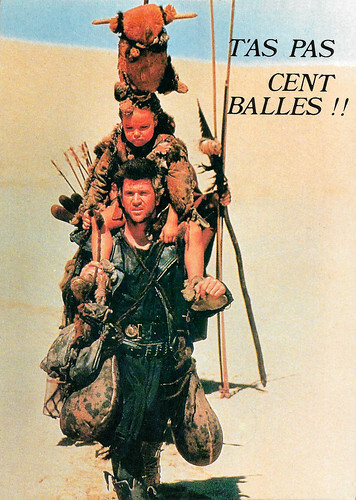
French postcard by Les Editions Gil, no. 14. Mel Gibson in Mad Max Beyond Thunderdome (George Miller, George Ogilvie, 1985). Caption: "You don't have a hundred quid!"
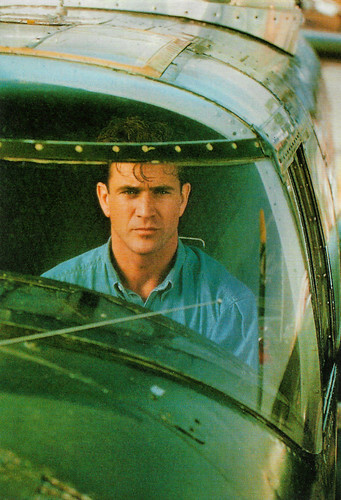
French postcard, no. C 527. Mel Gibson in Forever Young (Steve Miner, 1992).
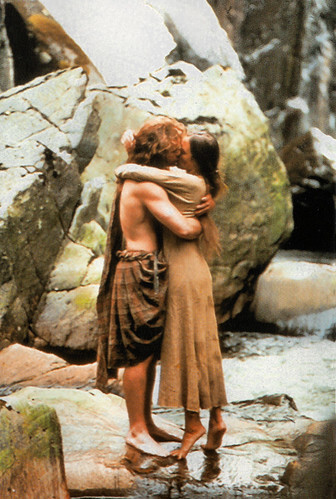
Vintage postcard Photo: Twentieth Century Fox Film Corporation, 1995. Mel Gibson and Catherine McCormack in Braveheart (Mel Gibson, 1995).
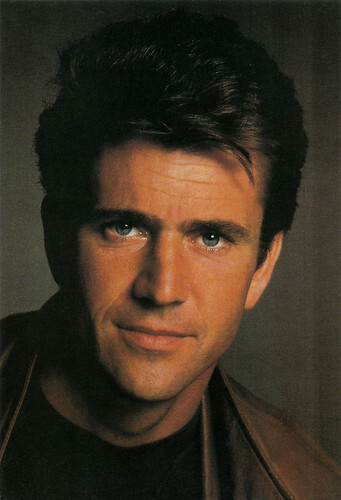
French postcard, no. C 276.
Sources: Sandra Brennan (AllMovie), Wikipedia (Dutch and English) and .

British postcard by Box Office, no. BO 1112. Mel Gibson in Lethal Weapon (Richard Donner, 1987).

French postcard by Editions Spiral Rock, no. Réf. SP 36. Mel Gibson in The River (Mark Rydell, 1984).

French postcard by Editions F. Nugeron, no. 4. Photo: Collection de l'Ecole de Cinéma Camiris. Mel Gibson in Mad Max Beyond Thunderdome (George Miller, George Ogilvie, 1985).

British postcard by Heroes, London, no. PC504.

Vintage postcard Photo: Twentieth Century Fox Film Corporation, 1995. Mel Gibson in Braveheart (Mel Gibson, 1995).
The Australian New Wave
Mel Columcille Gerard Gibson was born in 1956 in Peekskill, New York, USA. He was the sixth of eleven children of Hutton Gibson, a railroad brakeman, and Anne Patricia (Reilly) Gibson. His mother was Irish, from County Longford, while his American-born father is of mostly Irish descent.
His father moved the family from upstate New York to Sydney, New South Wales, Australia, in 1968 after winning as a contestant on the game show Jeopardy! The family settled in New South Wales, where Mel's paternal grandmother, contralto opera singer Eva Mylott, was born. Mel only developed an Aussie accent after his classmates teased him for his American tongue.
Though he had, at one point, set his sights on journalism, Gibson caught the acting bug by the time he had reached college age and studied at the National Institute of Dramatic Art in Sydney, Australia. There he performed with future film thespians Judy Davis and Geoffrey Rush and starred opposite Judy Davis in a production of 'Romeo and Juliet'. Gibson was still a student when he made his film debut in the low-budget Australian teen drama Summer City (Christopher Fraser, 1976) and it didn't take long before he found work playing supporting roles for the South Australia Theatre Company after his graduation. Mel also starred in TV shows.
Eventually, he was chosen to star as a leather-clad post-apocalyptic cop in Mad Max (George Miller, 1979) and as a mildly retarded handyman in Tim (Michael Pate, 1979), co-starring Piper Laurie . The small-budgeted Mad Max made him known worldwide, while Tim garnered the then 22-year-old Gibson a Sammy award for Best Actor from the Australian Film Institute, the Australian equivalent to the Oscar. Gibson wouldn't become internationally famous, however, until after his performance in Mad Max 2 (George Miller, 1981), one of the few sequels to have proved superior to its predecessor.
Gibson got a reputation as a serious, versatile actor. He was a part of the movement dubbed the 'Australian New Wave' by the press. They were a group of filmmakers and performers who emerged from Down Under at about the same time and found work in other parts of the world. Other members included actress Judy Davis and directors George Miller, Gillian Armstrong and Peter Weir. In 1980, he married Robyn Moore and they had seven children.

Spanish postcard by Foto Parjetas, Madrid, no. PC 169-50. Mel Gibson in Gallipoli (Peter Weir, 1981).

Spanish postcard by Foto Parjetas, Madrid, no. FC 154-50. Mel Gibson and Emil Minty in Mad Max 2 (George Miller, 1981).

French postcard by Ebullitions, no. 82. Mel Gibson in The Bounty (Roger Donaldson, 1984).

French postcard by Edition RF, Réf. 206. Mel Gibson in Tequila Sunrise (Robert Towne, 1988).

French postcard, no. INC 92. Mel Gibson and Danny Glover in Lethal Weapon (Richard Donner, 1989).
The highest-paid celebrity
Mel Gibson went on to star in the powerful WWI World War I drama Gallipoli (Peter Weir, 1981), which earned him a second award for Best Actor from the AFI. He reunited with Weir for The Year of Living Dangerously (Peter Weir, 1983), in which he played a callous reporter responsible for covering a bloody Indonesian coup opposite Sigourney Weaver. In 1984, Mel made his American debut in The Bounty (Roger Donaldson, 1984), which co-starred Anthony Hopkins. That same year, he starred opposite Sissy Spacek in The River (Mark Rydell, 1984). He would also star in Mad Max Beyond Thunderdome (1985) alongside singer Tina Turner.
After the third instalment to the Mad Max franchise, Gibson took a two-year break. Then in 1987, Mel starred in what would become his signature series, Lethal Weapon (Richard Donner, 1987), opposite Danny Glover. The role featured Gibson as Martin Riggs, a volatile police officer reeling from the death of his wife, and cemented a spot as one of Hollywood's premier action stars. In 1990, he took on the starring role in Hamlet (Franco Zeffirelli, 1990) with Glenn Close, which garnered him some critical praise. He also made the more endearing Forever Young (Steve Miner. 1992) with Jamie Lee Curtis and the somewhat disturbing The Man Without a Face (Mel Gibson, 1993)in which he played a horrifically burned teacher harbouring a secret.
He played his most famous role as Sir William Wallace in Braveheart (Mel Gibson, 1995). Gibson swept the Oscars including those for Best Picture and Best Director with his epic account of 13th-century Scottish leader William Wallace's lifelong struggle to forge an independent nation. From there, he made such box office hits as Ransom (Ron Howard, 1996), Payback (Brian Helgeland, 1999) and The Patriot (Roland Emmerich, 2000). His later films include Signs (M. Night Shyamalan, 2002), and Edge of Darkness (Martin Campbell, 2010).
For The Passion of the Christ (2004), which he directed, wrote and produced, he spent 25 million dollars of his own money. Back in 1992, he started doing research for the film that was not released until 2004. That year, he was the highest-paid celebrity with a reported $210,000,000 salary from his The Passion of the Christ (2004) profits, plus a potential $150,000,000 that is yet to be accounted for. The way Gibson portrayed the suffering of Christ caused much controversy. He received further critical notice for his directorial work of the action-adventure film Apocalypto (Mel Gibson, 2006), which is set in Mesoamerica during the early 16th century. He separated from his wife Robyn in June 2006.
Sandra Brennan at AllMovie: "That summer, he was pulled over for drunk driving at which time he made extremely derogatory comments about Jewish people to the arresting officer. When word of Gibson's drunken, bigoted tirade made it to the press, the speculation of the actor's anti-Semitic leanings that had circulated because of the choices he'd made in his depiction of the crucifixion in Passion of the Christ seemed confirmed. Gibson's father being an admitted holocaust denier hadn't helped matters and now it seemed that no PR campaign could help. Gibson publicly apologized, expressed extreme regret for his comments, and checked himself into rehab."
Mel Gibson did three-year probation following the misdemeanour drunken driving arrest, but the filmmaker's reputation was irreparably tarnished. Robyn finally filed for divorce in April 2009 but it wasn't finalised until December 2011, reportedly because it took them all that time to divide Gibson's estimated assets of $850 million. It is considered the biggest divorce payout in Hollywood history. In 2009, he made a first public appearance together with his girlfriend, Oksana Grigorieva who was then three months pregnant with his daughter Lucia. The couple split in 2010. In 2014, he started a relationship with Rosalind Ross with whom he had his ninth child.

French postcard by Editions Mercuri, no. 341. Photo: Metro- Goldwyn Mayer. Diane Keaton and Mel Gibson in Mrs. Soffel (Gillian Armstrong, 1984).

Vintage postcard, no. INC 038. Mel Gibson in Mad Max Beyond Thunderdome (George Miller, George Ogilvie, 1985).

French postcard by Les Editions Gil, no. 14. Mel Gibson in Mad Max Beyond Thunderdome (George Miller, George Ogilvie, 1985). Caption: "You don't have a hundred quid!"

French postcard, no. C 527. Mel Gibson in Forever Young (Steve Miner, 1992).

Vintage postcard Photo: Twentieth Century Fox Film Corporation, 1995. Mel Gibson and Catherine McCormack in Braveheart (Mel Gibson, 1995).

French postcard, no. C 276.
Sources: Sandra Brennan (AllMovie), Wikipedia (Dutch and English) and .
Published on February 24, 2023 22:00
February 23, 2023
Rita Moreno
Puerto Rican actress Rita Moreno (1931) is one of the very few performers to win the Oscar in 1962, the Grammy in 1972, the Tony in 1975 and her first of two Emmys in 1977. Moreno is best known for her role as Anita, the girl of the leader of the Puerto Rican street gang the Sharks in the classic musical West Side Story (1961). She was the first Hispanic woman to win an Oscar when she received the Academy Award for best female supporting actor for this film.
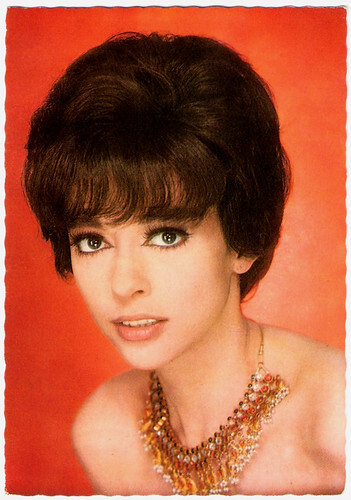
French postcard by E.D.U.G., no. 460. Photo: Sam Lévin. Sent by mail in 1971.
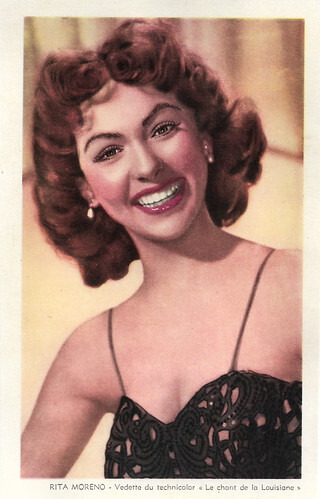
Belgian collectors card by Kwatta. Rita Moreno in The Toast of New Orleans (Norman Taurog, 1950).
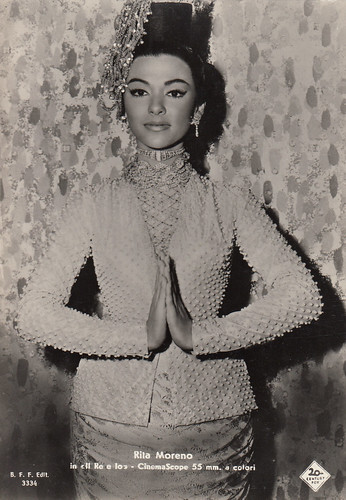
Italian postcard by Ballerini & Fratini, Firenze, no. 3334. Photo: 20th Century Fox. Rita Moreno, as Burmese character Tuptim, in The King and I (Walter Lang, 1956).
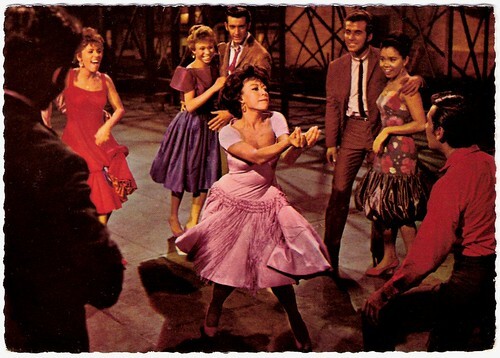
Dutch postcard. Photo: Rita Moreno in West Side Story (Robert Wise, 1961).
Cast as a Hispanic pepper pot
Rita Moreno was born Rosita Dolores Alverío in 1931 in a hospital in Humacao, Puerto Rico. She was raised in nearby, smaller Juncos, which had no hospital. Her parents were seamstress Rosa María (Marcano) and farmer Francisco José "Paco" Alverío. Her mother moved to New York City in 1937, taking Rita with her while leaving her reportedly unfaithful husband and Rita's younger brother behind.
Rita's professional career began early. From the age of nine, she performed as a professional dancer in New York nightclubs. At age 11, she landed her first film experience, dubbing Spanish-language versions of US films. In 1945, the 13-year-old made her Broadway debut in the play 'Skydrift' at the Belasco Theatre, costarring with Arthur Keegan and a young Eli Wallach.
Although she would not appear again on Broadway for almost two decades, Rita Moreno, as she was billed in the play, had arrived professionally. In 1950, she was signed by MGM, but the studio dropped her option after just one year.
She was often cast as a Hispanic pepper pot or as another 'exotic' such as in the TV series Father Knows Best (1954) as an exchange student from India. The young Puerto Rican actress/entertainer was featured on the cover of the 1 March 1954, edition of 'Life Magazine' with the provocative title "Rita Moreno: An Actresses' Catalog of Sex and Innocence".
The sexpot stereotype would plague her throughout the decade and Moreno had to play roles in films that she considered degrading. Among the better pictures, she appeared in were the classics Singin' in the Rain (Stanley Donen, Gene Kelly, 1952) and The King and I (Walter Lang, 1956) starring Yul Brynner and Deborah Kerr .
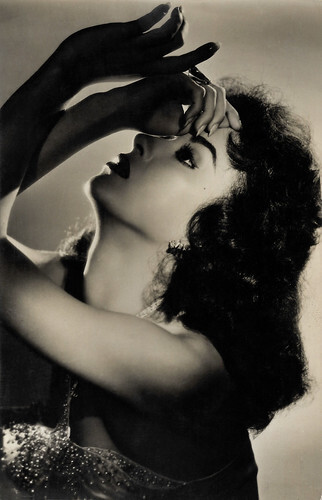
Spanish postcard by Archivo Bermejo, no. 7651. Photo: United Artists.
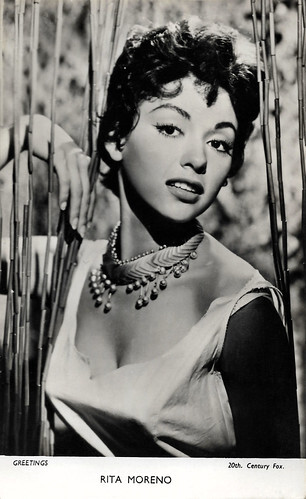
British postcard in the Greetings Series. Photo: 20th Century Fox.
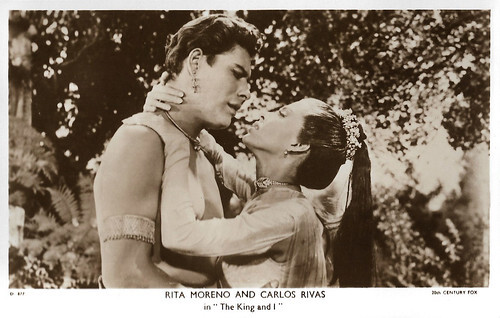
British postcard in the Picturegoer Series, London, no. D 877. Photo: 20th Century Fox. Rita Moreno and Carlos Rivas in The King and I (Walter Lang, 1956).
A retelling of William Shakespeare's Romeo & Juliet
Rita Moreno was finally cast by director Robert Wise in West Side Story (Jerome Robbins, Robert Wise, 1961), the film version of the smash 1957 Broadway musical.
West Side Story is a retelling of William Shakespeare 's 'Romeo & Juliet', with the warring Venetian clans, the Montagues and Capulets, re-envisioned as Irish/Polish and Puerto Rican adolescent street gangs, the Jets and the Sharks.
Moreno was cast as Anita, the Puerto Rican girlfriend of Sharks' leader Bernardo ( George Chakiris ), whose sister Maria ( Natalie Wood ) is the piece's Juliet.
The romantic musical drama became the second highest-grossing film of the year in the United States. West Side Story was nominated for 11 Academy Awards and won 10, including Best Picture.
Rita played the role of Anita with great emotion and the song 'America' became a highlight because of her. However, despite her talent, interesting roles were not forthcoming in the 1960s.
Jon C. Hopwood at IMDb : "The following decade would prove kinder, possibly because the beautiful Moreno had aged gracefully and could now be seen by filmmakers, TV producers and casting directors as something other than the spitfire/sexpot that Hispanic women were supposed to conform to."
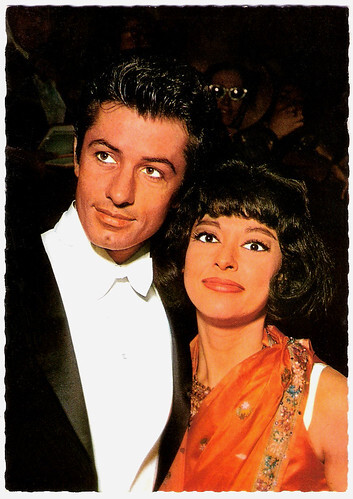
Dutch postcard by Gebr. Spanjersberg NV, Rotterdam. Photo: Capitol. George Chakiris and Rita Moreno in West Side Story (Robert Wise, 1961).
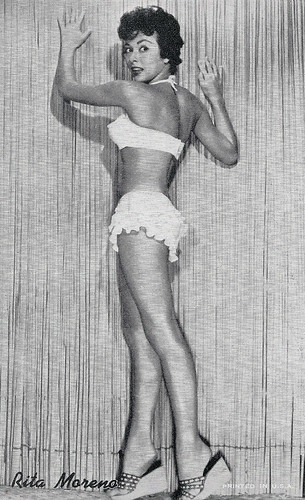
American postcard.
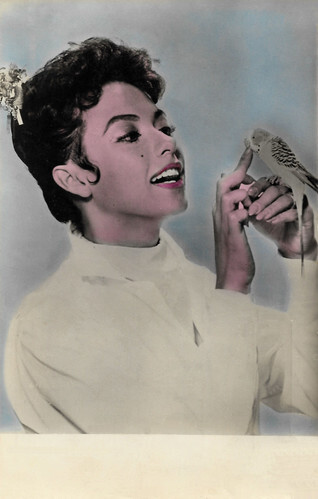
Yugoslavian postcard by Studio Sombor, no. 253.
Her reputation as a national treasure
Rita Moreno played a $100 hooker in Mike Nichols' brilliant Carnal Knowledge (1971), based on Jules Feiffer's acerbic look at male sexuality. Another role that signalled a career renaissance was Milly the Helper in the children's TV show The Electric Company (1971). Moreno won a 1972 Grammy Award for her contribution to The Electric Company's soundtrack album.
Three years later, she won a Tony Award as Best Featured Actress in a Musical for 'The Ritz'. She would reprise the role in the film version, The Ritz (Richard Lester, 1976). She also won Emmy Awards for her TV roles in The Rockford Files (1974) and The Muppet Show (1976).
Moreno continued to work steadily on screen (both large and small) and on stage. From July 1997 to February 2003, she played 56 episodes in the TV series Oz as Sister Peter Marie Reimondo where she was a psychiatrist for the inmates.
Since 2017, she has played the role of Lydia Alvarez in the TV series One Day at a Time. She returned in the remake of West Side Story (Steven Spielberg, 2021). She played the elderly shopkeeper Valentina.
Her reputation as a national treasure was officially ratified with the award of the Presidential Medal of Freedom by President George W. Bush in 2004. Rita Moreno was married to Dr. Leonard Isadore Gordon, an internist and cardiologist, from 1965 till his death in 2010. They had a daughter, Fernanda Gordon. A successful jewellery designer, Fernanda founded Nandiz Design. She is married to David Fisher and they have two sons, Justin (2002) and Cameron (2004).
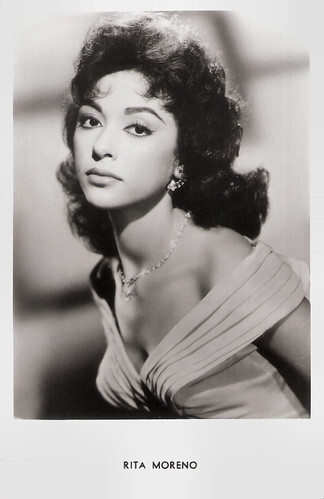
Belgian postcard, no. 5229.
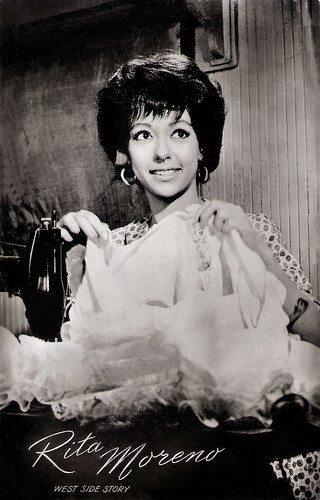
Dutch postcard by Uitg. Takken, Utrecht, no. AX 5366. Rita Moreno in West Side Story (Jerome Robbins, Robert Wise, 1961).
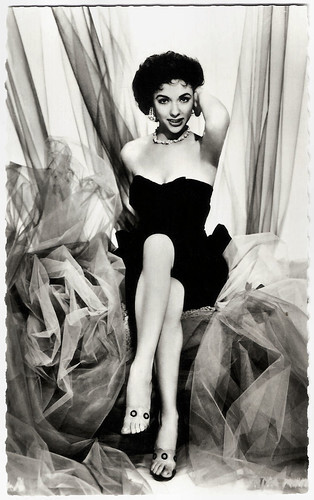
French postcard by Editions P.I., Paris, offered by Les Carbones Korès 'Carboplane', no. 878. Photo: Paramount Pictures, 1955.
Sources: (IMDb), Wikipedia (Dutch) and .

French postcard by E.D.U.G., no. 460. Photo: Sam Lévin. Sent by mail in 1971.

Belgian collectors card by Kwatta. Rita Moreno in The Toast of New Orleans (Norman Taurog, 1950).

Italian postcard by Ballerini & Fratini, Firenze, no. 3334. Photo: 20th Century Fox. Rita Moreno, as Burmese character Tuptim, in The King and I (Walter Lang, 1956).

Dutch postcard. Photo: Rita Moreno in West Side Story (Robert Wise, 1961).
Cast as a Hispanic pepper pot
Rita Moreno was born Rosita Dolores Alverío in 1931 in a hospital in Humacao, Puerto Rico. She was raised in nearby, smaller Juncos, which had no hospital. Her parents were seamstress Rosa María (Marcano) and farmer Francisco José "Paco" Alverío. Her mother moved to New York City in 1937, taking Rita with her while leaving her reportedly unfaithful husband and Rita's younger brother behind.
Rita's professional career began early. From the age of nine, she performed as a professional dancer in New York nightclubs. At age 11, she landed her first film experience, dubbing Spanish-language versions of US films. In 1945, the 13-year-old made her Broadway debut in the play 'Skydrift' at the Belasco Theatre, costarring with Arthur Keegan and a young Eli Wallach.
Although she would not appear again on Broadway for almost two decades, Rita Moreno, as she was billed in the play, had arrived professionally. In 1950, she was signed by MGM, but the studio dropped her option after just one year.
She was often cast as a Hispanic pepper pot or as another 'exotic' such as in the TV series Father Knows Best (1954) as an exchange student from India. The young Puerto Rican actress/entertainer was featured on the cover of the 1 March 1954, edition of 'Life Magazine' with the provocative title "Rita Moreno: An Actresses' Catalog of Sex and Innocence".
The sexpot stereotype would plague her throughout the decade and Moreno had to play roles in films that she considered degrading. Among the better pictures, she appeared in were the classics Singin' in the Rain (Stanley Donen, Gene Kelly, 1952) and The King and I (Walter Lang, 1956) starring Yul Brynner and Deborah Kerr .

Spanish postcard by Archivo Bermejo, no. 7651. Photo: United Artists.

British postcard in the Greetings Series. Photo: 20th Century Fox.

British postcard in the Picturegoer Series, London, no. D 877. Photo: 20th Century Fox. Rita Moreno and Carlos Rivas in The King and I (Walter Lang, 1956).
A retelling of William Shakespeare's Romeo & Juliet
Rita Moreno was finally cast by director Robert Wise in West Side Story (Jerome Robbins, Robert Wise, 1961), the film version of the smash 1957 Broadway musical.
West Side Story is a retelling of William Shakespeare 's 'Romeo & Juliet', with the warring Venetian clans, the Montagues and Capulets, re-envisioned as Irish/Polish and Puerto Rican adolescent street gangs, the Jets and the Sharks.
Moreno was cast as Anita, the Puerto Rican girlfriend of Sharks' leader Bernardo ( George Chakiris ), whose sister Maria ( Natalie Wood ) is the piece's Juliet.
The romantic musical drama became the second highest-grossing film of the year in the United States. West Side Story was nominated for 11 Academy Awards and won 10, including Best Picture.
Rita played the role of Anita with great emotion and the song 'America' became a highlight because of her. However, despite her talent, interesting roles were not forthcoming in the 1960s.
Jon C. Hopwood at IMDb : "The following decade would prove kinder, possibly because the beautiful Moreno had aged gracefully and could now be seen by filmmakers, TV producers and casting directors as something other than the spitfire/sexpot that Hispanic women were supposed to conform to."

Dutch postcard by Gebr. Spanjersberg NV, Rotterdam. Photo: Capitol. George Chakiris and Rita Moreno in West Side Story (Robert Wise, 1961).

American postcard.

Yugoslavian postcard by Studio Sombor, no. 253.
Her reputation as a national treasure
Rita Moreno played a $100 hooker in Mike Nichols' brilliant Carnal Knowledge (1971), based on Jules Feiffer's acerbic look at male sexuality. Another role that signalled a career renaissance was Milly the Helper in the children's TV show The Electric Company (1971). Moreno won a 1972 Grammy Award for her contribution to The Electric Company's soundtrack album.
Three years later, she won a Tony Award as Best Featured Actress in a Musical for 'The Ritz'. She would reprise the role in the film version, The Ritz (Richard Lester, 1976). She also won Emmy Awards for her TV roles in The Rockford Files (1974) and The Muppet Show (1976).
Moreno continued to work steadily on screen (both large and small) and on stage. From July 1997 to February 2003, she played 56 episodes in the TV series Oz as Sister Peter Marie Reimondo where she was a psychiatrist for the inmates.
Since 2017, she has played the role of Lydia Alvarez in the TV series One Day at a Time. She returned in the remake of West Side Story (Steven Spielberg, 2021). She played the elderly shopkeeper Valentina.
Her reputation as a national treasure was officially ratified with the award of the Presidential Medal of Freedom by President George W. Bush in 2004. Rita Moreno was married to Dr. Leonard Isadore Gordon, an internist and cardiologist, from 1965 till his death in 2010. They had a daughter, Fernanda Gordon. A successful jewellery designer, Fernanda founded Nandiz Design. She is married to David Fisher and they have two sons, Justin (2002) and Cameron (2004).

Belgian postcard, no. 5229.

Dutch postcard by Uitg. Takken, Utrecht, no. AX 5366. Rita Moreno in West Side Story (Jerome Robbins, Robert Wise, 1961).

French postcard by Editions P.I., Paris, offered by Les Carbones Korès 'Carboplane', no. 878. Photo: Paramount Pictures, 1955.
Sources: (IMDb), Wikipedia (Dutch) and .
Published on February 23, 2023 22:00
February 22, 2023
The Crusades (1935)
The Crusades (1935) is an American historical adventure film produced and directed by Cecil B. DeMille and originally released by Paramount Pictures. The film stars Loretta Young as Berengaria of Navarre and Henry Wilcoxon as Richard I Lionheart of England. It was nominated for an Academy Award for Best Cinematography (Victor Milner) as well as for Best Foreign Film at the Venice Film Festival in 1935.
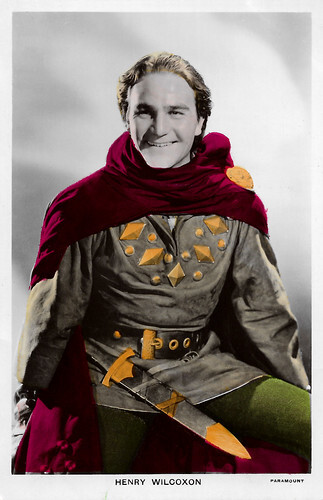
British postcard in the Colourgraph Series, London, no. C 248. Photo: Paramount. Henry Wilcoxon in The Crusades (Cecil B. DeMille, 1935).
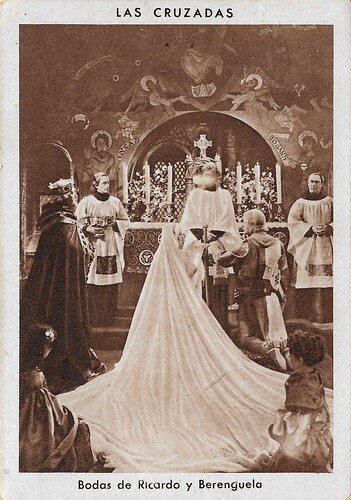
Spanish collectors card, Series 2, no. 1 of 21. Photo: Paramount Pictures. Henry Wilcoxon as Richard Lionheart and Loretta Young as Berengeria in The Crusades (Cecil B. DeMille, 1935). Caption: The wedding of Richard and Berengaria.
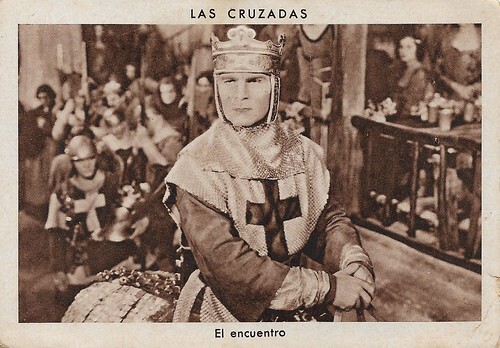
Spanish collectors card, Series 2, no. 2 of 21. Photo: Paramount Pictures. Henry Wilcoxon in The Crusades (Cecil B. DeMille, 1935). Caption: The encounter.
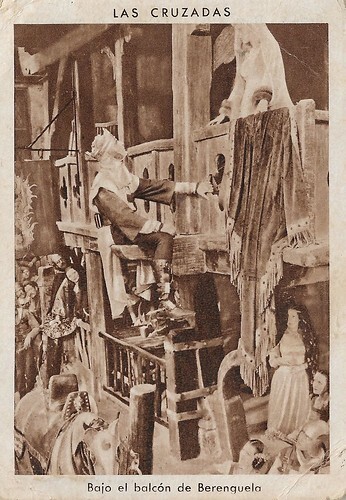
Spanish collectors card, Series 2, no. 3 of 21. Photo: Paramount Pictures. Henry Wilcoxon and Loretta Young in The Crusades (Cecil B. DeMille, 1935). Caption: Underneath the balcony of Berengaria.
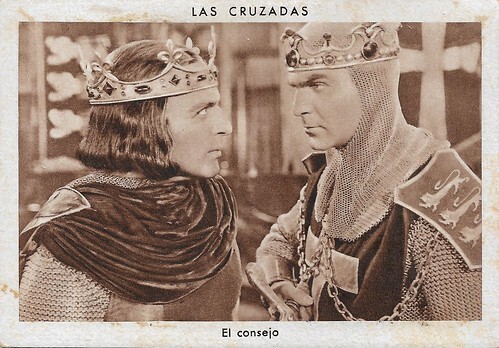
Spanish collectors card, Series 2, no. 4 of 21. Photo: Paramount Pictures. C. Henry Gordon as King Philip of France and Henry Wilcoxon as Richard Lionheart in The Crusades (Cecil B. DeMille, 1935). Caption: The council.
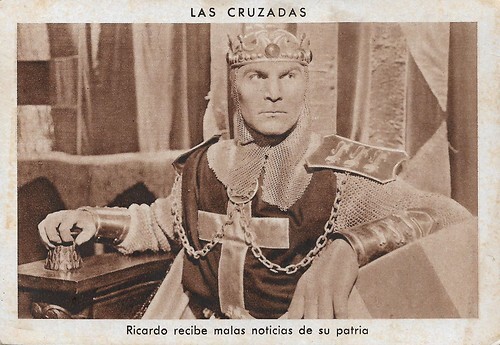
Spanish collectors card, Series 2, no. 5 of 21. Photo: Paramount Pictures. Henry Wilcoxon as Richard Lionheart in The Crusades (Cecil B. DeMille, 1935). Caption: Richard receives bad news from his homeland.
A man of action but little thought
The screenplay for The Crusades (Cecil B. DeMille, 1935) was written by Harold Lamb, Waldemar Young and Dudley Nichols. They took many of the film's elements and main characters from the Third Crusade (1190-1192), which was prompted by the Saracen capture of Jerusalem and the crusader states in the Holy Land in 1187. The character of Richard the Lionheart, King of England ( Henry Wilcoxon ), is a man of action but little thought.
A hermit from Jerusalem ( C. Aubrey Smith ) arrives in Europe and starts gathering support for a Crusade. The hermit convinces a number of European rulers to travel to Jerusalem in order to bring the Holy City into Christian hands. Richard enlists in order to avoid an arranged betrothal to the King of France's sister, Princess Alice of France (Katherine DeMille), but is followed by the Countess on the Crusade.
A plot is laid against Richard's life by his brother Prince John (Ramsay Hill) and Conrad, Marquis of Montferrat ( Joseph Schildkraut ). En route to the war, Richard meets Berengaria, Princess of Navarre (Loretta Young). In order to get food for his men, Richard reluctantly marries her in exchange for her father's cattle and grain. Berengaria is forced to accompany Richard to the Holy Land.
During the Crusaders' attempts to get past the walls of Acre, the allies assemble in a conference, but in disarray. Richard receives word that his brother John has seized the throne of England. Richard's ally, Philip II of France, is enraged at Richard's rejection of his sister Alice, but Richard defies Philip and the other troubled allies by proclaiming Berengaria Queen of England.
The Christian leaders meet in parley with the Muslim Sultan and leader Saladin (Ian Keith). Saladin is struck by Berengaria's beauty and bravery in supporting her husband. However, he rejects any truce with the Crusaders, and declares that the arrogant Richard will "never pass the gates of Jerusalem."
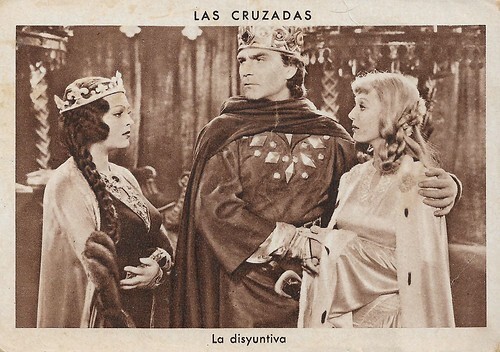
Spanish collectors card, Series 2, no 6. of 21. Photo: Paramount Pictures. Katherine DeMille as Princess Alice of France, Henry Wilcoxon and Loretta Young in The Crusades (Cecil B. DeMille, Paramount Pictures 1935). Caption: The dilemma.
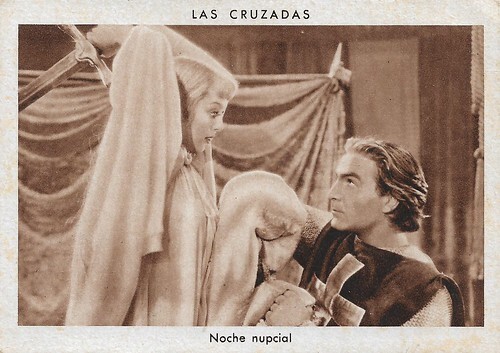
Spanish collectors card, Series 2, no 7. of 21. Photo: Paramount Pictures. Henry Wilcoxon and Loretta Young in The Crusades (Cecil B. DeMille, Paramount Pictures 1935). Caption: Wedding night.
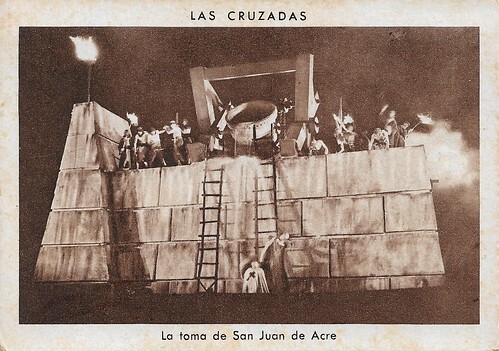
Spanish collectors card, Series 2, no. 8 of 21. Photo: Paramount Pictures. Scene from The Crusades (Cecil B. DeMille, 1935). The taking of St. Jean d'Acre.
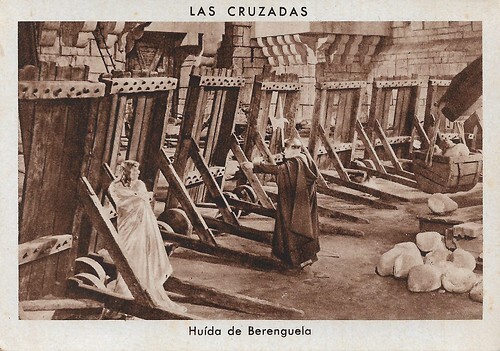
Spanish collectors card, Series 2, no. 9 of 21. Photo: Paramount Pictures. Loretta Young in The Crusades (Cecil B. DeMille, 1935). Caption: The getaway of Berengaria.
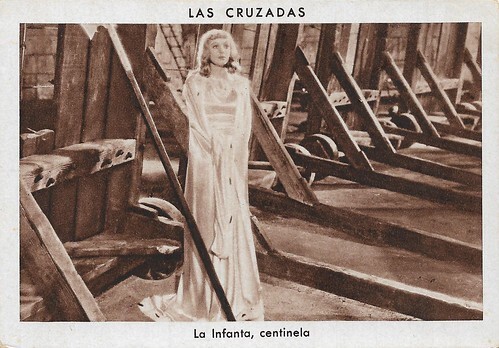
Spanish collectors card, Series 2, no. 10 of 21. Photo: Paramount Pictures. Loretta Young in The Crusades (Cecil B. DeMille, 1935). Caption: The Infanta as sentry.
Spreading a political or cultural agenda
Berengaria is fearful that her presence in camp is causing disloyalty among Richard's allies, in particular the powerful French King Philip (C. Henry Gordon), and may harm their holy quest. Seeking death, she enters no man's land between the lines, only to be wounded and captured by the forces of Saladin. The hermit, the Christian "holy man" who had preached the Crusade, also is captured. Saladin escapes the siege, and after finding Berengaria wounded, brings her to Jerusalem to care for her, with admiration and growing affection. Not knowing this Richard and the Crusaders storm Acre to save the Queen of England.
The internal plot against Richard's life is hatched by Conrad and disloyal soldiers. Conrad reveals his plot to Saladin, expecting to be rewarded. Appalled by Conrad's treachery, Saladin orders Conrad to be immediately executed. Berengaria offers herself to Saladin if he will intervene and save Richard's life. Saladin sends a few of his soldiers to warn Richard who is searching the battlefield at night for the body of a friend. Conrad's men attack Richard but are defeated by Saladin's soldiers who take the English King to Saladin.
Richard and Saladin agree to a truce and the gates of Jerusalem are opened to all Christians with the exception of Richard, in keeping with Saladin's earlier promise. After losing his kingship, his wife and the opportunity to see the Holy City, Richard prays for the first time, asking God for him to be reunited with his wife. Richard encounters Berengaria on her way to the Holy City. He admits his mistakes and Berengaria tells him that Saladin has freed her along with the other Christian captives. Berengaria proceeds alone toward Jerusalem to visit the Holy City and promises to return to him.
Lorraine K. Stock writes in 'Hollywood in the Holy Land', in her chapter 'Now Starring in the Third Crusade' that Crusading films have been used by European and American countries to spread a political or cultural agenda. One way in which this is done is through the main Crusading "heroes" such as Richard the Lionheart and the main antagonist Saladin. Many films have used the relationship between Richard I and Saladin.
In The Crusades the relationship between Richard I and Saladin is connected not only by the conflict of the Crusade but "an improbable, if entertaining, erotic triangle" with Berengaria of Navarre. Stock notes that this relationship and the events which occur can be seen as a reaction to events after the First World War and especially America's isolationism. For example, Richard the Lionheart at first does not want to get married, so he goes on the Crusade despite showing signs of not being religious. Berengaria can also be seen as a "medieval League of Nations" when negotiations between Saladin and Richard I occur at the end of the film.
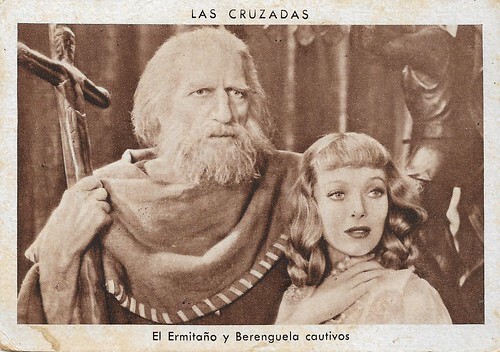
Spanish collectors card, Series 2, no. 11 of 21. Photo: Paramount Pictures. C. Aubrey Smith as the Hermit and Loretta Young as Berengaria in The Crusades (Cecil B. DeMille, 1935). Caption: The Hermit and Berengaria cautious.
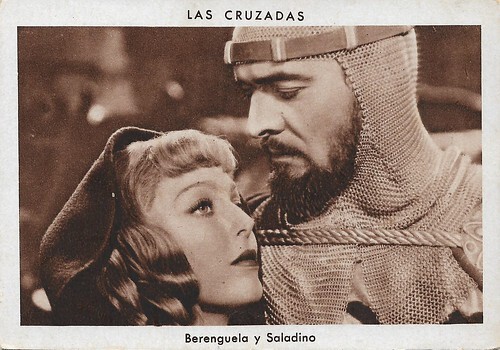
Spanish collectors card, Series 2, no. 12 of 21. Photo: Paramount Pictures. Loretta Young as Berengaria and Ian Keith as Saladin in The Crusades (Cecil B. DeMille, 1935). Caption: Berengaria and Saladin .
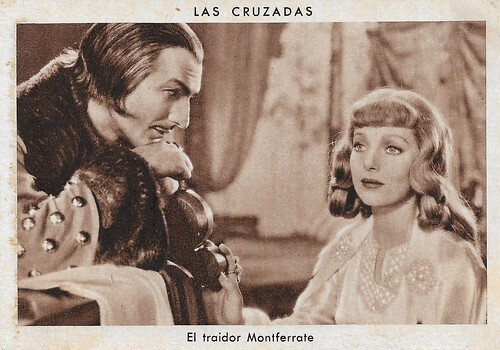
Spanish collectors card, Series 2, no. 13 of 21. Photo: Paramount Pictures. Joseph Schildkraut as Conrad, marquis of Montferrat and Loretta Young in The Crusades (Cecil B. DeMille, 1935). Caption: The traitor Montferrat.
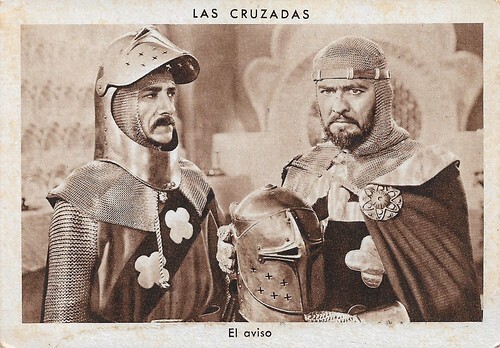
Spanish collectors card, Series 2, no. 14 of 21. Photo: Paramount Pictures. Ian Keith (right) as Saladin in The Crusades (Cecil B. DeMille, 1935). Caption: The notice.
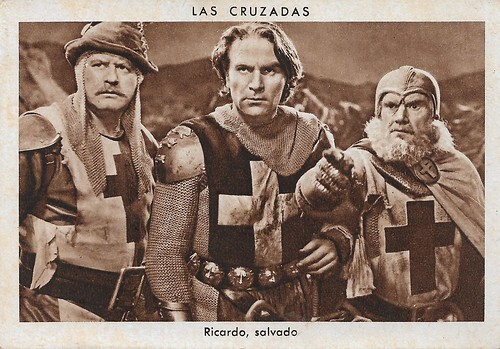
Spanish collectors card, Series 2, no. 15 of 21. Photo: Paramount Pictures. Henry Wilcoxon in The Crusades (Cecil B. DeMille, 1935). Caption: Richard saved.
The good and noble side of the Muslims
The main concern for such films as The Crusades is the way Muslims and Crusaders are portrayed. Throughout the film, Lorraine K. Stock notes that there are negative portrayals of Saladin and the Muslims. For instance Stock notes that the Crusaders are all dressed in mail armour with the cross upon their chests, while Saladin and the Saracens are dressed mainly in "flowing robes of luxury fabrics" and "silken sashes".
The Saracens are shown as oriental but also "exotically feminized" according to Stock. Another scene has the Saracens shoot a Crusader messenger, who demands the surrender of the city, with one of them wearing a helmet with devil horns upon it. There are other moments in which the Europeans mention devilry or call Muslims infidels. Stock says director Cecil B. DeMille established "the stereotypes of Richard and Saladin that subsequent films would repeat…".
However, Saladin is also depicted as an honourable man. In 'Islam, Muslims and Arabs in the Popular Hollywood Cinema', Anton K. Kozlovic writes "The Crusades was not as enthusiastically received in the West as DeMille would have liked, probably because it showed the good and noble side of the Muslims and contrasted it with the darker deeds of Christianity".
Saladin in the film refuses to help assassinate Richard I and in fact sends out help to prevent Richard from being killed by the treacherous other Europeans. Anton K. Kozlovic also notes that when Saladin offers peace to the "foes of Islam", Richard responds by drawing his sword "and saying 'We are going to slaughter you!'". Anton K. Kozlovic sees Cecil B. DeMille 's The Crusades (1935) as a challenge to the stereotypical norm and negative picture painted of Muslims in Crusader films specifically.
Hal Erickson finally in his review at AllMovie : "In the film's most memorable scene, the fundamental difference between the boorish Richard and the cultured Saladin is demonstrated when the Saracen ruler delicately cleaves Berengaria's silk scarf in twain with his gleaming sword. It took a great deal of nerve to depict the film's hero as a thuggish brute and the nominal villain as the most sympathetic character in the story, but DeMille gets away with it in The Crusades, and still has time left over to deliver his usual quota of thrills, pageantry, convoluted history and campy dialogue. And yes, that is Ann Sheridan as a Christian captive in the opening scenes."
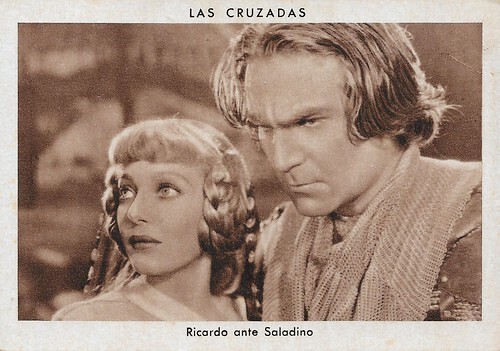
Spanish collectors card, Series 2, no. 16 of 21. Photo: Paramount Pictures. Henry Wilcoxon and Loretta Young in The Crusades (Cecil B. DeMille, 1935). Caption: Richard before Saladin.
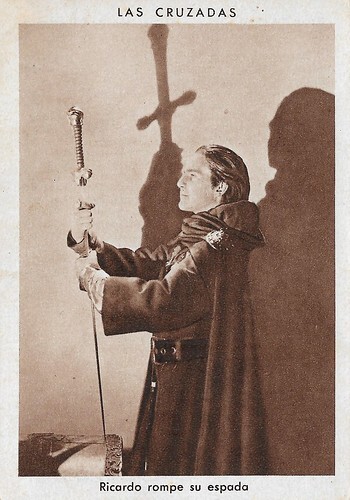
Spanish collectors card, Series 2, no. 17 of 21. Photo: Paramount Pictures. Henry Wilcoxon in The Crusades (Cecil B. DeMille, 1935). Caption: Richard breaks his sword.
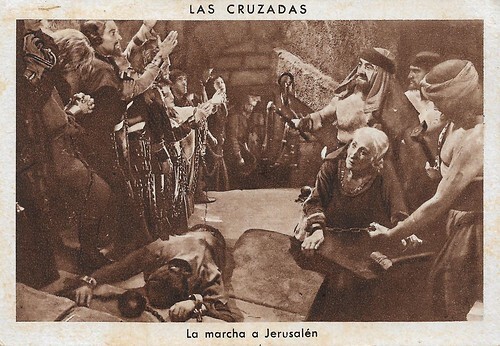
Spanish collectors card, Series 2, no. 18 of 21. Photo: Paramount Pictures. Scene from The Crusades (Cecil B. DeMille, 1935). Caption: The March to Jerusalem.
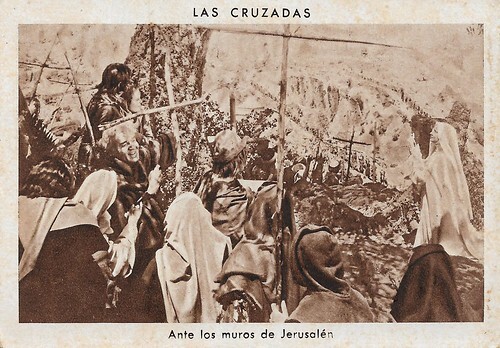
Spanish collectors card, Series 2, no. 19 of 21. Photo: Paramount Pictures. Scene from The Crusades (Cecil B. DeMille, 1935). Caption: Before the Walls of Jerusalem.
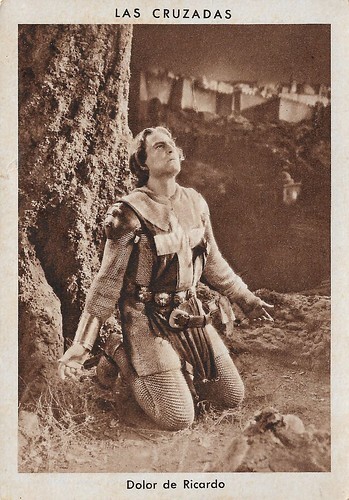
Spanish collectors card, Series 2, no. 20 of 21. Photo: Paramount Pictures. Henry Wilcoxon in The Crusades (Cecil B. DeMille, 1935). Caption: The Sorrow of Richard.
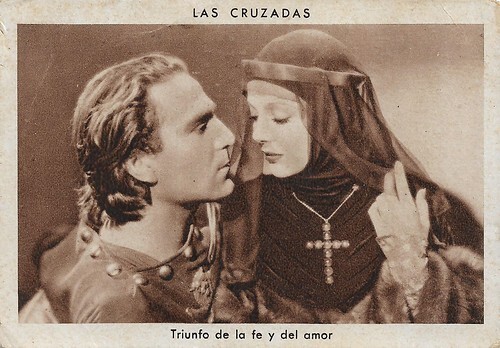
Spanish collectors card, Series 2, no. 21 of 21. Photo: Paramount Pictures. Henry Wilcoxon and Loretta Young in The Crusades (Cecil B. DeMille, 1935). Caption: The Triumph of Faith and Love.
Source: Hal Erickson (AllMovie), Wikipedia and IMDb.

British postcard in the Colourgraph Series, London, no. C 248. Photo: Paramount. Henry Wilcoxon in The Crusades (Cecil B. DeMille, 1935).

Spanish collectors card, Series 2, no. 1 of 21. Photo: Paramount Pictures. Henry Wilcoxon as Richard Lionheart and Loretta Young as Berengeria in The Crusades (Cecil B. DeMille, 1935). Caption: The wedding of Richard and Berengaria.

Spanish collectors card, Series 2, no. 2 of 21. Photo: Paramount Pictures. Henry Wilcoxon in The Crusades (Cecil B. DeMille, 1935). Caption: The encounter.

Spanish collectors card, Series 2, no. 3 of 21. Photo: Paramount Pictures. Henry Wilcoxon and Loretta Young in The Crusades (Cecil B. DeMille, 1935). Caption: Underneath the balcony of Berengaria.

Spanish collectors card, Series 2, no. 4 of 21. Photo: Paramount Pictures. C. Henry Gordon as King Philip of France and Henry Wilcoxon as Richard Lionheart in The Crusades (Cecil B. DeMille, 1935). Caption: The council.

Spanish collectors card, Series 2, no. 5 of 21. Photo: Paramount Pictures. Henry Wilcoxon as Richard Lionheart in The Crusades (Cecil B. DeMille, 1935). Caption: Richard receives bad news from his homeland.
A man of action but little thought
The screenplay for The Crusades (Cecil B. DeMille, 1935) was written by Harold Lamb, Waldemar Young and Dudley Nichols. They took many of the film's elements and main characters from the Third Crusade (1190-1192), which was prompted by the Saracen capture of Jerusalem and the crusader states in the Holy Land in 1187. The character of Richard the Lionheart, King of England ( Henry Wilcoxon ), is a man of action but little thought.
A hermit from Jerusalem ( C. Aubrey Smith ) arrives in Europe and starts gathering support for a Crusade. The hermit convinces a number of European rulers to travel to Jerusalem in order to bring the Holy City into Christian hands. Richard enlists in order to avoid an arranged betrothal to the King of France's sister, Princess Alice of France (Katherine DeMille), but is followed by the Countess on the Crusade.
A plot is laid against Richard's life by his brother Prince John (Ramsay Hill) and Conrad, Marquis of Montferrat ( Joseph Schildkraut ). En route to the war, Richard meets Berengaria, Princess of Navarre (Loretta Young). In order to get food for his men, Richard reluctantly marries her in exchange for her father's cattle and grain. Berengaria is forced to accompany Richard to the Holy Land.
During the Crusaders' attempts to get past the walls of Acre, the allies assemble in a conference, but in disarray. Richard receives word that his brother John has seized the throne of England. Richard's ally, Philip II of France, is enraged at Richard's rejection of his sister Alice, but Richard defies Philip and the other troubled allies by proclaiming Berengaria Queen of England.
The Christian leaders meet in parley with the Muslim Sultan and leader Saladin (Ian Keith). Saladin is struck by Berengaria's beauty and bravery in supporting her husband. However, he rejects any truce with the Crusaders, and declares that the arrogant Richard will "never pass the gates of Jerusalem."

Spanish collectors card, Series 2, no 6. of 21. Photo: Paramount Pictures. Katherine DeMille as Princess Alice of France, Henry Wilcoxon and Loretta Young in The Crusades (Cecil B. DeMille, Paramount Pictures 1935). Caption: The dilemma.

Spanish collectors card, Series 2, no 7. of 21. Photo: Paramount Pictures. Henry Wilcoxon and Loretta Young in The Crusades (Cecil B. DeMille, Paramount Pictures 1935). Caption: Wedding night.

Spanish collectors card, Series 2, no. 8 of 21. Photo: Paramount Pictures. Scene from The Crusades (Cecil B. DeMille, 1935). The taking of St. Jean d'Acre.

Spanish collectors card, Series 2, no. 9 of 21. Photo: Paramount Pictures. Loretta Young in The Crusades (Cecil B. DeMille, 1935). Caption: The getaway of Berengaria.

Spanish collectors card, Series 2, no. 10 of 21. Photo: Paramount Pictures. Loretta Young in The Crusades (Cecil B. DeMille, 1935). Caption: The Infanta as sentry.
Spreading a political or cultural agenda
Berengaria is fearful that her presence in camp is causing disloyalty among Richard's allies, in particular the powerful French King Philip (C. Henry Gordon), and may harm their holy quest. Seeking death, she enters no man's land between the lines, only to be wounded and captured by the forces of Saladin. The hermit, the Christian "holy man" who had preached the Crusade, also is captured. Saladin escapes the siege, and after finding Berengaria wounded, brings her to Jerusalem to care for her, with admiration and growing affection. Not knowing this Richard and the Crusaders storm Acre to save the Queen of England.
The internal plot against Richard's life is hatched by Conrad and disloyal soldiers. Conrad reveals his plot to Saladin, expecting to be rewarded. Appalled by Conrad's treachery, Saladin orders Conrad to be immediately executed. Berengaria offers herself to Saladin if he will intervene and save Richard's life. Saladin sends a few of his soldiers to warn Richard who is searching the battlefield at night for the body of a friend. Conrad's men attack Richard but are defeated by Saladin's soldiers who take the English King to Saladin.
Richard and Saladin agree to a truce and the gates of Jerusalem are opened to all Christians with the exception of Richard, in keeping with Saladin's earlier promise. After losing his kingship, his wife and the opportunity to see the Holy City, Richard prays for the first time, asking God for him to be reunited with his wife. Richard encounters Berengaria on her way to the Holy City. He admits his mistakes and Berengaria tells him that Saladin has freed her along with the other Christian captives. Berengaria proceeds alone toward Jerusalem to visit the Holy City and promises to return to him.
Lorraine K. Stock writes in 'Hollywood in the Holy Land', in her chapter 'Now Starring in the Third Crusade' that Crusading films have been used by European and American countries to spread a political or cultural agenda. One way in which this is done is through the main Crusading "heroes" such as Richard the Lionheart and the main antagonist Saladin. Many films have used the relationship between Richard I and Saladin.
In The Crusades the relationship between Richard I and Saladin is connected not only by the conflict of the Crusade but "an improbable, if entertaining, erotic triangle" with Berengaria of Navarre. Stock notes that this relationship and the events which occur can be seen as a reaction to events after the First World War and especially America's isolationism. For example, Richard the Lionheart at first does not want to get married, so he goes on the Crusade despite showing signs of not being religious. Berengaria can also be seen as a "medieval League of Nations" when negotiations between Saladin and Richard I occur at the end of the film.

Spanish collectors card, Series 2, no. 11 of 21. Photo: Paramount Pictures. C. Aubrey Smith as the Hermit and Loretta Young as Berengaria in The Crusades (Cecil B. DeMille, 1935). Caption: The Hermit and Berengaria cautious.

Spanish collectors card, Series 2, no. 12 of 21. Photo: Paramount Pictures. Loretta Young as Berengaria and Ian Keith as Saladin in The Crusades (Cecil B. DeMille, 1935). Caption: Berengaria and Saladin .

Spanish collectors card, Series 2, no. 13 of 21. Photo: Paramount Pictures. Joseph Schildkraut as Conrad, marquis of Montferrat and Loretta Young in The Crusades (Cecil B. DeMille, 1935). Caption: The traitor Montferrat.

Spanish collectors card, Series 2, no. 14 of 21. Photo: Paramount Pictures. Ian Keith (right) as Saladin in The Crusades (Cecil B. DeMille, 1935). Caption: The notice.

Spanish collectors card, Series 2, no. 15 of 21. Photo: Paramount Pictures. Henry Wilcoxon in The Crusades (Cecil B. DeMille, 1935). Caption: Richard saved.
The good and noble side of the Muslims
The main concern for such films as The Crusades is the way Muslims and Crusaders are portrayed. Throughout the film, Lorraine K. Stock notes that there are negative portrayals of Saladin and the Muslims. For instance Stock notes that the Crusaders are all dressed in mail armour with the cross upon their chests, while Saladin and the Saracens are dressed mainly in "flowing robes of luxury fabrics" and "silken sashes".
The Saracens are shown as oriental but also "exotically feminized" according to Stock. Another scene has the Saracens shoot a Crusader messenger, who demands the surrender of the city, with one of them wearing a helmet with devil horns upon it. There are other moments in which the Europeans mention devilry or call Muslims infidels. Stock says director Cecil B. DeMille established "the stereotypes of Richard and Saladin that subsequent films would repeat…".
However, Saladin is also depicted as an honourable man. In 'Islam, Muslims and Arabs in the Popular Hollywood Cinema', Anton K. Kozlovic writes "The Crusades was not as enthusiastically received in the West as DeMille would have liked, probably because it showed the good and noble side of the Muslims and contrasted it with the darker deeds of Christianity".
Saladin in the film refuses to help assassinate Richard I and in fact sends out help to prevent Richard from being killed by the treacherous other Europeans. Anton K. Kozlovic also notes that when Saladin offers peace to the "foes of Islam", Richard responds by drawing his sword "and saying 'We are going to slaughter you!'". Anton K. Kozlovic sees Cecil B. DeMille 's The Crusades (1935) as a challenge to the stereotypical norm and negative picture painted of Muslims in Crusader films specifically.
Hal Erickson finally in his review at AllMovie : "In the film's most memorable scene, the fundamental difference between the boorish Richard and the cultured Saladin is demonstrated when the Saracen ruler delicately cleaves Berengaria's silk scarf in twain with his gleaming sword. It took a great deal of nerve to depict the film's hero as a thuggish brute and the nominal villain as the most sympathetic character in the story, but DeMille gets away with it in The Crusades, and still has time left over to deliver his usual quota of thrills, pageantry, convoluted history and campy dialogue. And yes, that is Ann Sheridan as a Christian captive in the opening scenes."

Spanish collectors card, Series 2, no. 16 of 21. Photo: Paramount Pictures. Henry Wilcoxon and Loretta Young in The Crusades (Cecil B. DeMille, 1935). Caption: Richard before Saladin.

Spanish collectors card, Series 2, no. 17 of 21. Photo: Paramount Pictures. Henry Wilcoxon in The Crusades (Cecil B. DeMille, 1935). Caption: Richard breaks his sword.

Spanish collectors card, Series 2, no. 18 of 21. Photo: Paramount Pictures. Scene from The Crusades (Cecil B. DeMille, 1935). Caption: The March to Jerusalem.

Spanish collectors card, Series 2, no. 19 of 21. Photo: Paramount Pictures. Scene from The Crusades (Cecil B. DeMille, 1935). Caption: Before the Walls of Jerusalem.

Spanish collectors card, Series 2, no. 20 of 21. Photo: Paramount Pictures. Henry Wilcoxon in The Crusades (Cecil B. DeMille, 1935). Caption: The Sorrow of Richard.

Spanish collectors card, Series 2, no. 21 of 21. Photo: Paramount Pictures. Henry Wilcoxon and Loretta Young in The Crusades (Cecil B. DeMille, 1935). Caption: The Triumph of Faith and Love.
Source: Hal Erickson (AllMovie), Wikipedia and IMDb.
Published on February 22, 2023 22:00
February 21, 2023
Nadja Tiller (1929-2023)
Yesterday, 21 February 2023, Austrian actress Nadja Tiller (1929) passed away. She was one of the erotic stars of European cinema of the 1950s and 1960s. Her international breakthrough role was that of the high-class prostitute Rosemarie Nitribitt in the German film Das Mädchen Rosemarie/Rosemary (1958). Tiller was 93.
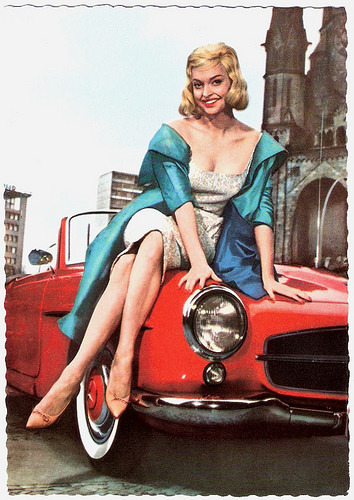
German postcard by Ufa, Berlin-Tempelhoff, no. CK-170. Photo: Klaus Collignon / Ufa. Publicity still for Das Mädchen Rosemarie/The Girl Rosemarie (Rolf Thiele, 1958).
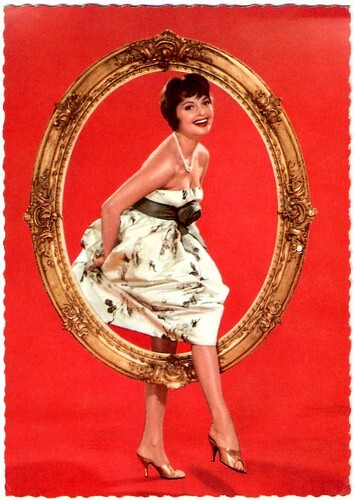
German postcard by Ufa, Berlin-Tempelhoff, no. CK 216. Photo: Klaus Collignon / Ufa.
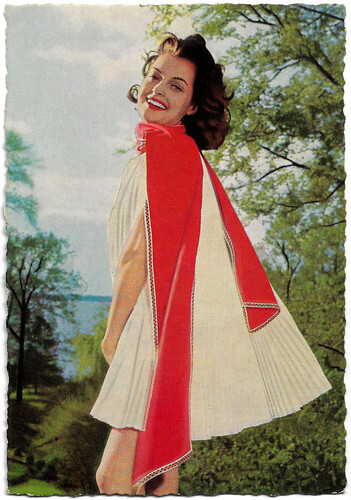
German postcard by WS-Druck, Wanne-Eickel, no. F 46. Photo: Klaus Collignon.
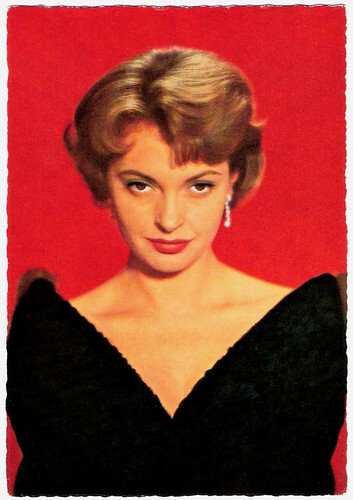
German postcard by WS-Druck, Wanne-Eickel, no. F 136. Photo: DEB-Paris.
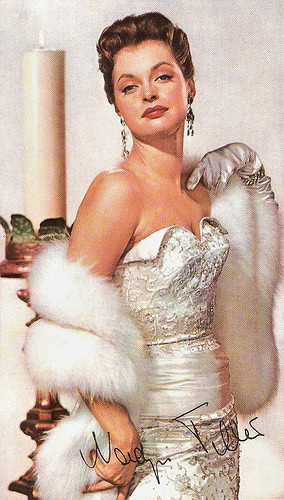
German promotion card for Luxor.
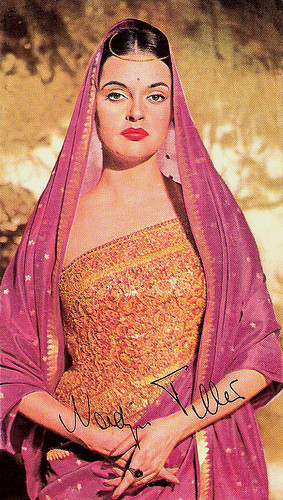
German promotion card for Lux Soap.
Miss Austria
Maria Nadja Tiller was born into a theatrical family in Vienna, Austria, in 1929. Her parents were the actor Anton Tiller and the operetta singer and actress Erika Körner.
From 1945 on, she studied at the Max-Reinhardt-Seminar and till 1949 at the Musik- und Schauspielakademie. She got an engagement at the Theater in der Josefstadt.
Meanwhile, she also worked as a model, and won the Miss Austria contest twice, in 1949 and 1951. The Miss Austria title caused her dismissal at the Theater in der Josefstadt, but it turned out to be her ticket into filmmaking.
In 1949, she acted opposite O.W. Fischer in Märchen vom Glück/Kiss Me Casanova (Arthur de Glahs, 1949). Many roles as a vamp in German and Austrian light entertainment films followed.
In 1954 she worked with director Rolf Thiele in the successful romantic comedy Sie/She with Marina Vlady . Her next film for Thiele, Die Barrings/The Barrings (1955) with Dieter Borsche , became her artistic breakthrough. Until 1970 Thiele and Tiller would make eleven films together, including Friederike von Barring (1956) and Lulu/No Orchids for Lulu (1962), with Mario Adorf .
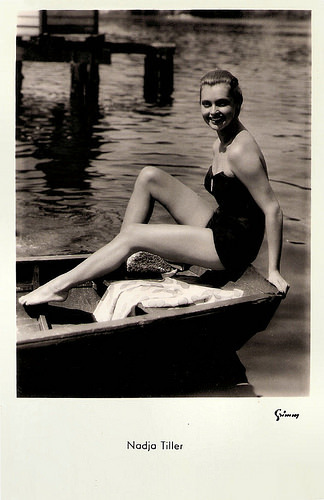
French postcard by Editions P.I., Paris, no. FK 3814. Photo: Arthur Grimm / Ufa.
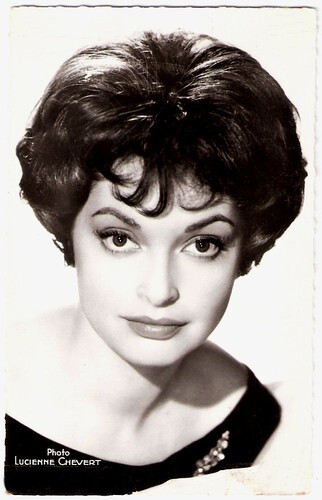
French postcard by Editions du Globe (E.D.U.G.), Paris, no. 812. Photo: Lucienne Chevert.
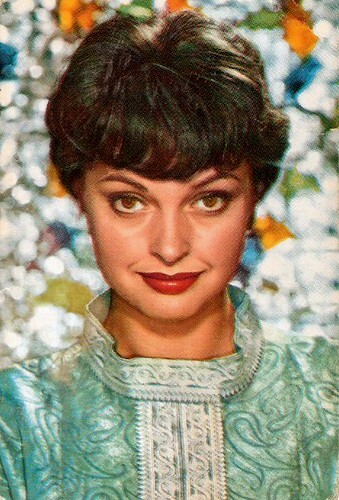
Belgian collectors card, no. 81. Photo: Klaus Collignon.
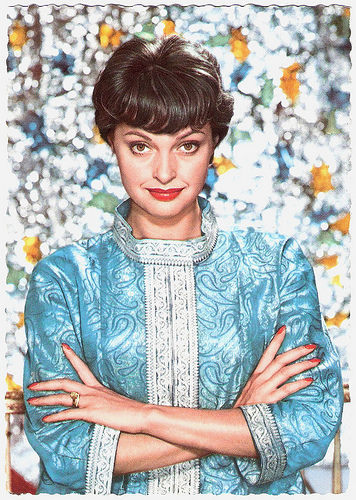
German postcard by Ufa, Berlin-Tempelhof, no. CK-215. Photo: Klaus Collignon / Ufa.
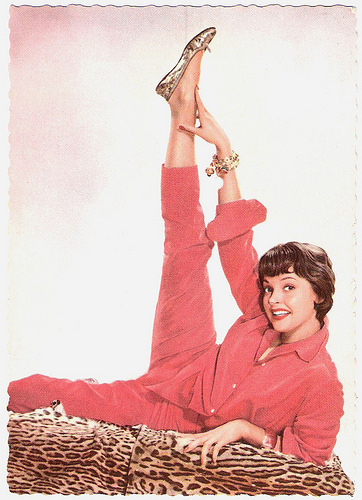
German postcard by Ufa, Berlin-Tempelhof, no. CK-205. Photo: Klaus Collignon / Ufa.
Scandal
Nadja Tiller’s international breakthrough role was that of the high-class prostitute Rosemarie Nitribitt in Das Mädchen Rosemarie/Rosemary (Rolf Thiele, 1958). The film, based on a murder scandal of the year before, was a huge, international success. It confirmed the assumption of post-war, American audiences that European actresses were somehow more sensuous and erotic than their Hollywood counterparts.
Tiller won the Best Actress award at the Film Festival of Venice for the role. There she was offered roles in Antonioni's La Notte (1961), Fellini's La dolce vita (1960), and Visconti's Rocco e i suoi fratelli/Rocco and his Brothers (1960), but she had to decline all three for familiar reasons. She was pregnant.
Later she would appear at the side of such international stars as Jean Gabin , Jean-Paul Belmondo , Rod Steiger, Yul Brynner and Michael Caine , but it did never bring her the status that she could have had with the three roles she had to say no to.
She did appear in the international productions The Rough and the Smooth (Robert Siodmak, 1959), Du Rififi chez les femmes/Rififi Among the Women (Alex Joffé, 1959) with Robert Hossein , An einem Freitag um halb zwölf/On Friday at Eleven (Alvin Rakoff, 1961), L'Affaire Nina B./The Nina B. Affair (Robert Siodmak, 1961), the thriller La chambre ardente/The Burning Court (Julien Duvivier, 1962), and Anima nera/Black Soul (Roberto Rossellini, 1962) with Vittorio Gassman , and she stayed popular among the art house public.
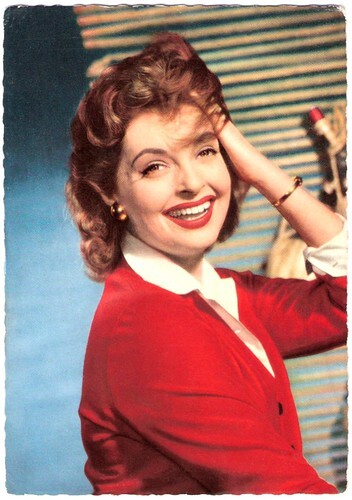
German postcard by Ufa (Universum-Film Aktiengesellschaft), Berlin-Tempelhof, no. CK-123. Photo: Arthur Grimm / Ufa.
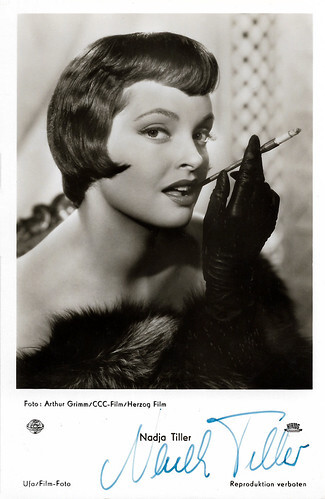
West German postcard by Ufa/Film-Foto, Berlin-Tempelhof, no. FK 1778. Photo: Arthur Grimm / CCC-Film / Herzog Film.
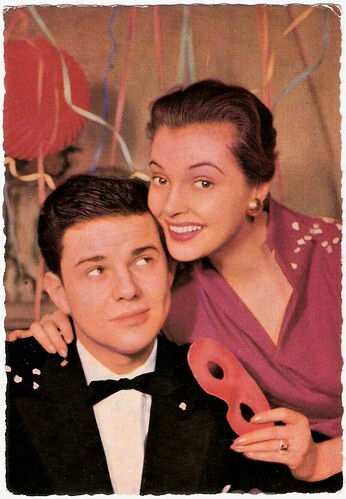
With husband Walter Giller . German postcard by WS-Druck, Wanne-Eickel, no. F 47. Photo: Huster.
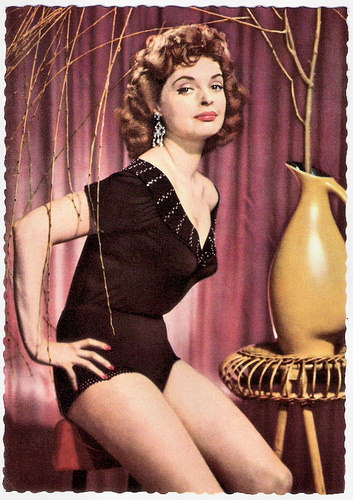
German postcard by Ufa, Berlin-Tempelhof, no. CK-14. Photo: Arthur Grimm.
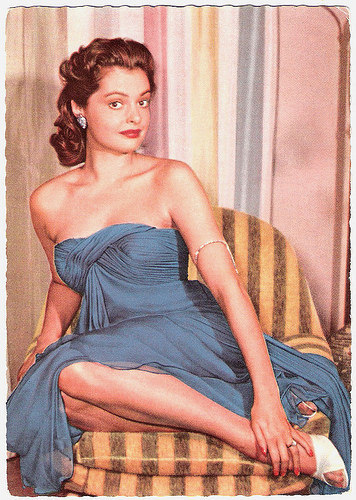
German postcard by Ufa, Berlin-Tempelhof, no. CK-106. Photo: Eberhardt Schmidt / Ufa.
Traumpaar
Nadja Tiller acted in more than 70 films, but since the 1970s she works mainly in theatre and television. During the 1970s and 1980s, she worked for theatres in Lübeck, Berlin and Vienna. A great success was her leading role in the Kurt Weill musical Lady in the Dark.
In 1997 she appeared at the Hamburger Kammerspielen as the elder Hollywood diva Joan Crawford in the play Nächte mit Joan (Nights with Joan) by Cas Enklaar. A year later she also starred in the TV adaptation directed by Horst Königstein with Rita Tushingham as Bette Davis.
Her most recent feature films were the Road movie Barfuss/Barefoot (Til Schweiger, 2005) in which she played the mother of the main character played by director Til Schweiger himself, and the crime comedy Dinosaurier/Dinosaurs (Leander Haussmann, 2009) with Eva-Maria Hagen .
In 1956, Nadja Tiller married actor Walter Giller , whom she had met at the set of the music film Schlagerparade/Hit Parade (Erik Ode, 1953). They were called the 'Traumpaar der Wirtschaftswunder-Ära' (Dream Couple of the Wirtschaftswunder era) in the 1950s and often worked together. They had two children, Natascha (1959) and Jan-Claudius (1964).
Nadja Tiller was honoured with many awards, including the Bundesverdienstkreuz (Germany's Cross of Merit) in 2000. Together with her husband, she received a Bambi Lifetime Achievement Award in 2005. Giller died of cancer in 2011, at the age of 84. From then on, Nadja Tiller lived in a retirement home in Hamburg. There, she passed away twelve years later, at the age of 93. Nadja Tiller acted in more than 70 films.
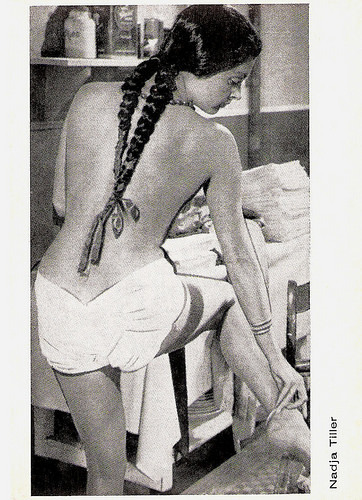
Vintage card.
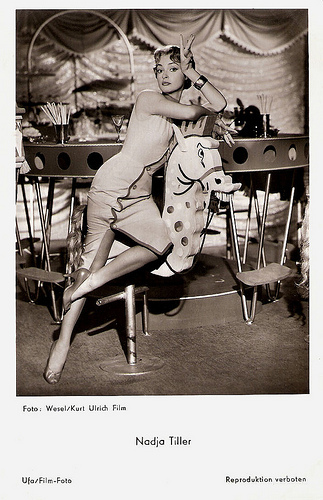
German postcard by Universum-Film Aktiengesellschaft (Ufa), Berlin-Tempelhof, no. FK 3842. Retail price: 25 Pfg. Photo: Wesel / Kurt Ulrich Film. Publicity still for 3 Mann auf einem Pferd/Three Men on a Horse (Kurt Meisel, 1957).
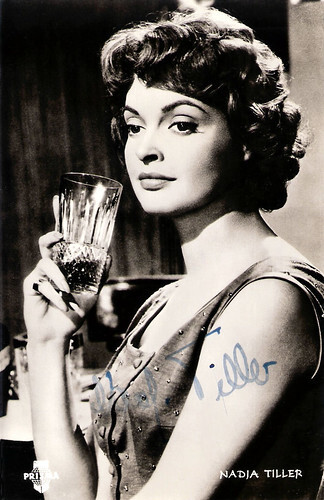
West German postcard by Vereinigte Verlagsgesellschaften Franke & Co, München, no. 93. Photo: Orex / Prisma. Nadja Tiller in Le désordre et la nuit/Night Affair (Gilles Grangier, 1958).
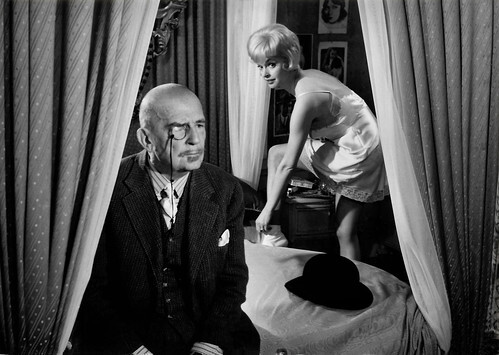
Belgian press photo. Nadja Tiller in Lulu/No Orchids for Lulu (Rolf Thiele, 1962).
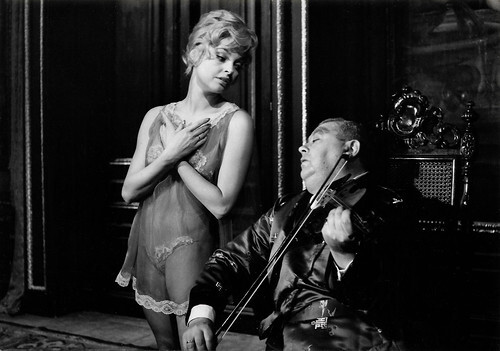
Belgian press photo. Nadja Tiller and Leon Askin in Lulu/No Orchids for Lulu (Rolf Thiele, 1962).
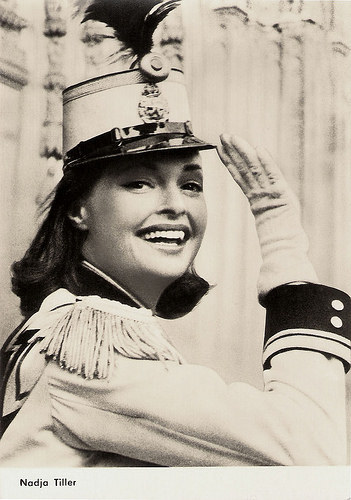
East-German postcard by VEB Progress Film-Vertrieb, Berlin, no. 2476, 1965.
Sources: Dieter Bartetzko (Frankfurter Allgemeine - German), Christian Schröder (Der Tagesspiegel - German), Stephanie D'heil (Steffi-line -German), Filmportal.de (German), , and Wikipedia.

German postcard by Ufa, Berlin-Tempelhoff, no. CK-170. Photo: Klaus Collignon / Ufa. Publicity still for Das Mädchen Rosemarie/The Girl Rosemarie (Rolf Thiele, 1958).

German postcard by Ufa, Berlin-Tempelhoff, no. CK 216. Photo: Klaus Collignon / Ufa.

German postcard by WS-Druck, Wanne-Eickel, no. F 46. Photo: Klaus Collignon.

German postcard by WS-Druck, Wanne-Eickel, no. F 136. Photo: DEB-Paris.

German promotion card for Luxor.

German promotion card for Lux Soap.
Miss Austria
Maria Nadja Tiller was born into a theatrical family in Vienna, Austria, in 1929. Her parents were the actor Anton Tiller and the operetta singer and actress Erika Körner.
From 1945 on, she studied at the Max-Reinhardt-Seminar and till 1949 at the Musik- und Schauspielakademie. She got an engagement at the Theater in der Josefstadt.
Meanwhile, she also worked as a model, and won the Miss Austria contest twice, in 1949 and 1951. The Miss Austria title caused her dismissal at the Theater in der Josefstadt, but it turned out to be her ticket into filmmaking.
In 1949, she acted opposite O.W. Fischer in Märchen vom Glück/Kiss Me Casanova (Arthur de Glahs, 1949). Many roles as a vamp in German and Austrian light entertainment films followed.
In 1954 she worked with director Rolf Thiele in the successful romantic comedy Sie/She with Marina Vlady . Her next film for Thiele, Die Barrings/The Barrings (1955) with Dieter Borsche , became her artistic breakthrough. Until 1970 Thiele and Tiller would make eleven films together, including Friederike von Barring (1956) and Lulu/No Orchids for Lulu (1962), with Mario Adorf .

French postcard by Editions P.I., Paris, no. FK 3814. Photo: Arthur Grimm / Ufa.

French postcard by Editions du Globe (E.D.U.G.), Paris, no. 812. Photo: Lucienne Chevert.

Belgian collectors card, no. 81. Photo: Klaus Collignon.

German postcard by Ufa, Berlin-Tempelhof, no. CK-215. Photo: Klaus Collignon / Ufa.

German postcard by Ufa, Berlin-Tempelhof, no. CK-205. Photo: Klaus Collignon / Ufa.
Scandal
Nadja Tiller’s international breakthrough role was that of the high-class prostitute Rosemarie Nitribitt in Das Mädchen Rosemarie/Rosemary (Rolf Thiele, 1958). The film, based on a murder scandal of the year before, was a huge, international success. It confirmed the assumption of post-war, American audiences that European actresses were somehow more sensuous and erotic than their Hollywood counterparts.
Tiller won the Best Actress award at the Film Festival of Venice for the role. There she was offered roles in Antonioni's La Notte (1961), Fellini's La dolce vita (1960), and Visconti's Rocco e i suoi fratelli/Rocco and his Brothers (1960), but she had to decline all three for familiar reasons. She was pregnant.
Later she would appear at the side of such international stars as Jean Gabin , Jean-Paul Belmondo , Rod Steiger, Yul Brynner and Michael Caine , but it did never bring her the status that she could have had with the three roles she had to say no to.
She did appear in the international productions The Rough and the Smooth (Robert Siodmak, 1959), Du Rififi chez les femmes/Rififi Among the Women (Alex Joffé, 1959) with Robert Hossein , An einem Freitag um halb zwölf/On Friday at Eleven (Alvin Rakoff, 1961), L'Affaire Nina B./The Nina B. Affair (Robert Siodmak, 1961), the thriller La chambre ardente/The Burning Court (Julien Duvivier, 1962), and Anima nera/Black Soul (Roberto Rossellini, 1962) with Vittorio Gassman , and she stayed popular among the art house public.

German postcard by Ufa (Universum-Film Aktiengesellschaft), Berlin-Tempelhof, no. CK-123. Photo: Arthur Grimm / Ufa.

West German postcard by Ufa/Film-Foto, Berlin-Tempelhof, no. FK 1778. Photo: Arthur Grimm / CCC-Film / Herzog Film.

With husband Walter Giller . German postcard by WS-Druck, Wanne-Eickel, no. F 47. Photo: Huster.

German postcard by Ufa, Berlin-Tempelhof, no. CK-14. Photo: Arthur Grimm.

German postcard by Ufa, Berlin-Tempelhof, no. CK-106. Photo: Eberhardt Schmidt / Ufa.
Traumpaar
Nadja Tiller acted in more than 70 films, but since the 1970s she works mainly in theatre and television. During the 1970s and 1980s, she worked for theatres in Lübeck, Berlin and Vienna. A great success was her leading role in the Kurt Weill musical Lady in the Dark.
In 1997 she appeared at the Hamburger Kammerspielen as the elder Hollywood diva Joan Crawford in the play Nächte mit Joan (Nights with Joan) by Cas Enklaar. A year later she also starred in the TV adaptation directed by Horst Königstein with Rita Tushingham as Bette Davis.
Her most recent feature films were the Road movie Barfuss/Barefoot (Til Schweiger, 2005) in which she played the mother of the main character played by director Til Schweiger himself, and the crime comedy Dinosaurier/Dinosaurs (Leander Haussmann, 2009) with Eva-Maria Hagen .
In 1956, Nadja Tiller married actor Walter Giller , whom she had met at the set of the music film Schlagerparade/Hit Parade (Erik Ode, 1953). They were called the 'Traumpaar der Wirtschaftswunder-Ära' (Dream Couple of the Wirtschaftswunder era) in the 1950s and often worked together. They had two children, Natascha (1959) and Jan-Claudius (1964).
Nadja Tiller was honoured with many awards, including the Bundesverdienstkreuz (Germany's Cross of Merit) in 2000. Together with her husband, she received a Bambi Lifetime Achievement Award in 2005. Giller died of cancer in 2011, at the age of 84. From then on, Nadja Tiller lived in a retirement home in Hamburg. There, she passed away twelve years later, at the age of 93. Nadja Tiller acted in more than 70 films.

Vintage card.

German postcard by Universum-Film Aktiengesellschaft (Ufa), Berlin-Tempelhof, no. FK 3842. Retail price: 25 Pfg. Photo: Wesel / Kurt Ulrich Film. Publicity still for 3 Mann auf einem Pferd/Three Men on a Horse (Kurt Meisel, 1957).

West German postcard by Vereinigte Verlagsgesellschaften Franke & Co, München, no. 93. Photo: Orex / Prisma. Nadja Tiller in Le désordre et la nuit/Night Affair (Gilles Grangier, 1958).

Belgian press photo. Nadja Tiller in Lulu/No Orchids for Lulu (Rolf Thiele, 1962).

Belgian press photo. Nadja Tiller and Leon Askin in Lulu/No Orchids for Lulu (Rolf Thiele, 1962).

East-German postcard by VEB Progress Film-Vertrieb, Berlin, no. 2476, 1965.
Sources: Dieter Bartetzko (Frankfurter Allgemeine - German), Christian Schröder (Der Tagesspiegel - German), Stephanie D'heil (Steffi-line -German), Filmportal.de (German), , and Wikipedia.
Published on February 21, 2023 22:00
February 20, 2023
Antonio Moreno
Antonio 'Tony' Moreno (1887-1967) was a Spanish-born American actor and film director of the silent film era and through the 1950s. In his early films, Moreno was often typecast as the suave, smouldering 'Latin Lover' and was seen as a serious rival to Rudolph Valentino. He was equally adept at romance, melodrama or comedy and is best known for films such as The Spanish Dancer (1923) with Pola Negri, Mare Nostrum (1926) with Alice Terry, The Temptress (1926) with Greta Garbo, and It (1927) with Clara Bow.
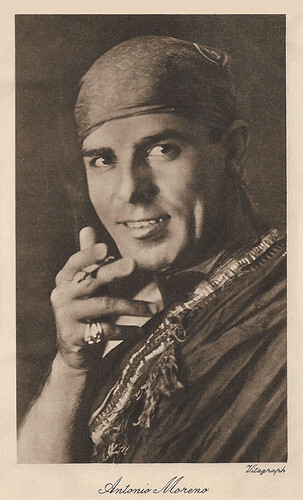
British postcard in the Cinema Chat Series. Photo: Vitagraph.
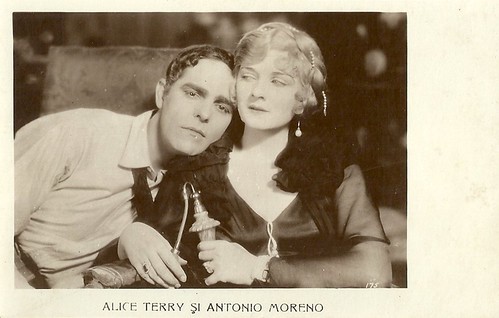
Romanian postcard. Photo: MGM. Antonio Moreno and Alice Terry in Mare Nostrum (Rex Ingram, 1926).
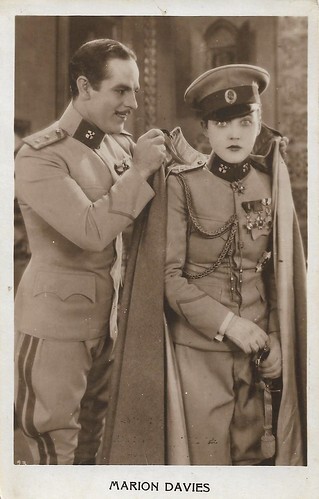
Romanian postcard. Photo: MGM. Marion Davies and Antonio Moreno in Beverly of Graustark (Sidney Franklin, 1926).
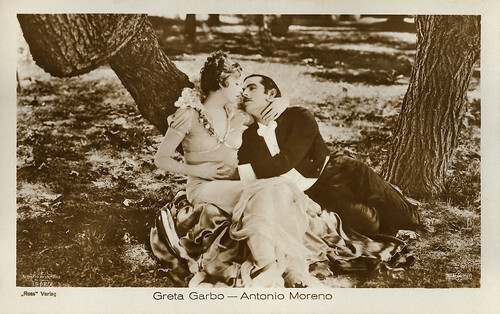
German postcard by Ross Verlag, no. 3062/2, 1928-1929. Photo: Metro-Goldwyn-Mayer / Parufamet. Greta Garbo and Antonio Moreno in The Temptress (Fred Niblo, Mauritz Stiller, 1926).
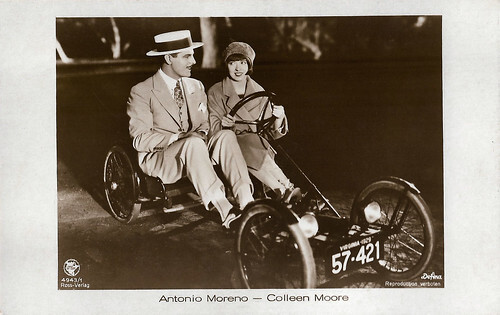
German postcard by Ross Verlag, no. 4943/1, 1929-1930. Photo: First National Pictures / Defina. Colleen Moore and Antonio Moreno in Synthetic Sin (William A. Seiter, 1929).
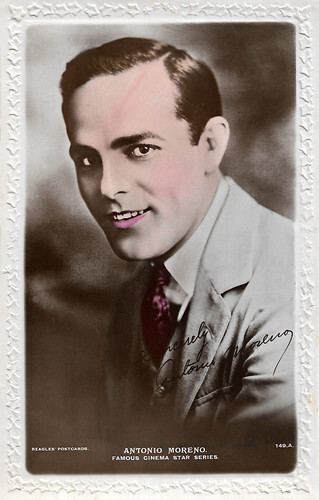
British postcard in the Famous Cinema Stars Series by J. Beagles & Co., London, no. 149. A.
King of the Cliff-hangers
Antonio Moreno was born Antonio Garrido Monteagudo in Madrid, Spain, in 1887. He came to America at the age of fourteen. Although he claimed to have attended Williston Northampton School in Easthampton, Massachusetts, the school's archives have no record of his having done so. His working life began as an employee of the Northhampton Electric Light and Gas Company.
He first acted on stage under the tutelage of Maude Adams whose theatre he had initially visited in order to fix the lighting. From the repertory stage in Massachusetts, he then made his way to Hollywood where he arrived in 1912. Having made his film debut in The Voice of the Millions (Stanner E.V. Taylor, 1912) at Rex-Universal, Moreno then featured as a top draw card for Vitagraph until 1921.
In 1914 Moreno appeared in major films such as Judith of Bethulia (D.W. Griffith, 1914), The Dust of Egypt (George D. Baker, 1915), and John Rance, Gentleman (Van Dyke Brooke, 1914) with Norma Talmadge . Within a short time, he became a star through his appearances opposite Talmadge.
Alongside Ramón Novarro and above all Rudolph Valentino , Moreno rose to become one of the most popular Latin lovers of the silent film era because of his southern good looks. In the process, he acquired a large female fan base. He proudly held the sobriquet "King of the Cliff-hangers" because of his prolific work in serials as co-star to Pearl White .
In the early 1920s, Moreno joined the cinema company Cineplex Entertainment and became one of its highest-paid performers. The pinnacle of his career came a few years later under contract to Famous Players Lasky/Paramount (from 1923 to 1924) and at Metro-Goldwyn-Mayer (in 1926). His film partners included Bebe Daniels in the film version of the Broadway comedy The Exciters (Maurice Campbell, 1923), Pola Negri in The Spanish Dancer (Herbert Brenon, 1923), Greta Garbo in The Temptress (Fred Niblo, Mauritz Stiller, 1926) and Clara Bow in It (Clarence G. Badger, 1927). The comedy It in particular was a huge box office success and featured Moreno as a department store heir who turns the heads of all the shop assistants.
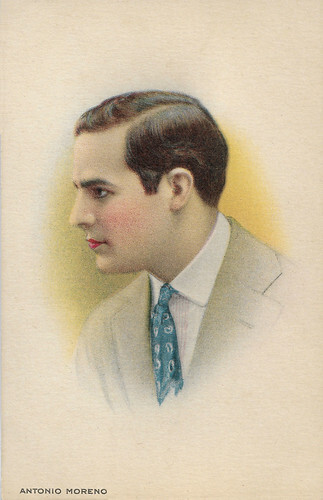
American postcard by Kline Poster Co.
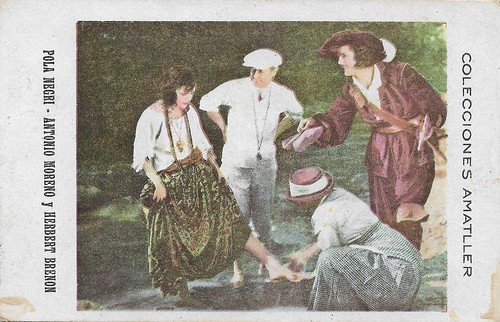
Spanish collectors card by Chocolate Amatller, Series C, Artist no. 4, no. 18. Pola Negri , Antonio Moreno and director Herbert Brenon while shooting the silent film The Spanish Dancer (Herbert Brenon, 1923).
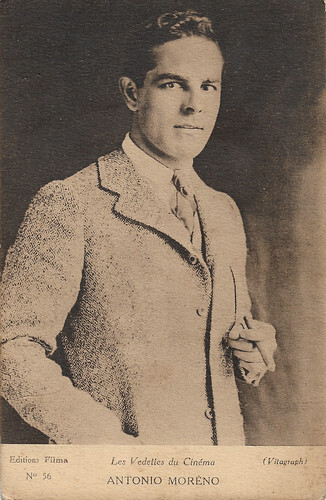
French postcard in the Les Vedettes du Cinéma Series by Ed. Filma, no. 56. Photo: Vitagraph.
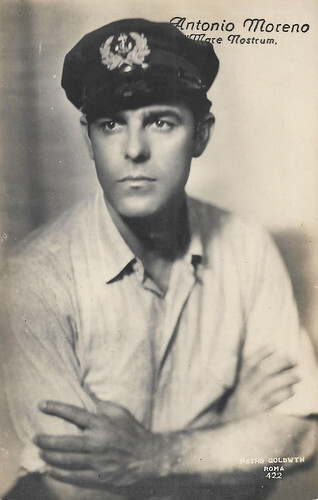
Italian postcard by Ballerini & Fratini, Florence, no. 422. Photo: Metro-Goldwyn, Roma. Antonio Moreno in Mare Nostrum (Rex Ingram, 1926).
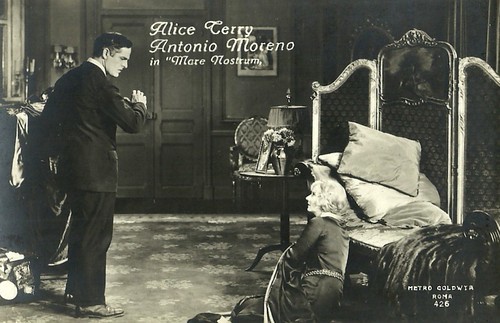
Italian postcard by Ballerini & Fratini, Florence, no. 426. Photo: Metro-Goldwyn, Roma. Antonio Moreno and Alice Terry in Mare Nostrum (Rex Ingram, 1926).
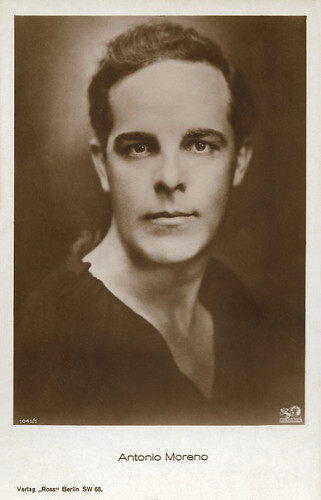
German postcard by Ross Verlag, Berlin, no. 1041/1, 1927-1928. Photo: Phoebus Film.
The cheaply produced horror film became a cult classic
In the 1920s, Antonio Moreno was one of the highest-paid actors in Hollywood. With the advent of sound pictures, his career suffered a sharp decline, in no small measure due to a heavy Spanish accent. He made only a few films in Hollywood during this period and instead worked increasingly in Mexican productions.
During the early 1930s, he also directed several films there, such as the first Mexican sound film Santa (Antonio Moreno, 1932) and the drama Águilas frente al sol/Eagles across the Sun (Antonio Moreno, 1932). Moreno tried to rebuild his Hollywood career as early as the 1930s, including an appearance in the Laurel and Hardy film The Bohemian Girl (James W. Horne, Charley Rogers, 1936) where his character has an affair with Oliver Hardy 's wife.
But it wasn't until the mid-1940s that he returned to better roles in American films, including as a character actor in The Captain of Castile (Henry King, 1947) starring Tyrone Power . In 1954, the veteran star took the lead role in the cheaply produced horror film Creature from the Black Lagoon (Jack Arnold, 1954), which became a cult classic over the years.
His last significant appearance was in John Ford's Western epic The Searchers (John Ford, 1956), where he played a Mexican who showed John Wayne and Jeffrey Hunter the way to an Indian chief. Nonetheless, he eventually segued into character parts and remained gainfully employed in the industry until the late 1950s. He was awarded a Star on the Hollywood Walk of Fame at 6651 Hollywood Boulevard in Hollywood, California in 1960.
Moreno was married in 1923 to Daisy Danziger, the daughter of an oil millionaire. Their lavish mansion, called 'Paramour', was one of the largest in Hollywood and the site of many famous parties. Ten years later, Daisy died in 1933 in a tragic car crash near Mulholland Drive. Antonio Moreno passed away in 1967 in Beverly Hills. Following his death from heart failure, he was interred at Forest Lawn Memorial Park in Glendale, California.
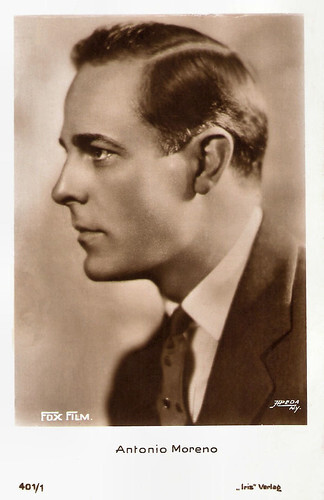
Austrian postcard by Iris Verlag, no. 401/1. Photo: Apeda (Alexander W. Dreyfoos), New York / Fox Film.
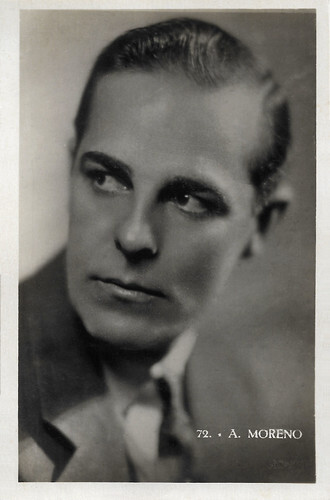
Italian postcard by Foto Ebany (?), no. 72.
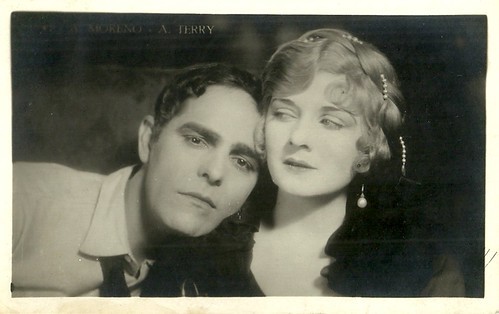
Italian postcard by Foto Ebany, sent by mail in 1927. Photo: MGM Antonio Moreno and Alice Terry in Mare Nostrum (Rex Ingram, 1926).
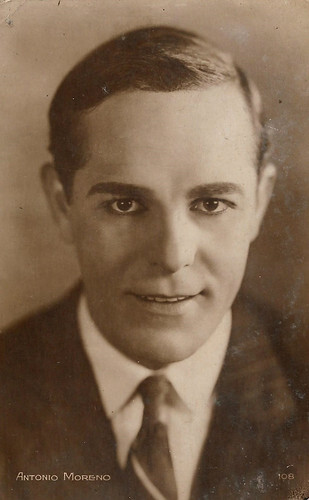
French postcard by Editions Cinémagazine, no. 108.
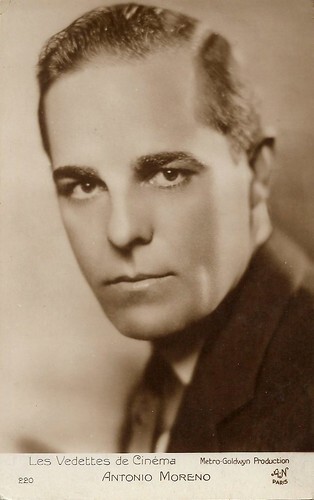
French postcard by A.N., Paris, in the Les vedettes de cinéma series, no. 220. Photo: Metro-Goldwyn.

American Arcade postcard by Ex.[Exhibit] Sup[ply]. Co., Chicago, USA, 1928.
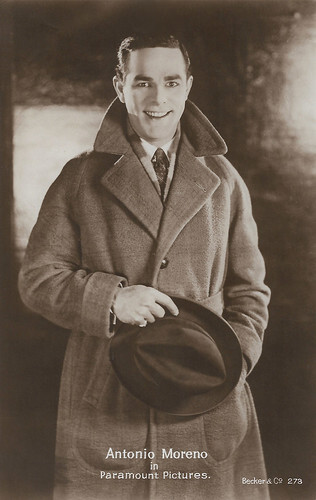
German postcard by Becker & Co., no. 273. Photo: Paramount Pictures.
Sources: (IMDb), Wikipedia (German and English) and .

British postcard in the Cinema Chat Series. Photo: Vitagraph.

Romanian postcard. Photo: MGM. Antonio Moreno and Alice Terry in Mare Nostrum (Rex Ingram, 1926).

Romanian postcard. Photo: MGM. Marion Davies and Antonio Moreno in Beverly of Graustark (Sidney Franklin, 1926).

German postcard by Ross Verlag, no. 3062/2, 1928-1929. Photo: Metro-Goldwyn-Mayer / Parufamet. Greta Garbo and Antonio Moreno in The Temptress (Fred Niblo, Mauritz Stiller, 1926).

German postcard by Ross Verlag, no. 4943/1, 1929-1930. Photo: First National Pictures / Defina. Colleen Moore and Antonio Moreno in Synthetic Sin (William A. Seiter, 1929).

British postcard in the Famous Cinema Stars Series by J. Beagles & Co., London, no. 149. A.
King of the Cliff-hangers
Antonio Moreno was born Antonio Garrido Monteagudo in Madrid, Spain, in 1887. He came to America at the age of fourteen. Although he claimed to have attended Williston Northampton School in Easthampton, Massachusetts, the school's archives have no record of his having done so. His working life began as an employee of the Northhampton Electric Light and Gas Company.
He first acted on stage under the tutelage of Maude Adams whose theatre he had initially visited in order to fix the lighting. From the repertory stage in Massachusetts, he then made his way to Hollywood where he arrived in 1912. Having made his film debut in The Voice of the Millions (Stanner E.V. Taylor, 1912) at Rex-Universal, Moreno then featured as a top draw card for Vitagraph until 1921.
In 1914 Moreno appeared in major films such as Judith of Bethulia (D.W. Griffith, 1914), The Dust of Egypt (George D. Baker, 1915), and John Rance, Gentleman (Van Dyke Brooke, 1914) with Norma Talmadge . Within a short time, he became a star through his appearances opposite Talmadge.
Alongside Ramón Novarro and above all Rudolph Valentino , Moreno rose to become one of the most popular Latin lovers of the silent film era because of his southern good looks. In the process, he acquired a large female fan base. He proudly held the sobriquet "King of the Cliff-hangers" because of his prolific work in serials as co-star to Pearl White .
In the early 1920s, Moreno joined the cinema company Cineplex Entertainment and became one of its highest-paid performers. The pinnacle of his career came a few years later under contract to Famous Players Lasky/Paramount (from 1923 to 1924) and at Metro-Goldwyn-Mayer (in 1926). His film partners included Bebe Daniels in the film version of the Broadway comedy The Exciters (Maurice Campbell, 1923), Pola Negri in The Spanish Dancer (Herbert Brenon, 1923), Greta Garbo in The Temptress (Fred Niblo, Mauritz Stiller, 1926) and Clara Bow in It (Clarence G. Badger, 1927). The comedy It in particular was a huge box office success and featured Moreno as a department store heir who turns the heads of all the shop assistants.

American postcard by Kline Poster Co.

Spanish collectors card by Chocolate Amatller, Series C, Artist no. 4, no. 18. Pola Negri , Antonio Moreno and director Herbert Brenon while shooting the silent film The Spanish Dancer (Herbert Brenon, 1923).

French postcard in the Les Vedettes du Cinéma Series by Ed. Filma, no. 56. Photo: Vitagraph.

Italian postcard by Ballerini & Fratini, Florence, no. 422. Photo: Metro-Goldwyn, Roma. Antonio Moreno in Mare Nostrum (Rex Ingram, 1926).

Italian postcard by Ballerini & Fratini, Florence, no. 426. Photo: Metro-Goldwyn, Roma. Antonio Moreno and Alice Terry in Mare Nostrum (Rex Ingram, 1926).

German postcard by Ross Verlag, Berlin, no. 1041/1, 1927-1928. Photo: Phoebus Film.
The cheaply produced horror film became a cult classic
In the 1920s, Antonio Moreno was one of the highest-paid actors in Hollywood. With the advent of sound pictures, his career suffered a sharp decline, in no small measure due to a heavy Spanish accent. He made only a few films in Hollywood during this period and instead worked increasingly in Mexican productions.
During the early 1930s, he also directed several films there, such as the first Mexican sound film Santa (Antonio Moreno, 1932) and the drama Águilas frente al sol/Eagles across the Sun (Antonio Moreno, 1932). Moreno tried to rebuild his Hollywood career as early as the 1930s, including an appearance in the Laurel and Hardy film The Bohemian Girl (James W. Horne, Charley Rogers, 1936) where his character has an affair with Oliver Hardy 's wife.
But it wasn't until the mid-1940s that he returned to better roles in American films, including as a character actor in The Captain of Castile (Henry King, 1947) starring Tyrone Power . In 1954, the veteran star took the lead role in the cheaply produced horror film Creature from the Black Lagoon (Jack Arnold, 1954), which became a cult classic over the years.
His last significant appearance was in John Ford's Western epic The Searchers (John Ford, 1956), where he played a Mexican who showed John Wayne and Jeffrey Hunter the way to an Indian chief. Nonetheless, he eventually segued into character parts and remained gainfully employed in the industry until the late 1950s. He was awarded a Star on the Hollywood Walk of Fame at 6651 Hollywood Boulevard in Hollywood, California in 1960.
Moreno was married in 1923 to Daisy Danziger, the daughter of an oil millionaire. Their lavish mansion, called 'Paramour', was one of the largest in Hollywood and the site of many famous parties. Ten years later, Daisy died in 1933 in a tragic car crash near Mulholland Drive. Antonio Moreno passed away in 1967 in Beverly Hills. Following his death from heart failure, he was interred at Forest Lawn Memorial Park in Glendale, California.

Austrian postcard by Iris Verlag, no. 401/1. Photo: Apeda (Alexander W. Dreyfoos), New York / Fox Film.

Italian postcard by Foto Ebany (?), no. 72.

Italian postcard by Foto Ebany, sent by mail in 1927. Photo: MGM Antonio Moreno and Alice Terry in Mare Nostrum (Rex Ingram, 1926).

French postcard by Editions Cinémagazine, no. 108.

French postcard by A.N., Paris, in the Les vedettes de cinéma series, no. 220. Photo: Metro-Goldwyn.

American Arcade postcard by Ex.[Exhibit] Sup[ply]. Co., Chicago, USA, 1928.

German postcard by Becker & Co., no. 273. Photo: Paramount Pictures.
Sources: (IMDb), Wikipedia (German and English) and .
Published on February 20, 2023 22:00
February 19, 2023
Stella Harf
Stella Harf (1890-1979) was a German stage and screen actress, who had a career as a leading lady in German silent cinema in the late 1910s and early 1920s. She was married to actor-director-producer Ernst Reicher, and often played in his films, including several silent mysteries with the popular gentleman detective Stuart Webbs.

German postcard by Photochemie, Berlin, no. K.2328. Photo: Alba-Film.

German postcard by Photochemie, Berlin, no. K.2329. Photo: Alba-Film. Stella Harf and Bruno Kastner in Die Fürstin von Beranien/The Princess of Berania (Ernst Reicher, 1918).

German postcard by Photochemie, Berlin, no. K.2336. Photo: Atelier Eberth, Berlin.
Princess and Queen
Stella Harf was born in 1890 in Dresden, Germany, as Johanna Gertrud Weybrecht.
Harf began her artistic career in 1911 as a chorus singer at Berlin theatres and performed often at the Metropol Theatre. From 1916 to 1923 she was married to the actor, director and producer Ernst Reicher .
Her husband helped her to get leading roles in his films several times. From 1917 she appeared in these films under the stage name 'Stella Harf'. Mostly she played together with him, but Bruno Kastner , Hans Albers and Emil Jannings were also her partners.
In 1917 Harf had the female lead opposite Hans Albers and Josef Klein in Rauschgold/Intoxicating Gold (H. Derweyn, 1917), about a farmer's girl who dreams of the pros and cons of a rich marriage. She also appeared opposite Bruno Kastner , Emil Jannings and Lupu Pick in Das Geschäft/The Business (1917), scripted and directed by Ernst Reicher.
The next year, in 1918, Harf starred again opposite Kastner in Reicher's class drama Die Fürstin von Beranien/The Princess of Berania (1918) (Ernst Reicher, 1918). In 1919 Harf was Queen Esther opposite Reicher as King Ahasverus and Michael Bohnen as Haman in the elaborate production Das Buch Esther/The Book of Esther (Ernst Reicher, Uwe Jenss Kraft, 1919). This two-hour monumental German historical silent film is set in the time of biblical antiquity, with a partly strongly Philo-Semitic message.
Harf partnered Reicher in his Stuart Webbs detective film Der Sprung ins Dunkle/The Leap in the Dark (Ernst Reicher, 1920). Stuart Webbs was a fictional detective who appeared in a series of German films and serials during the silent era. Webbs was one of a number of detectives with English-sounding names to appear in German cinema of the era. Like his contemporaries such as Joe Deebs, he was modelled on Sherlock Holmes. Webbs was the most popular of the group. His original film series ran from 1914 to 1926, nearly always with Ernst Reicher as Webbs.
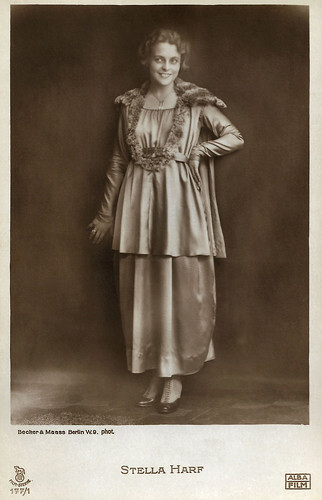
German postcard in the Film Sterne Series by Rotophot, no. 177/1. Photo: Alba-Film / Becker & Maass, Berlin.
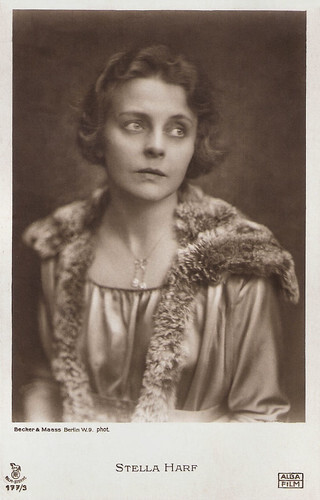
German postcard in the Film Sterne Series by Rotophot, no. 177/3. Photo: Alba-Film / Becker & Maass, Berlin.
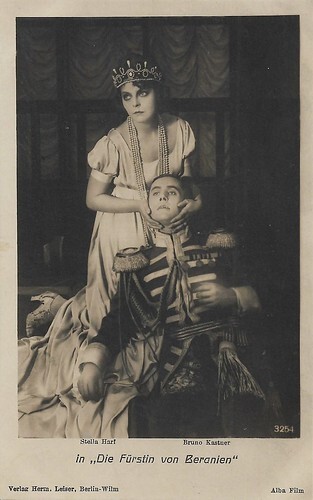
German postcard by Verlag Hermann Leiser, Berlin, no. 3254. Photo: Alba-Film. Stella Harf and Bruno Kastner in Die Fürstin von Beranien (Ernst Reicher, 1918).
Opposite detective Stuart Webbs
Stella Harf played opposite Fritz Greiner instead of Reicher as detective Webbs in the Stuart Webbs film Der Schrecken im Hause Ardon/Panic in the House of Ardon (Robert Wiene, 1920). In this film, a crime syndicate attempts to discover the scientific secrets of the chemical company Ardon. A chemist kills the gang leader (Ernst Stahl-Nachbaur), who has hypnotised the chemist's wife (Harf) to steal his invention. The film was made in the Expressionist style that had been used for Wiene's hit Das Cabinet des Dr. Caligari/The Cabinet of Dr. Caligari (Robert Wiene, 1920). The film was finished by August 1920, but did not have its premiere until July 1921.
Harf also starred in another film produced by Reicher's film company, Stuart Webbs-Film Company Reicher und Reicher, and directed by Wiene, Der verführte Heilige/The seduced saint (Robert Wiene, 1919). Max Obal directed Harf for Reicher's company in the Stuart Webbs detective film George Bully (Max Obal, 1920), this time with Reicher himself as the gentleman detective modelled on Sherlock Holmes. This silent mystery was the last collaboration between Reicher and Harf. In 1921 or 1922, Reicher had a serious car accident, in which he suffered a vertebral and fractured skull. Only in 1926, he appeared again on the screen, but he could no longer build on previous successes.
After Reicher's car accident and their divorce in 1923, Stella Harf faded into the background of the film world. She still did two films in 1921-1922: Der Schwur des Peter Hergatz/The Oath of Peter Hergatz (Alfred Halm, 1921) with Emil Jannings and Ernst Stahl-Nachbaur, and in Munich she made, Jägerblut/Hunter's Blood (Franz Seitz, 1922) with Josef Berger.
Three years later she acted in two films by Adolf Wenter, Professor Nardi/Eyes of Mystery (1925) and Der Frauenmarder/The lady marten (1925), both starring Ludwig Trautmann . These were her last major parts, apart from a bit part in Lupu Pick's late silent film Napoleon auf St. Helena/Napoleon at Saint Helena (Lupu Pick, 1929) starring Werner Krauss as Napoleon.
After the seizure of power in 1933 by the National Socialists, the Jewish Ernst Reicher emigrated to Prague, where he fell into obscurity. In 1936, he committed suicide by hanging in a Prague hotel room, After his tragic death, Harf was dependent on the support of state and semi-state institutions. Stella Harf passed away in 1979 in Berlin.
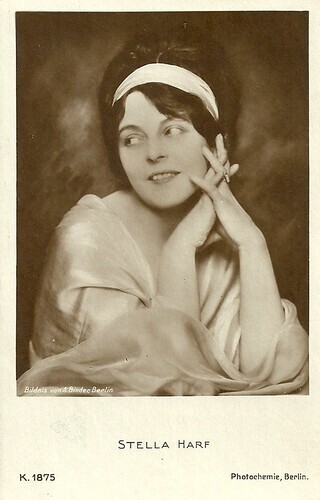
German postcard by Photochemie, Berlin, no. K.1875. Photo: Alex Binder, Berlin.
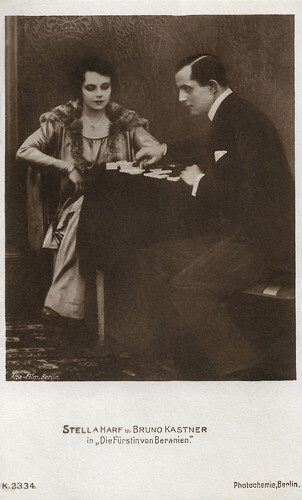
German postcard by Photochemie, Berlin, no. K.2334. Photo: Alba-Film, Berlin. Stella Harf and Bruno Kastner in Die Fürstin von Beranien (Ernst Reicher, 1918).
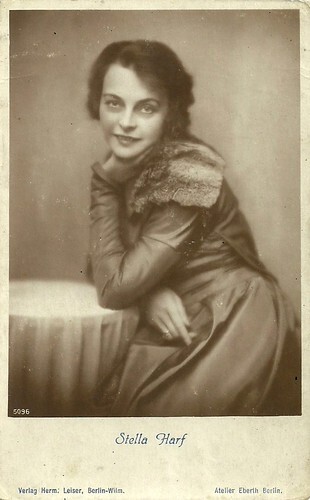
German postcard by Verlag Hermann Leiser, Berlin, no. 5096. Photo: Atelier Eberth, Berlin.
Sources: Stephanie D'heil (Steffi-line.de), Early Cinema, Wikipedia (German and English), and .
See also our blogpost about Die Fürstin von Beranien/The Princess of Berania (Ernst Reicher, 1918).

German postcard by Photochemie, Berlin, no. K.2328. Photo: Alba-Film.

German postcard by Photochemie, Berlin, no. K.2329. Photo: Alba-Film. Stella Harf and Bruno Kastner in Die Fürstin von Beranien/The Princess of Berania (Ernst Reicher, 1918).

German postcard by Photochemie, Berlin, no. K.2336. Photo: Atelier Eberth, Berlin.
Princess and Queen
Stella Harf was born in 1890 in Dresden, Germany, as Johanna Gertrud Weybrecht.
Harf began her artistic career in 1911 as a chorus singer at Berlin theatres and performed often at the Metropol Theatre. From 1916 to 1923 she was married to the actor, director and producer Ernst Reicher .
Her husband helped her to get leading roles in his films several times. From 1917 she appeared in these films under the stage name 'Stella Harf'. Mostly she played together with him, but Bruno Kastner , Hans Albers and Emil Jannings were also her partners.
In 1917 Harf had the female lead opposite Hans Albers and Josef Klein in Rauschgold/Intoxicating Gold (H. Derweyn, 1917), about a farmer's girl who dreams of the pros and cons of a rich marriage. She also appeared opposite Bruno Kastner , Emil Jannings and Lupu Pick in Das Geschäft/The Business (1917), scripted and directed by Ernst Reicher.
The next year, in 1918, Harf starred again opposite Kastner in Reicher's class drama Die Fürstin von Beranien/The Princess of Berania (1918) (Ernst Reicher, 1918). In 1919 Harf was Queen Esther opposite Reicher as King Ahasverus and Michael Bohnen as Haman in the elaborate production Das Buch Esther/The Book of Esther (Ernst Reicher, Uwe Jenss Kraft, 1919). This two-hour monumental German historical silent film is set in the time of biblical antiquity, with a partly strongly Philo-Semitic message.
Harf partnered Reicher in his Stuart Webbs detective film Der Sprung ins Dunkle/The Leap in the Dark (Ernst Reicher, 1920). Stuart Webbs was a fictional detective who appeared in a series of German films and serials during the silent era. Webbs was one of a number of detectives with English-sounding names to appear in German cinema of the era. Like his contemporaries such as Joe Deebs, he was modelled on Sherlock Holmes. Webbs was the most popular of the group. His original film series ran from 1914 to 1926, nearly always with Ernst Reicher as Webbs.

German postcard in the Film Sterne Series by Rotophot, no. 177/1. Photo: Alba-Film / Becker & Maass, Berlin.

German postcard in the Film Sterne Series by Rotophot, no. 177/3. Photo: Alba-Film / Becker & Maass, Berlin.

German postcard by Verlag Hermann Leiser, Berlin, no. 3254. Photo: Alba-Film. Stella Harf and Bruno Kastner in Die Fürstin von Beranien (Ernst Reicher, 1918).
Opposite detective Stuart Webbs
Stella Harf played opposite Fritz Greiner instead of Reicher as detective Webbs in the Stuart Webbs film Der Schrecken im Hause Ardon/Panic in the House of Ardon (Robert Wiene, 1920). In this film, a crime syndicate attempts to discover the scientific secrets of the chemical company Ardon. A chemist kills the gang leader (Ernst Stahl-Nachbaur), who has hypnotised the chemist's wife (Harf) to steal his invention. The film was made in the Expressionist style that had been used for Wiene's hit Das Cabinet des Dr. Caligari/The Cabinet of Dr. Caligari (Robert Wiene, 1920). The film was finished by August 1920, but did not have its premiere until July 1921.
Harf also starred in another film produced by Reicher's film company, Stuart Webbs-Film Company Reicher und Reicher, and directed by Wiene, Der verführte Heilige/The seduced saint (Robert Wiene, 1919). Max Obal directed Harf for Reicher's company in the Stuart Webbs detective film George Bully (Max Obal, 1920), this time with Reicher himself as the gentleman detective modelled on Sherlock Holmes. This silent mystery was the last collaboration between Reicher and Harf. In 1921 or 1922, Reicher had a serious car accident, in which he suffered a vertebral and fractured skull. Only in 1926, he appeared again on the screen, but he could no longer build on previous successes.
After Reicher's car accident and their divorce in 1923, Stella Harf faded into the background of the film world. She still did two films in 1921-1922: Der Schwur des Peter Hergatz/The Oath of Peter Hergatz (Alfred Halm, 1921) with Emil Jannings and Ernst Stahl-Nachbaur, and in Munich she made, Jägerblut/Hunter's Blood (Franz Seitz, 1922) with Josef Berger.
Three years later she acted in two films by Adolf Wenter, Professor Nardi/Eyes of Mystery (1925) and Der Frauenmarder/The lady marten (1925), both starring Ludwig Trautmann . These were her last major parts, apart from a bit part in Lupu Pick's late silent film Napoleon auf St. Helena/Napoleon at Saint Helena (Lupu Pick, 1929) starring Werner Krauss as Napoleon.
After the seizure of power in 1933 by the National Socialists, the Jewish Ernst Reicher emigrated to Prague, where he fell into obscurity. In 1936, he committed suicide by hanging in a Prague hotel room, After his tragic death, Harf was dependent on the support of state and semi-state institutions. Stella Harf passed away in 1979 in Berlin.

German postcard by Photochemie, Berlin, no. K.1875. Photo: Alex Binder, Berlin.

German postcard by Photochemie, Berlin, no. K.2334. Photo: Alba-Film, Berlin. Stella Harf and Bruno Kastner in Die Fürstin von Beranien (Ernst Reicher, 1918).

German postcard by Verlag Hermann Leiser, Berlin, no. 5096. Photo: Atelier Eberth, Berlin.
Sources: Stephanie D'heil (Steffi-line.de), Early Cinema, Wikipedia (German and English), and .
See also our blogpost about Die Fürstin von Beranien/The Princess of Berania (Ernst Reicher, 1918).
Published on February 19, 2023 22:00
February 18, 2023
Stella Stevens (1938-2023)
Yesterday, 17 February 2023, American actress Stella Stevens (1938) passed away from Alzheimer's disease. The comedienne starred as a voluptuous platinum blonde with a deep sultry voice in many Hollywood films of the 1960s. During the decade she was one of the most photographed women in the world. Stella Stevens was 84.
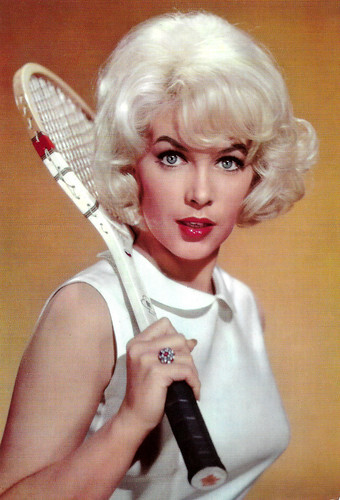
Spanish postcard by Raker, no. 1096, 1964. Stella Stevens in The Nutty Professor (Jerry Lewis, 1963).
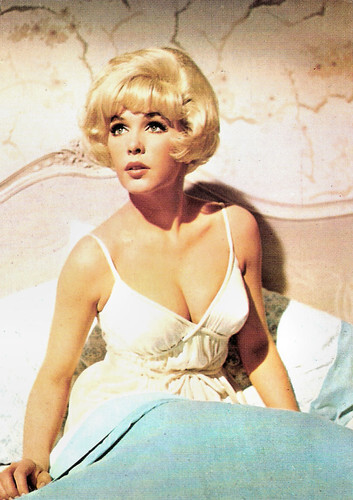
Romanian postcard by Casa Filmului Acin. Photo: publicity still for How to Save a Marriage and Ruin Your Life (Fielder Cook, 1968).
Appassionata Von Climax
Stella Stevens was born Estelle Caro Eggleston in Yazoo City, Mississippi, in 1938 (some sources say 1936). While attending Memphis State College, Stella became interested in acting and modelling.
While performing in a college production of 'Bus Stop', Stevens was discovered and offered a contract with 20th Century Fox. Her film debut was a bit part in the musical Say One for Me (Frank Tashlin, 1959), but her appearance in Li'l Abner (Melvin Frank, 1959) as Appassionata Von Climax is the one that got her noticed.
In 1960, she won the Golden Globe Award for New Star of the Year. Then her centrefold spread in Playboy magazine was one of the most popular issues.
In the following years, she co-starred with Bobby Darin in Too Late Blues (John Cassavetes, 1961), with Elvis Presley in Girls! Girls! Girls! (Norman Taurog, 1962), Jerry Lewis in The Nutty Professor (Jerry Lewis, 1963), and Dean Martin in the Matt Helm spy spoof The Silencers (Phil Karlson, 1966).
One of her best parts was Glenn Ford 's drum-playing girlfriend in The Courtship of Eddie’s Father (Vincente Minnelli, 1962). On TV, she appeared in the series Surfside 6 (1960), Ben Casey (1961) and the soap opera General Hospital (1963).
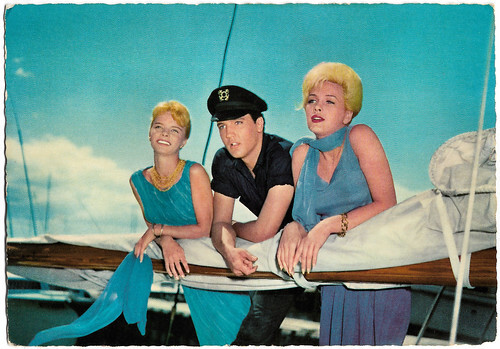
Vintage postcard, no. 3. Photo: Laurel Goodwin, Elvis Presley and Stella Stevens in Girls! Girls! Girls! (Norman Taurog, 1962).
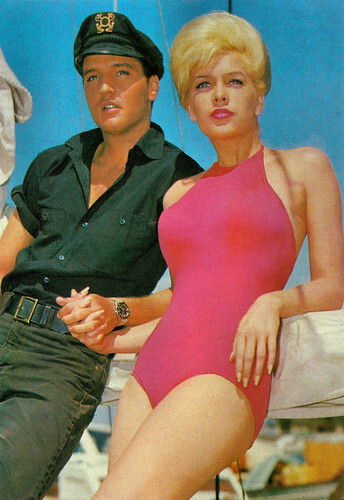
Spanish postcard by Postal Oscarcolor, no. 519. Photo: Elvis Presley and Stella Stevens in Girls! Girls! Girls! (Norman Taurog, 1962).
The refreshingly outspoken ex-prostitute wife
By the late 1960s, Stella Stevens' career had levelled off and she was appearing in roles based on her looks. Hal Erickson at AllMovie : "Despite consistently good work, Stevens never achieved the full stardom that she deserved: When she posed again for Playboy in 1968, she admitted that it was purely to get people to attend her films."
One of her best performances was opposite Jason Robards in Sam Peckinpah's The Ballad of Cable Hogue (1970), where she played Hildy, and showed that her talent was more than physical. In 1972 she starred in Irwin Allen's The Poseidon Adventure with Gene Hackman, Ernest Borgnine, Roddy McDowall, and Shelley Winters . Stevens played the role of Linda Rogo, the "refreshingly outspoken" ex-prostitute wife of Borgnine's character.
She also starred in Blaxploitation films like Slaughter (Jack Starrett, 1972) with Jim Brown as a black Vietnam Veteran and Cleopatra Jones and the Casino of Gold (Charles Bail, 1975) opposite Tamara Dobson. Notable is also the comedy Nickelodeon (Peter Bogdanovich, 1976), starring Ryan O'Neal.
In the 1970s and 1980s, Stella became a fixture in movies made for television and appeared in a number of television series. Her big screen career slowed during that time, but she continued to appear in a number of straight-to-video films. Stevens produced and directed a documentary profiling a variety of women from many walks of life, entitled The American Heroine (1979). She also directed the inexpensive Canadian feature The Ranch (1989). On TV, she appeared in the critically acclaimed miniseries, In Cold Blood (Jonathan Kaplan, 1996), based on Truman Capote's book of the same name. Her television career continued into the 2000s when she appeared in an episode of the sitcom Twenty Good Years (2006).
In 1954, the 16-year-old Stella Stevens married electrician Noble Herman Stephens and the couple had a son, actor Andrew Stevens. The couple divorced in 1957 but Stella and her son retained a variation of her ex-husband's surname as their own professional surnames. Stevens died from Alzheimer's disease in Los Angeles, California in 2023, at the age of 84.
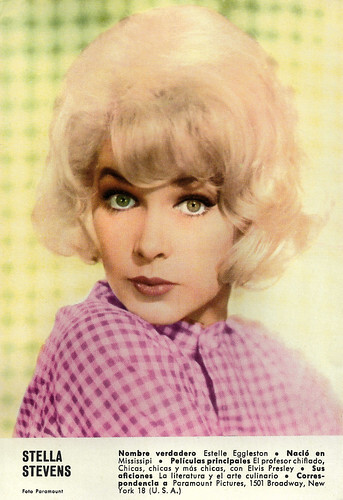
Spanish card. Photo: Paramount.
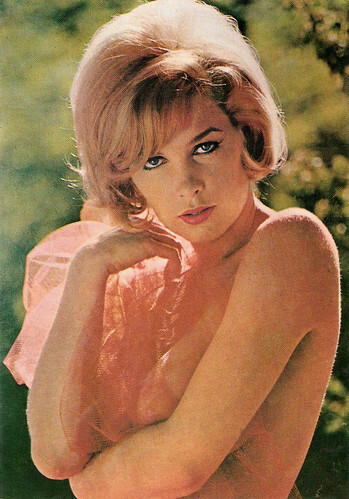
Italian postcard by Silvercart, Milano, no. 520/3.
Sources: (IMDb), Hal Erickson (AllMovie), Tony Macklin (Bright Lights Film Journal), Wikipedia and .

Spanish postcard by Raker, no. 1096, 1964. Stella Stevens in The Nutty Professor (Jerry Lewis, 1963).

Romanian postcard by Casa Filmului Acin. Photo: publicity still for How to Save a Marriage and Ruin Your Life (Fielder Cook, 1968).
Appassionata Von Climax
Stella Stevens was born Estelle Caro Eggleston in Yazoo City, Mississippi, in 1938 (some sources say 1936). While attending Memphis State College, Stella became interested in acting and modelling.
While performing in a college production of 'Bus Stop', Stevens was discovered and offered a contract with 20th Century Fox. Her film debut was a bit part in the musical Say One for Me (Frank Tashlin, 1959), but her appearance in Li'l Abner (Melvin Frank, 1959) as Appassionata Von Climax is the one that got her noticed.
In 1960, she won the Golden Globe Award for New Star of the Year. Then her centrefold spread in Playboy magazine was one of the most popular issues.
In the following years, she co-starred with Bobby Darin in Too Late Blues (John Cassavetes, 1961), with Elvis Presley in Girls! Girls! Girls! (Norman Taurog, 1962), Jerry Lewis in The Nutty Professor (Jerry Lewis, 1963), and Dean Martin in the Matt Helm spy spoof The Silencers (Phil Karlson, 1966).
One of her best parts was Glenn Ford 's drum-playing girlfriend in The Courtship of Eddie’s Father (Vincente Minnelli, 1962). On TV, she appeared in the series Surfside 6 (1960), Ben Casey (1961) and the soap opera General Hospital (1963).

Vintage postcard, no. 3. Photo: Laurel Goodwin, Elvis Presley and Stella Stevens in Girls! Girls! Girls! (Norman Taurog, 1962).

Spanish postcard by Postal Oscarcolor, no. 519. Photo: Elvis Presley and Stella Stevens in Girls! Girls! Girls! (Norman Taurog, 1962).
The refreshingly outspoken ex-prostitute wife
By the late 1960s, Stella Stevens' career had levelled off and she was appearing in roles based on her looks. Hal Erickson at AllMovie : "Despite consistently good work, Stevens never achieved the full stardom that she deserved: When she posed again for Playboy in 1968, she admitted that it was purely to get people to attend her films."
One of her best performances was opposite Jason Robards in Sam Peckinpah's The Ballad of Cable Hogue (1970), where she played Hildy, and showed that her talent was more than physical. In 1972 she starred in Irwin Allen's The Poseidon Adventure with Gene Hackman, Ernest Borgnine, Roddy McDowall, and Shelley Winters . Stevens played the role of Linda Rogo, the "refreshingly outspoken" ex-prostitute wife of Borgnine's character.
She also starred in Blaxploitation films like Slaughter (Jack Starrett, 1972) with Jim Brown as a black Vietnam Veteran and Cleopatra Jones and the Casino of Gold (Charles Bail, 1975) opposite Tamara Dobson. Notable is also the comedy Nickelodeon (Peter Bogdanovich, 1976), starring Ryan O'Neal.
In the 1970s and 1980s, Stella became a fixture in movies made for television and appeared in a number of television series. Her big screen career slowed during that time, but she continued to appear in a number of straight-to-video films. Stevens produced and directed a documentary profiling a variety of women from many walks of life, entitled The American Heroine (1979). She also directed the inexpensive Canadian feature The Ranch (1989). On TV, she appeared in the critically acclaimed miniseries, In Cold Blood (Jonathan Kaplan, 1996), based on Truman Capote's book of the same name. Her television career continued into the 2000s when she appeared in an episode of the sitcom Twenty Good Years (2006).
In 1954, the 16-year-old Stella Stevens married electrician Noble Herman Stephens and the couple had a son, actor Andrew Stevens. The couple divorced in 1957 but Stella and her son retained a variation of her ex-husband's surname as their own professional surnames. Stevens died from Alzheimer's disease in Los Angeles, California in 2023, at the age of 84.

Spanish card. Photo: Paramount.

Italian postcard by Silvercart, Milano, no. 520/3.
Sources: (IMDb), Hal Erickson (AllMovie), Tony Macklin (Bright Lights Film Journal), Wikipedia and .
Published on February 18, 2023 22:00
February 17, 2023
Dan Aykroyd
Dan Aykroyd (1952) is a Canadian film actor and comedian who co-wrote Saturday Night Live, for which he won an Emmy Award. A true lover of the blues, he was a host of the radio show 'House of Blues' under the alias Elwood Blues. He would later use this name in the film The Blues Brothers (John Landis, 1980), in which he starred alongside John Belushi. He also starred in such comedies as Trading Places (John Landis, 1983) opposite Eddy Murphy, Ghostbusters (Ivan Reitman, 1984) with Bill Murray, and My Stepmother Is an Alien (Richard Benjamin, 1988) with Kim Basinger. In 1989, he was nominated for an Academy Award for his role in the drama Driving Miss Daisy (Bruce Beresford, 1989).
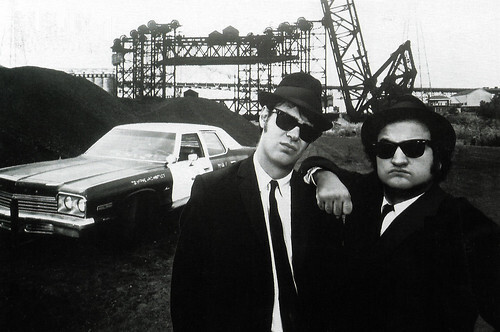
Italian postcard by Emilio Modric Editore, Ancona, no MX 018. Photo: Antony Baker. Dan Aykroyd and John Belushi in The Blues Brothers (John Landis, 1980).
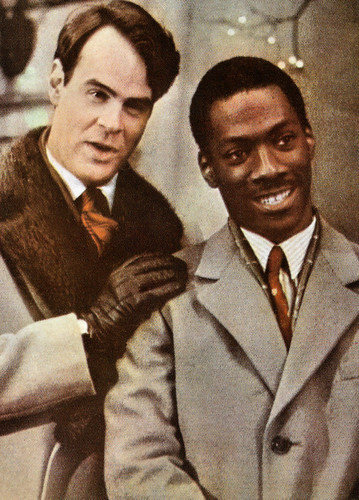
Romanian postcard by Casa Filmului Acin, no. C.P.C.S., 33150. Dan Aykroyd and Eddie Murphy in Trading Places (John Landis, 1983).
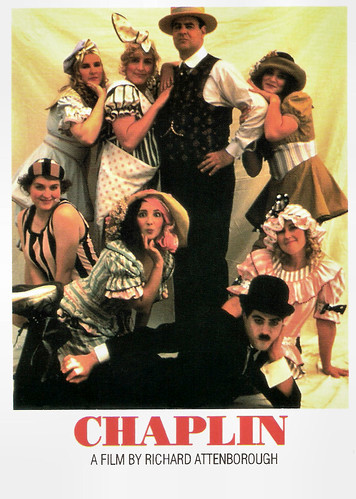
French postcard by Editions Mercuri, no. 817. Photo: Tri-Star Pictures. Publicity still for Chaplin (Richard Attenborough, 1992) with Dan Aykroyd as Mack Sennett and Robert Downey Jr. as Charlie Chaplin between Sennett's Bathing Beauties.
The Blues Brothers
Daniel Edward Aykroyd was born in 1952 at The Ottawa Hospital in Ottawa, Ontario. He grew up in Ottawa, Canada's capital, where his father, Samuel Cuthbert Peter Hugh Aykroyd, a civil engineer, worked as a policy adviser to Canadian Prime Minister Pierre Trudeau. His mother, Lorraine Hélène Marie (née Gougeon) was a secretary. His brother, Peter, was also an actor and is now a psychic researcher.
Dan attended St. Pius X and St. Patrick's high schools, and studied criminology and sociology at Carleton University, but dropped out before completing his degree. He worked as a comedian in various Canadian nightclubs and ran an after-hours speakeasy, Club 505, in Toronto for several years. At 17, Aykroyd was a member of the cast of the short-lived Canadian sketch comedy series The Hart and Lorne Terrific Hour with Lorne Michaels. In 1973, he was a member of the Second City comedy troupe in both Toronto and Chicago.
Aykroyd gained fame on the American late-night comedy show Saturday Night Live (SNL). He was originally hired as a writer for the show but became a part of the cast before the series premiered. He appeared on the show for its first four seasons, from 1975 to 1979 and brought a unique sensibility to the show, combining youth, unusual interests, talent as an impersonator, and an almost lunatic intensity. He was known for his impersonations of celebrities such as Jimmy Carter, Vincent Price , Richard Nixon, and others.
His recurring roles included Beldar, father of the Coneheads family; Fred Garvin – male prostitute; and high-bred but low-brow critic Leonard Pinth-Garnell. Aykroyd was a close friend and partner with fellow cast member John Belushi and shared some of the same sensibilities, Aykroyd was more reserved and less self-destructive. According to Aykroyd, their first meeting helped spark the Blues Brothers act. When they met in a club that Aykroyd frequented, he played a blues record in the background, and it stimulated a fascination with blues in Belushi.
It led to the creation of their Blues Brothers characters. Backed by such experienced professional R&B sidemen as lead guitarist Steve Cropper, saxman Lou Marini, trumpeter Alan Rubin, and bass guitarist Donald "Duck" Dunn, the Blues Brothers proved more than an SNL novelty. Taking off with the public as a legitimate musical act, they performed live gigs and in 1978 released the hit album 'Briefcase Full of Blues which eventually sold 3.5 million copies, and is one of the highest-selling blues albums of all time. The band was much further popularised in the film The Blues Brothers (John Landis, 1980) which Aykroyd co-wrote. A sequel, titled Blues Brothers 2000 (John Landis, 1998), featured John Goodman as Belushi's replacement.
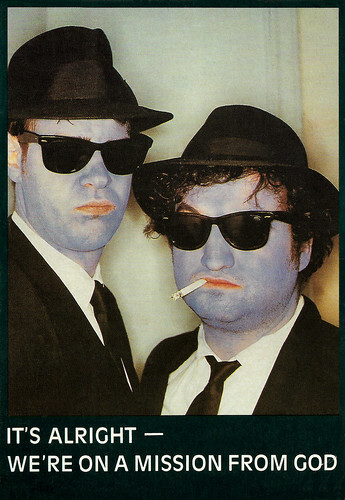
British postcard by Box Office, no. BO 1115. Dan Aykroyd and John Belushi in The Blues Brothers (John Landis, 1980). Caption: It's alright - We are on a mission from God.
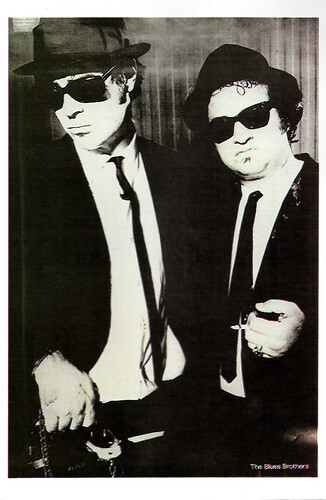
English postcard, no. REF 1009. Dan Aykroyd and John Belushi in The Blues Brothers (John Landis, 1980).
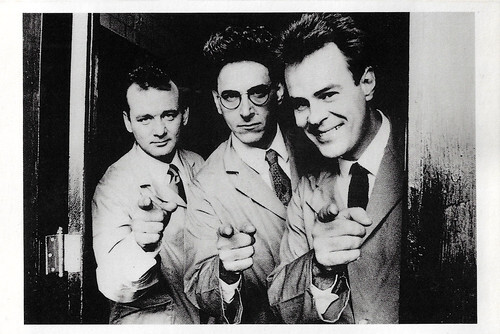
Vintage postcard by World Postcards Inc., no. X 170, 1989. Bill Murray, Harold Ramis and Dan Aykroyd in Ghostbusters (Ivan Reitman, 1984).
Ghostbusters
After leaving SNL, Dan Aykroyd starred in a number of films, mostly comedies, with uneven results both commercially and artistically. His first three American feature films all co-starred John Belushi. The first, 1941 (1979), directed by Steven Spielberg, was a box-office disappointment. The second, The Blues Brothers (1980), which he co-wrote with director John Landis, was a massive hit. The third, Neighbors (John G. Avildsen, 1981) had mixed critical reactions but was another box-office hit.
One of his best-received performances was as a blueblood-turned-wretch in the comedy Trading Places (John Landis, 1983), in which he co-starred with fellow SNL alumnus Eddie Murphy and Jamie Lee Curtis. Aykroyd played the snobbish investor Louis Winthorpe III and Murphy the wily street con artist Billy Ray Valentine find their positions reversed as part of a bet by two callous millionaires, played by Don Ameche and Ralph Bellamy.
In the early 1980s, Aykroyd began work on a script for the film that eventually became Ghostbusters, inspired by his fascination with parapsychology and his belief in ghosts and their busting. The script initially included a much greater fantasy element, including time travel, but this was toned down substantially through work on the script with co-writer Harold Ramis and director Ivan Reitman. Aykroyd originally wrote the role of Dr. Peter Venkman with Belushi in mind but rewrote it for Bill Murray after Belushi's death. Ghostbusters (Ivan Reitman, 1984) became a huge success for Aykroyd, who also appeared as one of the lead actors. The film earned nearly US$300 million on a US$30 million budget.
Aykroyd's next major film role was in the spy comedy film Spies Like Us (John Landis, 1985, which was co-conceived and co-written by Aykroyd. The other lead was again intended for Belushi but was instead given to SNL alumnus Chevy Chase. Dragnet (Tom Mankiewicz, 1987), in which Aykroyd co-starred with Tom Hanks and which he co-wrote, was both a homage and a satire of the classic TV series Dragnet (1951-1959) starring Jack Webb as Sergeant Joe Friday. Aykroyd played Sgt. Joe Friday as a police officer whose law-and-order attitude is in 1987 at odds with modern sensibilities.
Aykroyd appeared in five films released in 1988, all of them critical and commercial failures. The next year, a sequel to Ghostbusters was released, Ghostbusters II (Ivan Reitman, 1989). Initially, Aykroyd and the other co-creators were reluctant to make another Ghostbusters film but succumbed to pressure from the film's studio, Columbia Pictures. The film, while considered inferior to the original, was another big hit, earning US$215 million. Aykroyd was nominated for an Academy Award for Best Supporting Actor for Driving Miss Daisy (Bruce Beresford, 1989), starring Morgan Freeman and Jessica Tandy.
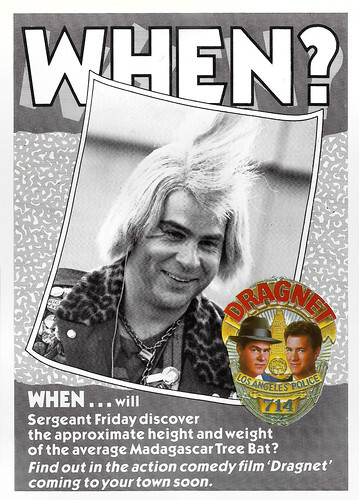
Vintage postcard. Dan Aykroyd in Dragnet (Tom Mankiewicz, 1987) with Tom Hanks. Caption: When? When... will Sergeant Friday discover the approximate height and weight of the average Madagascar Tree Bat? Find out in the action comedy film 'Dragnet' coming to your town soon.
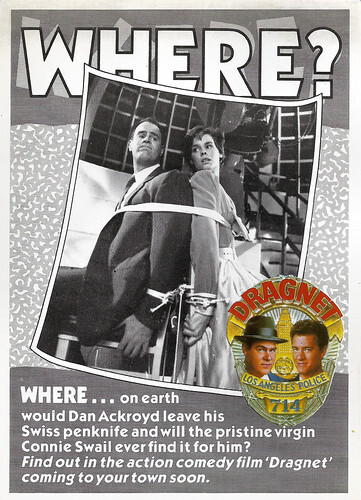
Vintage postcard. Dan Aykroyd and Alexandra Paul in Dragnet (Tom Mankiewicz, 1987) with Tom Hanks. Caption: Where... on earth would Dan Aykroyd leave his Swiss penknife and will the pristine virgin Connie Swail ever find it for him? Find out in the action comedy film 'Dragnet' coming to your town soon.
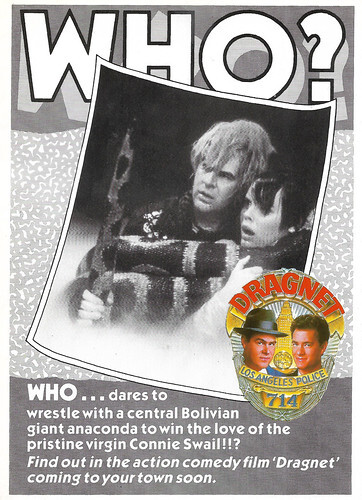
Vintage postcard. Dan Aykroyd and Alexandra Paul in Dragnet (Tom Mankiewicz, 1987) with Tom Hanks. Caption: Who? Who... dares to wrestle with a central Bolivian giant anaconda to win the love of the pristine virgin Connie Swail!!? Find out in the action comedy film 'Dragnet' coming to your town soon.
Ghostbusters: Afterlife
Dan Aykroyd's directorial debut was Nothing but Trouble (Dan Aykroyd, 1991) starring Demi Moore, Chevy Chase, John Candy, and Aykroyd, sporting a bulbous prosthetic nose. The film was a critical and box-office flop. Aykroyd's other films in the 1990s were mostly similarly poorly received, including Coneheads(Steve Barron, 1993) which was also based on an SNL skit, Exit to Eden (Garry Marshall, 1994), Blues Brothers 2000 (John Landis, 1998), and Getting Away with Murder (Harvey Miller, 1996).
Three exceptions were My Girl (Howard Zieff, 1991), which starred Jamie Lee Curtis and Macaulay Culkin, Tommy Boy (Peter Segal, 1995), and Grosse Pointe Blank (George Armitage, 1997), in which Aykroyd had a well-received role as a rival hitman. In 2001, he starred in the Woody Allen film The Curse of the Jade Scorpion.
Most of his film roles since then have tended to be small character parts in big-budget productions, such as a signals analyst in Pearl Harbor (Michael Bay, 2001) and a neurologist in 50 First Dates (Peter Segal, 2004). In 2009, Aykroyd and Ramis wrote and appeared in Ghostbusters: The Video Game (David Wheeler, Blade Zavier, 2009), which also featured Bill Murray. In 2010, he played the voice of the title character in the live-action/CGI-animated film Yogi Bear (Eric Brevig, 2010). That same year, Aykroyd and Chevy Chase guest-starred in the Family Guy episode 'Spies Reminiscent of Us', a homage to Spies Like Us.
Aykroyd was one of the executive producers of Ghostbusters (Paul Feig, 2016), a long-discussed reboot of the Ghostbusters franchise. Aykroyd also had a cameo appearance in the film. In 2021 he reprised his role of Dr. Ray Stantz in Ghostbusters: Afterlife (Jason Reitman, 2021). Though Sony has not confirmed any further sequels to Afterlife, Aykroyd expressed interest in having the surviving three actors of the original Ghostbusters team continue to reprise their roles for as many sequels as possible while they were alive.
Dan Aykroyd was briefly engaged to actress Carrie Fisher, proposing to her on the set of The Blues Brothers. In the film, she appeared as the jilted girlfriend of John Belushi 's character Jake Blues. Their engagement ended when she reconciled with her former boyfriend, musician Paul Simon. In 1983, Ackroyd married actress Donna Dixon. The couple met on the set of Doctor Detroit (Michael Pressman, 1983) and appeared together in four additional films: Twilight Zone: The Movie (John Landis, a.o., 1983); Spies Like Us (John Landis, 1985); The Couch Trip (Michael Ritchie, 1988); and Exit to Eden (Garry Marshall, 1994). Together, they have three daughters, Belle, Stella and Danielle Aykroyd, who is known by her stage name, Vera Sola. The couple announced in 2022 that they were separating after 39 years of marriage, but would remain legally married. Dan received an honorary Doctorate from Carleton University in 1994 and was made a Member of the Order of Canada in 1998.
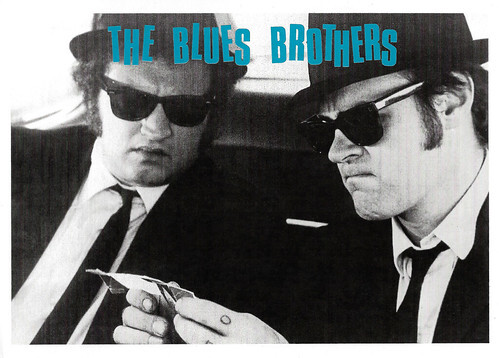
British postcard by Heroes, London, no. SPC 2172. Dan Aykroyd and John Belushi in The Blues Brothers (John Landis, 1980).
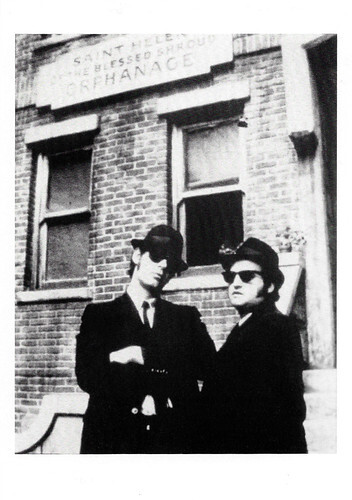
British postcard by Palm Pictures, no. C 26. Photo: Universal. Dan Aykroyd and John Belushi in The Blues Brothers (John Landis, 1980). Caption: Blues Brothers "Saint Helen".
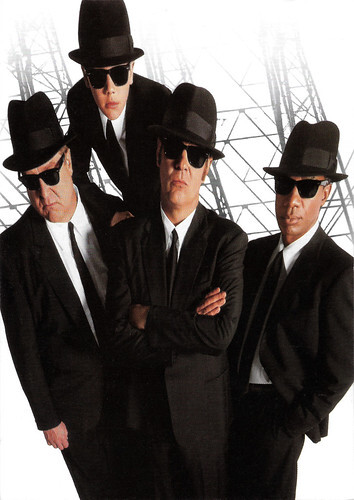
American postcard by Universal City Studio Productions, Inc., 1997. Sponsored by Ray-Ban. Photo: United International Pictures (UIP) / Universal. John Goodman, J. Evan Bonifant, Dan Aykroyd and Joe Morton in Blues Brothers 2000 (John Landis, 1998).
Sources: (IMDb), Wikipedia (English, German and Dutch), and .

Italian postcard by Emilio Modric Editore, Ancona, no MX 018. Photo: Antony Baker. Dan Aykroyd and John Belushi in The Blues Brothers (John Landis, 1980).

Romanian postcard by Casa Filmului Acin, no. C.P.C.S., 33150. Dan Aykroyd and Eddie Murphy in Trading Places (John Landis, 1983).

French postcard by Editions Mercuri, no. 817. Photo: Tri-Star Pictures. Publicity still for Chaplin (Richard Attenborough, 1992) with Dan Aykroyd as Mack Sennett and Robert Downey Jr. as Charlie Chaplin between Sennett's Bathing Beauties.
The Blues Brothers
Daniel Edward Aykroyd was born in 1952 at The Ottawa Hospital in Ottawa, Ontario. He grew up in Ottawa, Canada's capital, where his father, Samuel Cuthbert Peter Hugh Aykroyd, a civil engineer, worked as a policy adviser to Canadian Prime Minister Pierre Trudeau. His mother, Lorraine Hélène Marie (née Gougeon) was a secretary. His brother, Peter, was also an actor and is now a psychic researcher.
Dan attended St. Pius X and St. Patrick's high schools, and studied criminology and sociology at Carleton University, but dropped out before completing his degree. He worked as a comedian in various Canadian nightclubs and ran an after-hours speakeasy, Club 505, in Toronto for several years. At 17, Aykroyd was a member of the cast of the short-lived Canadian sketch comedy series The Hart and Lorne Terrific Hour with Lorne Michaels. In 1973, he was a member of the Second City comedy troupe in both Toronto and Chicago.
Aykroyd gained fame on the American late-night comedy show Saturday Night Live (SNL). He was originally hired as a writer for the show but became a part of the cast before the series premiered. He appeared on the show for its first four seasons, from 1975 to 1979 and brought a unique sensibility to the show, combining youth, unusual interests, talent as an impersonator, and an almost lunatic intensity. He was known for his impersonations of celebrities such as Jimmy Carter, Vincent Price , Richard Nixon, and others.
His recurring roles included Beldar, father of the Coneheads family; Fred Garvin – male prostitute; and high-bred but low-brow critic Leonard Pinth-Garnell. Aykroyd was a close friend and partner with fellow cast member John Belushi and shared some of the same sensibilities, Aykroyd was more reserved and less self-destructive. According to Aykroyd, their first meeting helped spark the Blues Brothers act. When they met in a club that Aykroyd frequented, he played a blues record in the background, and it stimulated a fascination with blues in Belushi.
It led to the creation of their Blues Brothers characters. Backed by such experienced professional R&B sidemen as lead guitarist Steve Cropper, saxman Lou Marini, trumpeter Alan Rubin, and bass guitarist Donald "Duck" Dunn, the Blues Brothers proved more than an SNL novelty. Taking off with the public as a legitimate musical act, they performed live gigs and in 1978 released the hit album 'Briefcase Full of Blues which eventually sold 3.5 million copies, and is one of the highest-selling blues albums of all time. The band was much further popularised in the film The Blues Brothers (John Landis, 1980) which Aykroyd co-wrote. A sequel, titled Blues Brothers 2000 (John Landis, 1998), featured John Goodman as Belushi's replacement.

British postcard by Box Office, no. BO 1115. Dan Aykroyd and John Belushi in The Blues Brothers (John Landis, 1980). Caption: It's alright - We are on a mission from God.

English postcard, no. REF 1009. Dan Aykroyd and John Belushi in The Blues Brothers (John Landis, 1980).

Vintage postcard by World Postcards Inc., no. X 170, 1989. Bill Murray, Harold Ramis and Dan Aykroyd in Ghostbusters (Ivan Reitman, 1984).
Ghostbusters
After leaving SNL, Dan Aykroyd starred in a number of films, mostly comedies, with uneven results both commercially and artistically. His first three American feature films all co-starred John Belushi. The first, 1941 (1979), directed by Steven Spielberg, was a box-office disappointment. The second, The Blues Brothers (1980), which he co-wrote with director John Landis, was a massive hit. The third, Neighbors (John G. Avildsen, 1981) had mixed critical reactions but was another box-office hit.
One of his best-received performances was as a blueblood-turned-wretch in the comedy Trading Places (John Landis, 1983), in which he co-starred with fellow SNL alumnus Eddie Murphy and Jamie Lee Curtis. Aykroyd played the snobbish investor Louis Winthorpe III and Murphy the wily street con artist Billy Ray Valentine find their positions reversed as part of a bet by two callous millionaires, played by Don Ameche and Ralph Bellamy.
In the early 1980s, Aykroyd began work on a script for the film that eventually became Ghostbusters, inspired by his fascination with parapsychology and his belief in ghosts and their busting. The script initially included a much greater fantasy element, including time travel, but this was toned down substantially through work on the script with co-writer Harold Ramis and director Ivan Reitman. Aykroyd originally wrote the role of Dr. Peter Venkman with Belushi in mind but rewrote it for Bill Murray after Belushi's death. Ghostbusters (Ivan Reitman, 1984) became a huge success for Aykroyd, who also appeared as one of the lead actors. The film earned nearly US$300 million on a US$30 million budget.
Aykroyd's next major film role was in the spy comedy film Spies Like Us (John Landis, 1985, which was co-conceived and co-written by Aykroyd. The other lead was again intended for Belushi but was instead given to SNL alumnus Chevy Chase. Dragnet (Tom Mankiewicz, 1987), in which Aykroyd co-starred with Tom Hanks and which he co-wrote, was both a homage and a satire of the classic TV series Dragnet (1951-1959) starring Jack Webb as Sergeant Joe Friday. Aykroyd played Sgt. Joe Friday as a police officer whose law-and-order attitude is in 1987 at odds with modern sensibilities.
Aykroyd appeared in five films released in 1988, all of them critical and commercial failures. The next year, a sequel to Ghostbusters was released, Ghostbusters II (Ivan Reitman, 1989). Initially, Aykroyd and the other co-creators were reluctant to make another Ghostbusters film but succumbed to pressure from the film's studio, Columbia Pictures. The film, while considered inferior to the original, was another big hit, earning US$215 million. Aykroyd was nominated for an Academy Award for Best Supporting Actor for Driving Miss Daisy (Bruce Beresford, 1989), starring Morgan Freeman and Jessica Tandy.

Vintage postcard. Dan Aykroyd in Dragnet (Tom Mankiewicz, 1987) with Tom Hanks. Caption: When? When... will Sergeant Friday discover the approximate height and weight of the average Madagascar Tree Bat? Find out in the action comedy film 'Dragnet' coming to your town soon.

Vintage postcard. Dan Aykroyd and Alexandra Paul in Dragnet (Tom Mankiewicz, 1987) with Tom Hanks. Caption: Where... on earth would Dan Aykroyd leave his Swiss penknife and will the pristine virgin Connie Swail ever find it for him? Find out in the action comedy film 'Dragnet' coming to your town soon.

Vintage postcard. Dan Aykroyd and Alexandra Paul in Dragnet (Tom Mankiewicz, 1987) with Tom Hanks. Caption: Who? Who... dares to wrestle with a central Bolivian giant anaconda to win the love of the pristine virgin Connie Swail!!? Find out in the action comedy film 'Dragnet' coming to your town soon.
Ghostbusters: Afterlife
Dan Aykroyd's directorial debut was Nothing but Trouble (Dan Aykroyd, 1991) starring Demi Moore, Chevy Chase, John Candy, and Aykroyd, sporting a bulbous prosthetic nose. The film was a critical and box-office flop. Aykroyd's other films in the 1990s were mostly similarly poorly received, including Coneheads(Steve Barron, 1993) which was also based on an SNL skit, Exit to Eden (Garry Marshall, 1994), Blues Brothers 2000 (John Landis, 1998), and Getting Away with Murder (Harvey Miller, 1996).
Three exceptions were My Girl (Howard Zieff, 1991), which starred Jamie Lee Curtis and Macaulay Culkin, Tommy Boy (Peter Segal, 1995), and Grosse Pointe Blank (George Armitage, 1997), in which Aykroyd had a well-received role as a rival hitman. In 2001, he starred in the Woody Allen film The Curse of the Jade Scorpion.
Most of his film roles since then have tended to be small character parts in big-budget productions, such as a signals analyst in Pearl Harbor (Michael Bay, 2001) and a neurologist in 50 First Dates (Peter Segal, 2004). In 2009, Aykroyd and Ramis wrote and appeared in Ghostbusters: The Video Game (David Wheeler, Blade Zavier, 2009), which also featured Bill Murray. In 2010, he played the voice of the title character in the live-action/CGI-animated film Yogi Bear (Eric Brevig, 2010). That same year, Aykroyd and Chevy Chase guest-starred in the Family Guy episode 'Spies Reminiscent of Us', a homage to Spies Like Us.
Aykroyd was one of the executive producers of Ghostbusters (Paul Feig, 2016), a long-discussed reboot of the Ghostbusters franchise. Aykroyd also had a cameo appearance in the film. In 2021 he reprised his role of Dr. Ray Stantz in Ghostbusters: Afterlife (Jason Reitman, 2021). Though Sony has not confirmed any further sequels to Afterlife, Aykroyd expressed interest in having the surviving three actors of the original Ghostbusters team continue to reprise their roles for as many sequels as possible while they were alive.
Dan Aykroyd was briefly engaged to actress Carrie Fisher, proposing to her on the set of The Blues Brothers. In the film, she appeared as the jilted girlfriend of John Belushi 's character Jake Blues. Their engagement ended when she reconciled with her former boyfriend, musician Paul Simon. In 1983, Ackroyd married actress Donna Dixon. The couple met on the set of Doctor Detroit (Michael Pressman, 1983) and appeared together in four additional films: Twilight Zone: The Movie (John Landis, a.o., 1983); Spies Like Us (John Landis, 1985); The Couch Trip (Michael Ritchie, 1988); and Exit to Eden (Garry Marshall, 1994). Together, they have three daughters, Belle, Stella and Danielle Aykroyd, who is known by her stage name, Vera Sola. The couple announced in 2022 that they were separating after 39 years of marriage, but would remain legally married. Dan received an honorary Doctorate from Carleton University in 1994 and was made a Member of the Order of Canada in 1998.

British postcard by Heroes, London, no. SPC 2172. Dan Aykroyd and John Belushi in The Blues Brothers (John Landis, 1980).

British postcard by Palm Pictures, no. C 26. Photo: Universal. Dan Aykroyd and John Belushi in The Blues Brothers (John Landis, 1980). Caption: Blues Brothers "Saint Helen".

American postcard by Universal City Studio Productions, Inc., 1997. Sponsored by Ray-Ban. Photo: United International Pictures (UIP) / Universal. John Goodman, J. Evan Bonifant, Dan Aykroyd and Joe Morton in Blues Brothers 2000 (John Landis, 1998).
Sources: (IMDb), Wikipedia (English, German and Dutch), and .
Published on February 17, 2023 22:00
February 16, 2023
Madge Evans
Lovely Madge Evans (1909-1981) was an American stage and film actress, who often played the 'nice' girl in Hollywood films of the 1930s. She began her career as a child performer and model, starting with Fairy Soap commercials at the age of two.
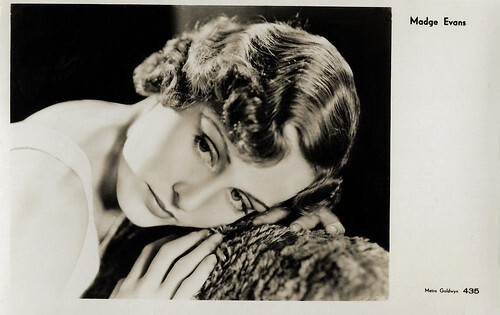
Dutch postcard, no. 435. Photo: Metro-Goldwyn-Mayer (M.G.M.). Sent by mail in 1934.
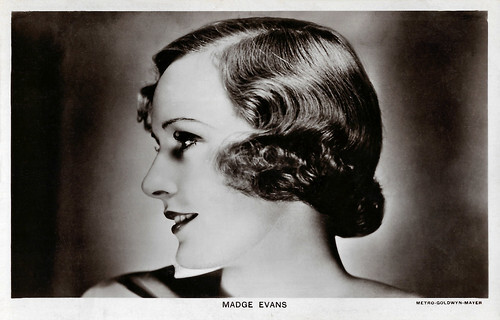
British postcard in the Picturegoer Series, London, 137a. Photo: Metro-Goldwyn-Mayer (M.G.M.).
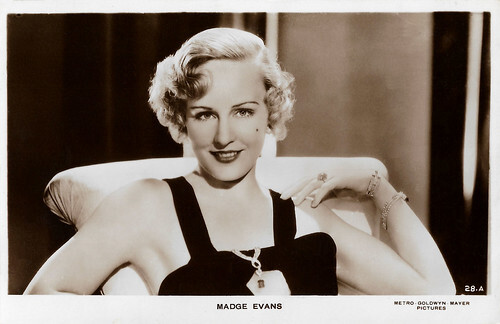
British Real Photograph postcard, no. 28. A. Photo: Metro-Goldwyn-Mayer (M.G.M.).
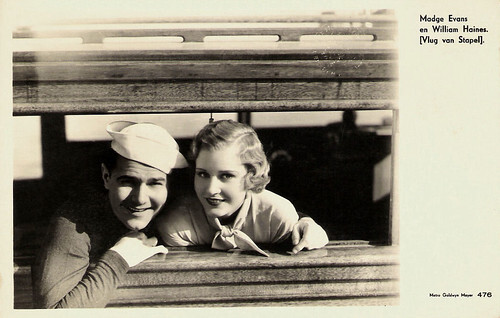
Dutch postcard, no. 476. Photo: Metro-Goldwyn-Mayer. William Haines and Madge Evans in Fast Life (Harry A. Pollard, Sam Wood, both uncredited, 1932), released in the Netherlands as Vlug van Stapel.
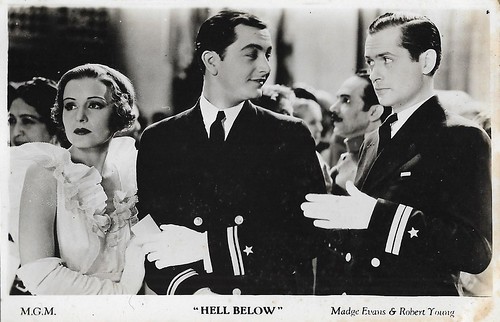
British postcard by Film Weekly. Photo: M.G.M. Madge Evans, Robert Young and Robert Montgomery in Hell Below (Jack Conway, 1933).
The Fairy Soap girl
Madge Evans was born Margherita Evans in 1909 in Manhattan. As an infant, she was featured in print ads as the 'Fairy Soap girl'. She made her professional debut at the age of six months, posing for artists. As a youth, her playmates included Robert Warwick, Holbrook Blinn, and Henry Hull. When she was four years old, Evans was featured in a series of child plays produced by William A. Brady. She worked at the old Long Island, New York movie studio.
Her success was immediate. Her mother loaned her daughter's name to a company for girl's hats. Evans posed in a mother and child tableau with Anita Stewart , then 16, for an Anheuser-Busch Brewing Company calendar, and as the little mountain girl in 'Heidi of the Alps'. At the age of eight in 1917, Evans appeared in the Broadway production of 'Peter Ibbetson' with John Barrymore , Constance Collier and Laura Hope Crews.
Evans' mother took her to England and Europe when she was 15. At 17, she returned to the stage and appeared as the ingenue in 'Daisy Mayme'. Some of her best work in plays came in productions of 'Dread', 'The Marquis', and 'The Conquering Male'. Her last appearance was in 'Philip Goes Forth' produced by George Kelley.
As a child film actress, Evans had quite a prolific career appearing in dozens of films, including The Sign of the Cross (Frederick A. Thomson, 1914) with Dustin Farnum, and The Seven Sisters (Sidney Olcott, 1915), with Marguerite Clark . The Seven Sisters (Sidney Olcott, 1915) had a large female ensemble that had been played on stage with Clark's rival Mary Pickford and Laurette Taylor in the cast.
Madge Evans was featured with Robert Warwick in Alias Jimmy Valentine (1915). At 14, she was the star of J. Stuart Blackton's rural melodrama On the Banks of the Wabash (1923). She co-starred with Richard Barthelmess in Classmates (1924).
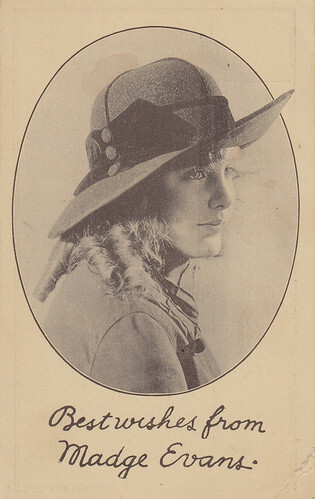
American promotion postcard for Madge Evans Hat for Little Ladies, Sold exclusively by Pfeifers, Little Rock, Ark. Front side. Collection: Marlene Pilaete.
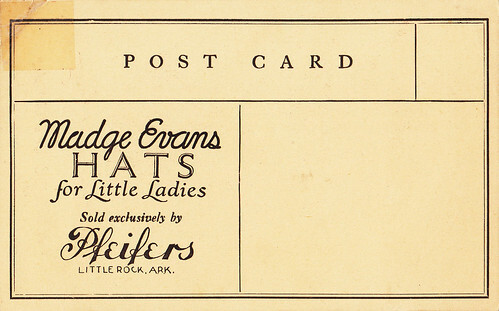
American promotion postcard for Madge Evans Hat for Little Ladies, Sold exclusively by Pfeifers, Little Rock, Ark. Back side. Collection: Marlene Pilaete.
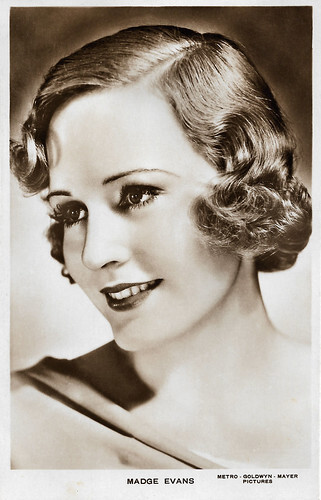
British postcard. Photo: Metro-Goldwyn-Mayer (M.G.M.).
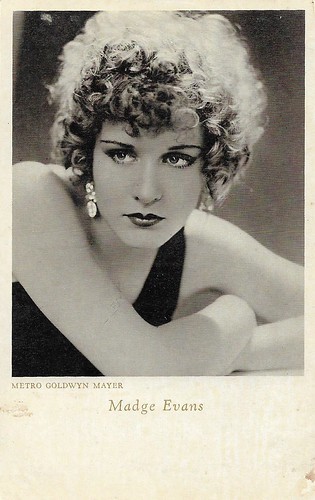
Italian postcard by Cinema-Illustrazione, Milano, Series 1, no. 10. Photo: Metro-Goldwyn-Mayer. Cinema Illustrazione was an Italian popular film journal that existed between 1926 and 1939.
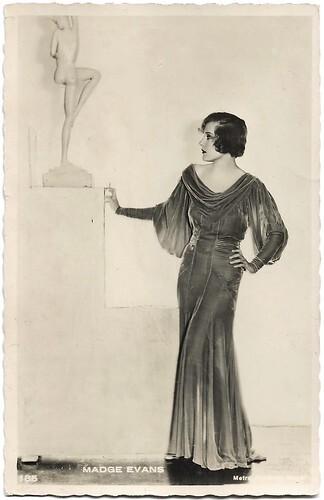
Dutch postcard by JosPe, Arnhem, no. 185. Photo: Metro-Goldwyn-Mayer.
Typical American girl roles
Madge Evans was working on stage when she signed with Metro Goldwyn Mayer in 1927. As in the theatre, she continued to play ingenue parts, often as the fiancé of the leading man. She played the love interest to both Al Jolson and Frank Morgan in the film Hallelujah, I'm a Bum (1933).
Working for MGM in the 1930s, she appeared as Lionel Barrymore 's daughter in Dinner at Eight (George Cukor, 1933), and as the dependable Agnes Wickfield in David Copperfield (George Cukor, 1935). In 1933, she starred with James Cagney in a melodrama entitled The Mayor of Hell (Archie Mayo, Michael Curtiz (uncredited), 1933), playing a pretty nurse who solicits the aid of a tough politician, played by Cagney.
Other notable films in which she appeared are Beauty for Sale (Richard Boleslawski, 1933), Fugitive Lovers (Richard Boleslawski, 1934), and Pennies From Heaven (Norman Z. McLeod, 1936) with Bing Crosby. I.S.Mowis at IMDb : "Many of her 'typical American girl' roles did not allow her to express aspects of the greater acting range she undoubtedly possessed. Too often she was cast as the 'nice girl' - and those rarely make much of a dramatic impact."
On the few occasions, she was assigned the role of 'other woman', such as the Helen Hayes-starrer What Every Woman Knows (Gregory La Cava, 1934), audiences found her character difficult to believe and disassociate from her all-round wholesome image. When her contract with MGM expired in 1937, Madge wound down her film career and, following her 1939 marriage, concentrated on being the wife of celebrated playwright Sidney Kingsley. She last appeared on stage in one of his plays, 'The Patriots', in 1943.
In 1960, for Evans' contribution to the motion picture industry, she was honoured with a star on the Hollywood Walk of Fame located at 1752 Vine Street. She was married to playwright Sidney Kingsley, best known for his plays 'Dead End' and 'Detective Story' which were turned into popular films. The couple owned a 250-acre (1,000,000 m2) estate in Oakland, New Jersey. Later, she worked in radio and television in New York City. Evans performed on the Philco Television Playhouse (1949–1950), Studio One (1954), Matinee Theater (1955), and The Alcoa Hour (1956). Madge Evans died at her home in Oakland, New Jersey from cancer in 1981, aged 71.
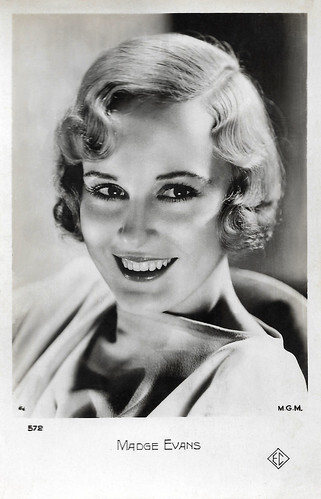
French postcard by Editions Chantal, Paris (EC), no. 572. Photo: M.G.M.
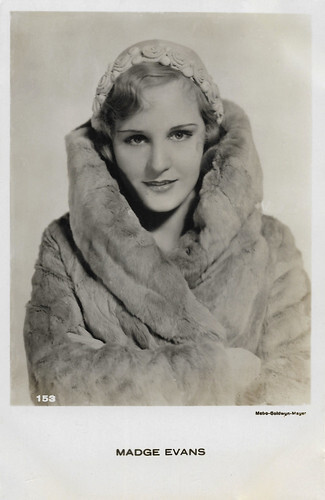
Dutch postcard by JosPe, Arnhem, no. 153. Photo: Metro-Goldwyn-Mayer (M.G.M.).
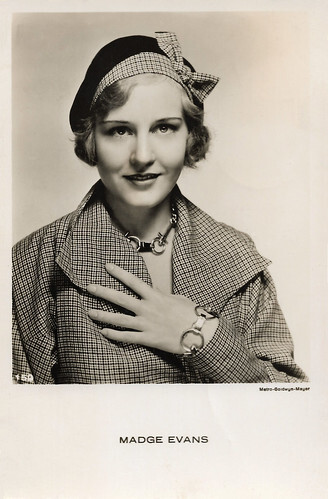
Dutch postcard, no. 159. Photo: Metro-Goldwyn-Mayer (M.G.M.). Sent by mail in 1932.
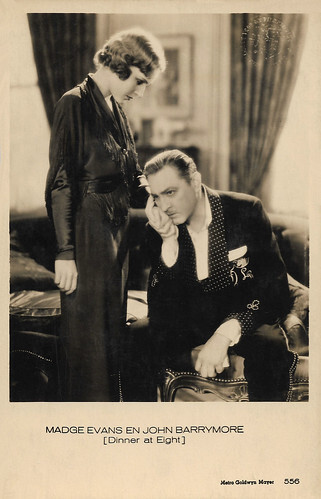
Dutch postcard, no. 556. Photo: M.G.M. Madge Evans and John Barrymore in Dinner at Eight (George Cukor, 1933).
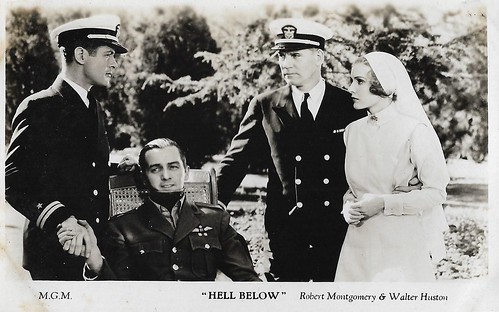
British postcard by Film Weekly. Photo: MGM. Robert Montgomery, Edwin Styles, Walter Huston, and Madge Evans in Hell Below (Jack Conway, 1933).
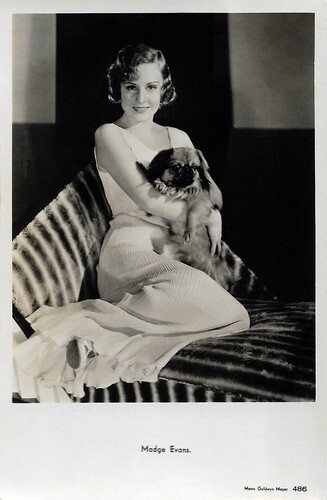
Dutch postcard, no. 486. Photo: Metro-Goldwyn-Mayer. Sent by mail in 1938.
Sources: (IMDb), Wikipedia and .

Dutch postcard, no. 435. Photo: Metro-Goldwyn-Mayer (M.G.M.). Sent by mail in 1934.

British postcard in the Picturegoer Series, London, 137a. Photo: Metro-Goldwyn-Mayer (M.G.M.).

British Real Photograph postcard, no. 28. A. Photo: Metro-Goldwyn-Mayer (M.G.M.).

Dutch postcard, no. 476. Photo: Metro-Goldwyn-Mayer. William Haines and Madge Evans in Fast Life (Harry A. Pollard, Sam Wood, both uncredited, 1932), released in the Netherlands as Vlug van Stapel.

British postcard by Film Weekly. Photo: M.G.M. Madge Evans, Robert Young and Robert Montgomery in Hell Below (Jack Conway, 1933).
The Fairy Soap girl
Madge Evans was born Margherita Evans in 1909 in Manhattan. As an infant, she was featured in print ads as the 'Fairy Soap girl'. She made her professional debut at the age of six months, posing for artists. As a youth, her playmates included Robert Warwick, Holbrook Blinn, and Henry Hull. When she was four years old, Evans was featured in a series of child plays produced by William A. Brady. She worked at the old Long Island, New York movie studio.
Her success was immediate. Her mother loaned her daughter's name to a company for girl's hats. Evans posed in a mother and child tableau with Anita Stewart , then 16, for an Anheuser-Busch Brewing Company calendar, and as the little mountain girl in 'Heidi of the Alps'. At the age of eight in 1917, Evans appeared in the Broadway production of 'Peter Ibbetson' with John Barrymore , Constance Collier and Laura Hope Crews.
Evans' mother took her to England and Europe when she was 15. At 17, she returned to the stage and appeared as the ingenue in 'Daisy Mayme'. Some of her best work in plays came in productions of 'Dread', 'The Marquis', and 'The Conquering Male'. Her last appearance was in 'Philip Goes Forth' produced by George Kelley.
As a child film actress, Evans had quite a prolific career appearing in dozens of films, including The Sign of the Cross (Frederick A. Thomson, 1914) with Dustin Farnum, and The Seven Sisters (Sidney Olcott, 1915), with Marguerite Clark . The Seven Sisters (Sidney Olcott, 1915) had a large female ensemble that had been played on stage with Clark's rival Mary Pickford and Laurette Taylor in the cast.
Madge Evans was featured with Robert Warwick in Alias Jimmy Valentine (1915). At 14, she was the star of J. Stuart Blackton's rural melodrama On the Banks of the Wabash (1923). She co-starred with Richard Barthelmess in Classmates (1924).

American promotion postcard for Madge Evans Hat for Little Ladies, Sold exclusively by Pfeifers, Little Rock, Ark. Front side. Collection: Marlene Pilaete.

American promotion postcard for Madge Evans Hat for Little Ladies, Sold exclusively by Pfeifers, Little Rock, Ark. Back side. Collection: Marlene Pilaete.

British postcard. Photo: Metro-Goldwyn-Mayer (M.G.M.).

Italian postcard by Cinema-Illustrazione, Milano, Series 1, no. 10. Photo: Metro-Goldwyn-Mayer. Cinema Illustrazione was an Italian popular film journal that existed between 1926 and 1939.

Dutch postcard by JosPe, Arnhem, no. 185. Photo: Metro-Goldwyn-Mayer.
Typical American girl roles
Madge Evans was working on stage when she signed with Metro Goldwyn Mayer in 1927. As in the theatre, she continued to play ingenue parts, often as the fiancé of the leading man. She played the love interest to both Al Jolson and Frank Morgan in the film Hallelujah, I'm a Bum (1933).
Working for MGM in the 1930s, she appeared as Lionel Barrymore 's daughter in Dinner at Eight (George Cukor, 1933), and as the dependable Agnes Wickfield in David Copperfield (George Cukor, 1935). In 1933, she starred with James Cagney in a melodrama entitled The Mayor of Hell (Archie Mayo, Michael Curtiz (uncredited), 1933), playing a pretty nurse who solicits the aid of a tough politician, played by Cagney.
Other notable films in which she appeared are Beauty for Sale (Richard Boleslawski, 1933), Fugitive Lovers (Richard Boleslawski, 1934), and Pennies From Heaven (Norman Z. McLeod, 1936) with Bing Crosby. I.S.Mowis at IMDb : "Many of her 'typical American girl' roles did not allow her to express aspects of the greater acting range she undoubtedly possessed. Too often she was cast as the 'nice girl' - and those rarely make much of a dramatic impact."
On the few occasions, she was assigned the role of 'other woman', such as the Helen Hayes-starrer What Every Woman Knows (Gregory La Cava, 1934), audiences found her character difficult to believe and disassociate from her all-round wholesome image. When her contract with MGM expired in 1937, Madge wound down her film career and, following her 1939 marriage, concentrated on being the wife of celebrated playwright Sidney Kingsley. She last appeared on stage in one of his plays, 'The Patriots', in 1943.
In 1960, for Evans' contribution to the motion picture industry, she was honoured with a star on the Hollywood Walk of Fame located at 1752 Vine Street. She was married to playwright Sidney Kingsley, best known for his plays 'Dead End' and 'Detective Story' which were turned into popular films. The couple owned a 250-acre (1,000,000 m2) estate in Oakland, New Jersey. Later, she worked in radio and television in New York City. Evans performed on the Philco Television Playhouse (1949–1950), Studio One (1954), Matinee Theater (1955), and The Alcoa Hour (1956). Madge Evans died at her home in Oakland, New Jersey from cancer in 1981, aged 71.

French postcard by Editions Chantal, Paris (EC), no. 572. Photo: M.G.M.

Dutch postcard by JosPe, Arnhem, no. 153. Photo: Metro-Goldwyn-Mayer (M.G.M.).

Dutch postcard, no. 159. Photo: Metro-Goldwyn-Mayer (M.G.M.). Sent by mail in 1932.

Dutch postcard, no. 556. Photo: M.G.M. Madge Evans and John Barrymore in Dinner at Eight (George Cukor, 1933).

British postcard by Film Weekly. Photo: MGM. Robert Montgomery, Edwin Styles, Walter Huston, and Madge Evans in Hell Below (Jack Conway, 1933).

Dutch postcard, no. 486. Photo: Metro-Goldwyn-Mayer. Sent by mail in 1938.
Sources: (IMDb), Wikipedia and .
Published on February 16, 2023 22:00
Paul van Yperen's Blog
- Paul van Yperen's profile
- 13 followers
Paul van Yperen isn't a Goodreads Author
(yet),
but they
do have a blog,
so here are some recent posts imported from
their feed.



